Telit Communications S p A GE866 Wireless module User Manual 1VV0301051 GE866 QUAD Hardware User Guide r2
Telit Communications S.p.A. Wireless module 1VV0301051 GE866 QUAD Hardware User Guide r2
User Manual

GE866-QUAD Hardware User
Guide
1VV0301051 Rev. 2 – 2014-04-07

GE866-DUAL Hardware User Guide
1VV0301051 Rev. 2 – 2014-04-07
7
Reproduction forbidden without written authorization from Telit Communications S.p.A. - All Rights
Reserved. Page 2 of 82
Mod. 0805 2011-07 Rev.2
APPLICABILITY TABLE
PRODUCT
GE866-QUAD

GE866-DUAL Hardware User Guide
1VV0301051 Rev. 2 – 2014-04-07
7
Reproduction forbidden without written authorization from Telit Communications S.p.A. - All Rights
Reserved. Page 3 of 82
Mod. 0805 2011-07 Rev.2
SPECIFICATIONS SUBJECT TO CHANGE WITHOUT NOTICE
Notice
While reasonable efforts have been made to assure the accuracy of this document, Telit
assumes no liability resulting from any inaccuracies or omissions in this document, or from
use of the information obtained herein. The information in this document has been carefully
checked and is believed to be entirely reliable. However, no responsibility is assumed for
inaccuracies or omissions. Telit reserves the right to make changes to any products described
herein and reserves the right to revise this document and to make changes from time to time
in content hereof with no obligation to notify any person of revisions or changes. Telit does
not assume any liability arising out of the application or use of any product, software, or
circuit described herein; neither does it convey license under its patent rights or the rights of
others.
It is possible that this publication may contain references to, or information about Telit
products (machines and programs), programming, or services that are not announced in your
country. Such references or information must not be construed to mean that Telit intends to
announce such Telit products, programming, or services in your country.
Copyrights
This instruction manual and the Telit products described in this instruction manual may be,
include or describe copyrighted Telit material, such as computer programs stored in
semiconductor memories or other media. Laws in the Italy and other countries preserve for
Telit and its licensors certain exclusive rights for copyrighted material, including the
exclusive right to copy, reproduce in any form, distribute and make derivative works of the
copyrighted material. Accordingly, any copyrighted material of Telit and its licensors
contained herein or in the Telit products described in this instruction manual may not be
copied, reproduced, distributed, merged or modified in any manner without the express
written permission of Telit. Furthermore, the purchase of Telit products shall not be deemed
to grant either directly or by implication, estoppel, or otherwise, any license under the
copyrights, patents or patent applications of Telit, as arises by operation of law in the sale of a
product.
Computer Software Copyrights
The Telit and 3rd Party supplied Software (SW) products described in this instruction manual
may include copyrighted Telit and other 3rd Party supplied computer programs stored in
semiconductor memories or other media. Laws in the Italy and other countries preserve for
Telit and other 3rd Party supplied SW certain exclusive rights for copyrighted computer
programs, including the exclusive right to copy or reproduce in any form the copyrighted
computer program. Accordingly, any copyrighted Telit or other 3rd Party supplied SW
computer programs contained in the Telit products described in this instruction manual may
not be copied (reverse engineered) or reproduced in any manner without the express written
permission of Telit or the 3rd Party SW supplier. Furthermore, the purchase of Telit products
shall not be deemed to grant either directly or by implication, estoppel, or otherwise, any
license under the copyrights, patents or patent applications of Telit or other 3rd Party supplied
SW, except for the normal non-exclusive, royalty free license to use that arises by operation
of law in the sale of a product.

GE866-DUAL Hardware User Guide
1VV0301051 Rev. 2 – 2014-04-07
7
Reproduction forbidden without written authorization from Telit Communications S.p.A. - All Rights
Reserved. Page 4 of 82
Mod. 0805 2011-07 Rev.2
Usage and Disclosure Restrictions
License Agreements
The software described in this document is the property of Telit and its licensors. It is
furnished by express license agreement only and may be used only in accordance with the
terms of such an agreement.
Copyrighted Materials
Software and documentation are copyrighted materials. Making unauthorized copies is
prohibited by law. No part of the software or documentation may be reproduced, transmitted,
transcribed, stored in a retrieval system, or translated into any language or computer language,
in any form or by any means, without prior written permission of Telit
High Risk Materials
Components, units, or third-party products used in the product described herein are NOT
fault-tolerant and are NOT designed, manufactured, or intended for use as on-line control
equipment in the following hazardous environments requiring fail-safe controls: the operation
of Nuclear Facilities, Aircraft Navigation or Aircraft Communication Systems, Air Traffic
Control, Life Support, or Weapons Systems (High Risk Activities"). Telit and its supplier(s)
specifically disclaim any expressed or implied warranty of fitness for such High Risk
Activities.
Trademarks
TELIT and the Stylized T Logo are registered in Trademark Office. All other product or
service names are the property of their respective owners.
Copyright © Telit Communications S.p.A. 2014

GE866-DUAL Hardware User Guide
1VV0301051 Rev. 2 – 2014-04-07
7
Reproduction forbidden without written authorization from Telit Communications S.p.A. - All Rights
Reserved. Page 5 of 82
Mod. 0805 2011-07 Rev.2
Contents
1.
Introduction ................................................. 8
1.1.
Scope ..................................................... 8
1.2.
Audience .................................................. 8
1.3.
Contact Information, Support .............................. 8
1.4.
Document Organization ..................................... 9
1.5.
Text Conventions ......................................... 10
1.6.
Related Documents ........................................ 10
2.
Overview .................................................... 11
3.
GE866-QUAD Mechanical Dimensions ............................ 12
4.
GE866-QUAD module connections ............................... 13
4.1.
PIN-OUT .................................................. 13
4.2.
Pin Layout ............................................... 16
5.
Hardware Commands ........................................... 17
5.1.
Auto-Turning ON the GE866-QUAD ........................... 17
5.2.
Turning OFF the GE866-QUAD ............................... 19
5.3.
Resetting the GE866-QUAD ................................. 21
5.3.1. Hardware Unconditional restart ............................. 21
6.
Power Supply ................................................ 24
6.1.
Power Supply Requirements ................................ 24
6.2.
Power Consumption ........................................ 26
6.3.
General Design Rules ..................................... 27
6.3.1. Electrical Design Guidelines ............................... 27
6.3.2. Thermal Design Guidelines .................................. 30
6.3.3. Power Supply PCB layout Guidelines ......................... 32
7.
Antenna ..................................................... 34
7.1.
GSM Antenna Requirements ................................. 34
7.1.1. GE866-QUAD Antenna – PCB line Guidelines ................... 34
7.2.
PCB Design Guidelines .................................... 37
7.2.1. Transmission line design ................................... 37
7.2.2. Transmission line measurements ............................. 38

GE866-DUAL Hardware User Guide
1VV0301051 Rev. 2 – 2014-04-07
7
Reproduction forbidden without written authorization from Telit Communications S.p.A. - All Rights
Reserved. Page 6 of 82
Mod. 0805 2011-07 Rev.2
7.3.
GSM Antenna - installation Guidelines .................... 39
8.
Logic levels specifications ................................. 40
8.1.
Reset signal ............................................. 41
9.
Serial Ports ................................................ 43
9.1.
Modem Serial Port ........................................ 43
9.2.
RS232 levels translation ................................. 46
10.
Audio Section Overview ...................................... 48
10.1.
MIC Connection ......................................... 48
10.2.
EAR Connection ......................................... 48
10.3.
Electrical Characteristics ............................. 50
10.3.1. Input lines .............................................. 50
10.3.2. Output lines ............................................. 51
11.
General Purpose I/O ......................................... 52
11.1.
GPIO Logic Levels ...................................... 53
11.2.
Using a GPIO Pad as INPUT .............................. 54
11.3.
Using a GPIO Pad as OUTPUT ............................. 54
11.4.
Using the RF Transmission Control GPIO4 ................ 54
11.5.
Using the RFTXMON Output GPIO5 ......................... 55
11.6.
Using the ALARM/BUZZER output GPIO6 .................... 55
11.7.
Magnetic Buzzer Concepts ............................... 57
11.7.1. Short Description ........................................ 57
11.7.2. Frequency Behaviour ...................................... 58
11.7.3. Power Supply Influence ................................... 58
11.7.4. Working Current Influence ................................ 58
11.8.
STAT LED Indication of network service availability .... 59
11.9.
SIMIN detect function .................................. 60
11.10.
RTC Bypass out ......................................... 60
11.11.
SIM Holder Implementation .............................. 60
12.
DAC and ADC section ......................................... 61
12.1.
DAC Converter .......................................... 61
12.1.1. Description .............................................. 61
12.1.2. Enabling DAC ............................................. 61

GE866-DUAL Hardware User Guide
1VV0301051 Rev. 2 – 2014-04-07
7
Reproduction forbidden without written authorization from Telit Communications S.p.A. - All Rights
Reserved. Page 7 of 82
Mod. 0805 2011-07 Rev.2
12.1.3. Low Pass Filter Example .................................. 62
12.2.
ADC Converter .......................................... 62
12.2.1. Description .............................................. 62
12.2.2. Using ADC Converter ...................................... 63
13.
Mounting the GE866 on your Board ............................ 64
13.1.
General ................................................ 64
13.2.
Module finishing & dimensions .......................... 64
13.3.
Recommended foot print for the application (dimensions in
mm): 65
13.4.
Stencil ................................................ 66
13.5.
PCB pad design ......................................... 66
13.6.
Recommendations for PCB pad dimensions (mm): ........... 67
13.7.
Solder paste ........................................... 69
13.8.
GE866 Solder reflow .................................... 70
14.
Packing system .............................................. 72
14.1.
Packing on reel ........................................ 72
14.2.
Packing on tray ........................................ 73
14.3.
Moisture sensibility ................................... 74
15.
Conformity Assessment Issues ...................................... 75
15.1.
GE866-QUAD ............................................. 77
16.
Safety Recommendations ...................................... 81
17.
Document History ............................................ 82

GE866-DUAL Hardware User Guide
1VV0301051 Rev. 2 – 2014-04-07
7
Reproduction forbidden without written authorization from Telit Communications S.p.A. - All Rights
Reserved. Page 8 of 82
Mod. 0805 2011-07 Rev.2
1. Introduction
1.1. Scope
The aim of this document is the description of some hardware
solutions useful for developing a product with the Telit
GE866-QUAD module.
1.2. Audience
This document is intended for Telit customers, who are
integrators, about to implement their applications using our
GE866-QUAD modules.
1.3. Contact Information, Support
For general contact, technical support, to report
documentation errors and to order manuals, contact Telit
Technical Support Center (TTSC) at:
TS-EMEA@telit.com
TS-NORTHAMERICA@telit.com
TS-LATINAMERICA@telit.com
TS-APAC@telit.com
Alternatively, use:
http://www.telit.com/en/products/technical-support-
center/contact.php
For detailed information about where you can buy the Telit
modules or for recommendations on accessories and components
visit:
http://www.telit.com
To register for product news and announcements or for product
questions contact Telit Technical Support Center (TTSC).
Our aim is to make this guide as helpful as possible. Keep us
informed of your comments and suggestions for improvements.
Telit appreciates feedback from the users of our information.

GE866-DUAL Hardware User Guide
1VV0301051 Rev. 2 – 2014-04-07
7
Reproduction forbidden without written authorization from Telit Communications S.p.A. - All Rights
Reserved. Page 9 of 82
Mod. 0805 2011-07 Rev.2
1.4. Document Organization
This document contains the following chapters:
Chapter 1: “Introduction” provides a scope for this document,
target audience, contact and support information, and text
conventions.
Chapter 2: “Overview” provides an overview of the document.
Chapter 3: “GE866-QUAD Mechanical Dimensions”
Chapter 4: “GE866-QUAD Module Connections” deals with the pin
out configuration and layout.
Chapter 5: “Hardware Commands” How to operate on the module
via hardware.
Chapter 6: “Power supply” Power supply requirements and
general design rules.
Chapter 7: “Antenna” The antenna connection and board layout
design are the most important parts in the full product
design.
Chapter 8: “Logic Level specifications” Specific values
adopted in the implementation of logic levels for this module.
Chapter 9: “Serial ports” The serial port on the Telit GE866-
QUAD is the core of the interface between the module and OEM
hardware
Chapter 10: “Audio Section overview” Refers to the audio
blocks of the Base Band Chip of the GE866-QUAD Telit Modules.
Chapter 11: “General Purpose I/O” How the general purpose I/O
pads can be configured.
Chapter 12 “DAC and ADC Section” Deals with these two kind of
converters.
Chapter 13: “Mounting the GE866 on your Board” Recommendations
and specifics on how to mount the module on the user’s board.
Chapter 14: “Packing system” Recommendations and specifics on
how the system is packaged.
Chapter 15: “Safety Recommendations” Recommendations and
specifics on how the system is packaged.
Chapter 16: “Document History” Holds all document changes
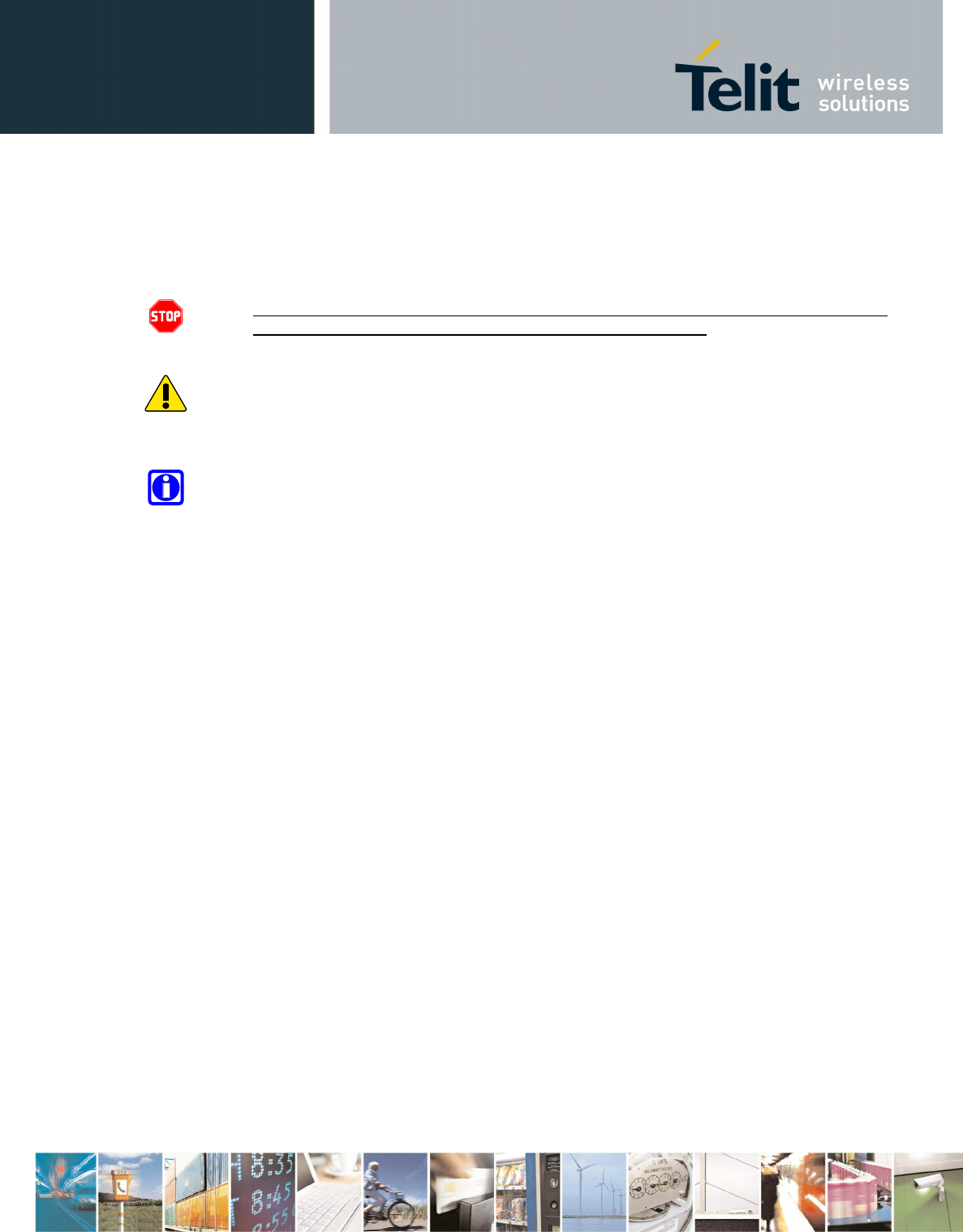
GE866-DUAL Hardware User Guide
1VV0301051 Rev. 2 – 2014-04-07
7
Reproduction forbidden without written authorization from Telit Communications S.p.A. - All Rights
Reserved. Page 10 of 82
Mod. 0805 2011-07 Rev.2
1.5. Text Conventions
Danger – This information MUST be followed or catastrophic
equipment failure or bodily injury may occur.
Caution or Warning – Alerts the user to important points about
integrating the module, if these points are not followed, the
module and end user equipment may fail or malfunction.
Tip or Information – Provides advice and suggestions that may
be useful when integrating the module.
All dates are in ISO 8601 format, i.e. YYYY-MM-DD.
1.6. Related Documents
• Telit GSM/GPRS Family Software User Guide, 1vv0300784
• Audio settings application note , 80000NT10007a
• Digital Voice Interface Application Note, 80000NT10004a
• GE866-QUAD Product description, 80416ST10122A
• SIM Holder Design Guides, 80000NT10001a
• AT Commands Reference Guide, 80000ST10025a
• Telit EVK2 User Guide, 1vv0300704

GE866-DUAL Hardware User Guide
1VV0301051 Rev. 2 – 2014-04-07
7
Reproduction forbidden without written authorization from Telit Communications S.p.A. - All Rights
Reserved. Page 11 of 82
Mod. 0805 2011-07 Rev.2
2. Overview
The aim of this document is the description of some hardware
solutions useful for developing a product with the Telit
GE866-QUAD module.
In this document all the basic functions of a mobile phone
will be taken into account; for each one of them a proper
hardware solution will be suggested and eventually the wrong
solutions and common errors to be avoided will be evidenced.
Obviously this document cannot embrace all hardware solutions
and products that may be designed. Avoiding the wrong
solutions shall be considered as mandatory. While the
suggested hardware configurations shall not be considered
mandatory, the information given shall be used as a guide and
a starting point for properly developing your product with the
Telit GE866-QUAD module. For further hardware details that may
not be explained in this document refer to the Telit GE866-
QUAD Product Description document where all the hardware
information is reported.
NOTE:
The integration of the GSM/GPRS GE866-QUAD cellular module
within user application shall be done according to the design
rules described in this manual.
The information presented in this document is believed to be
accurate and reliable. However, no responsibility is assumed
by Telit Communications S.p.A. for its use, nor any
infringement of patents or other rights of third parties which
may result from its use. No license is granted by implication
or otherwise under any patent rights of Telit Communications
S.p.A. other than for circuitry embodied in Telit products.
This document is subject to change without notice.
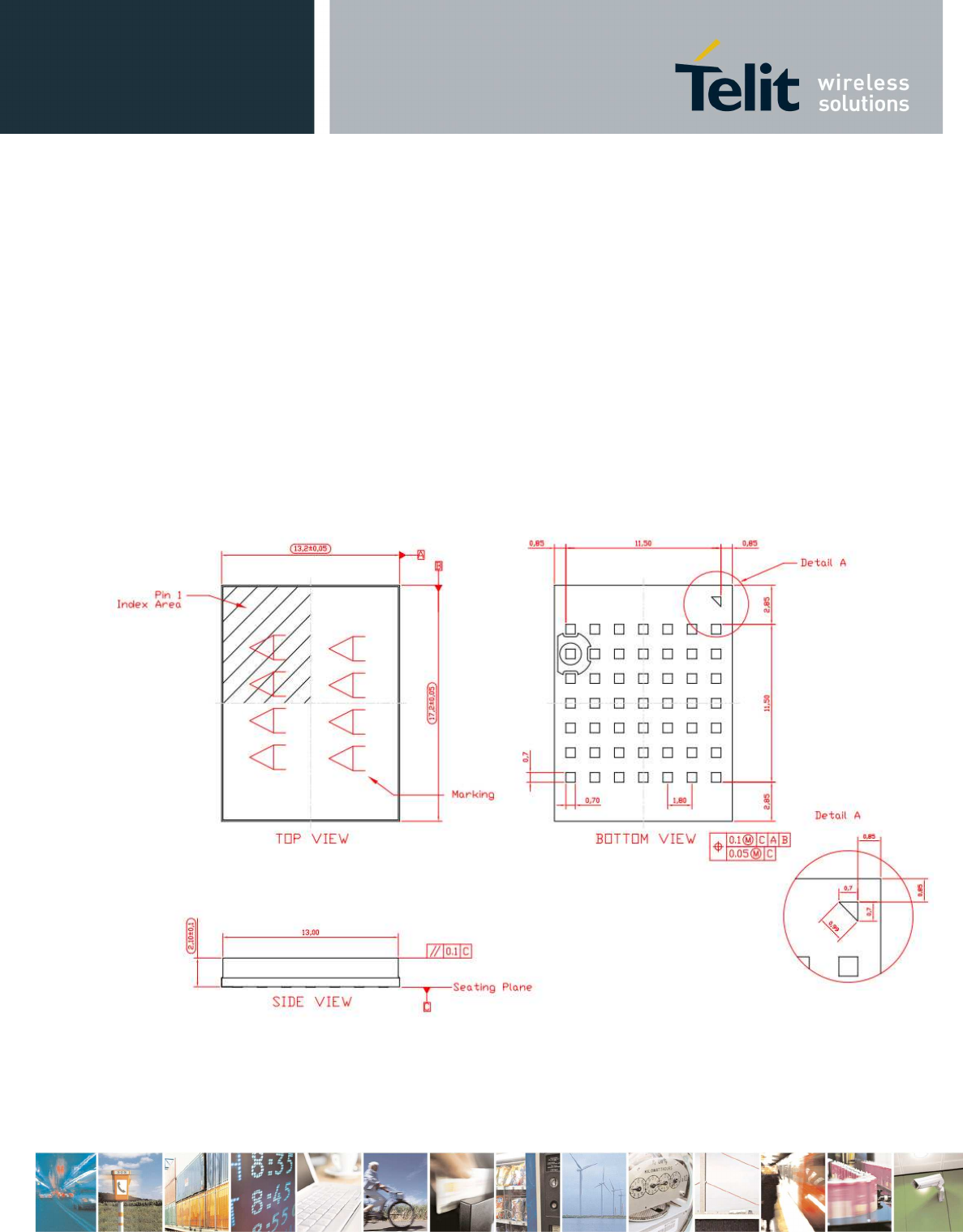
GE866-DUAL Hardware User Guide
1VV0301051 Rev. 2 – 2014-04-07
7
Reproduction forbidden without written authorization from Telit Communications S.p.A. - All Rights
Reserved. Page 12 of 82
Mod. 0805 2011-07 Rev.2
3. GE866-QUAD Mechanical Dimensions
The GE866-QUAD overall dimensions are:
• Length: 17.2 mm
• Width: 13.2 mm
• Thickness: 2.1 mm
• Weight: 1.5 g
Figure 1
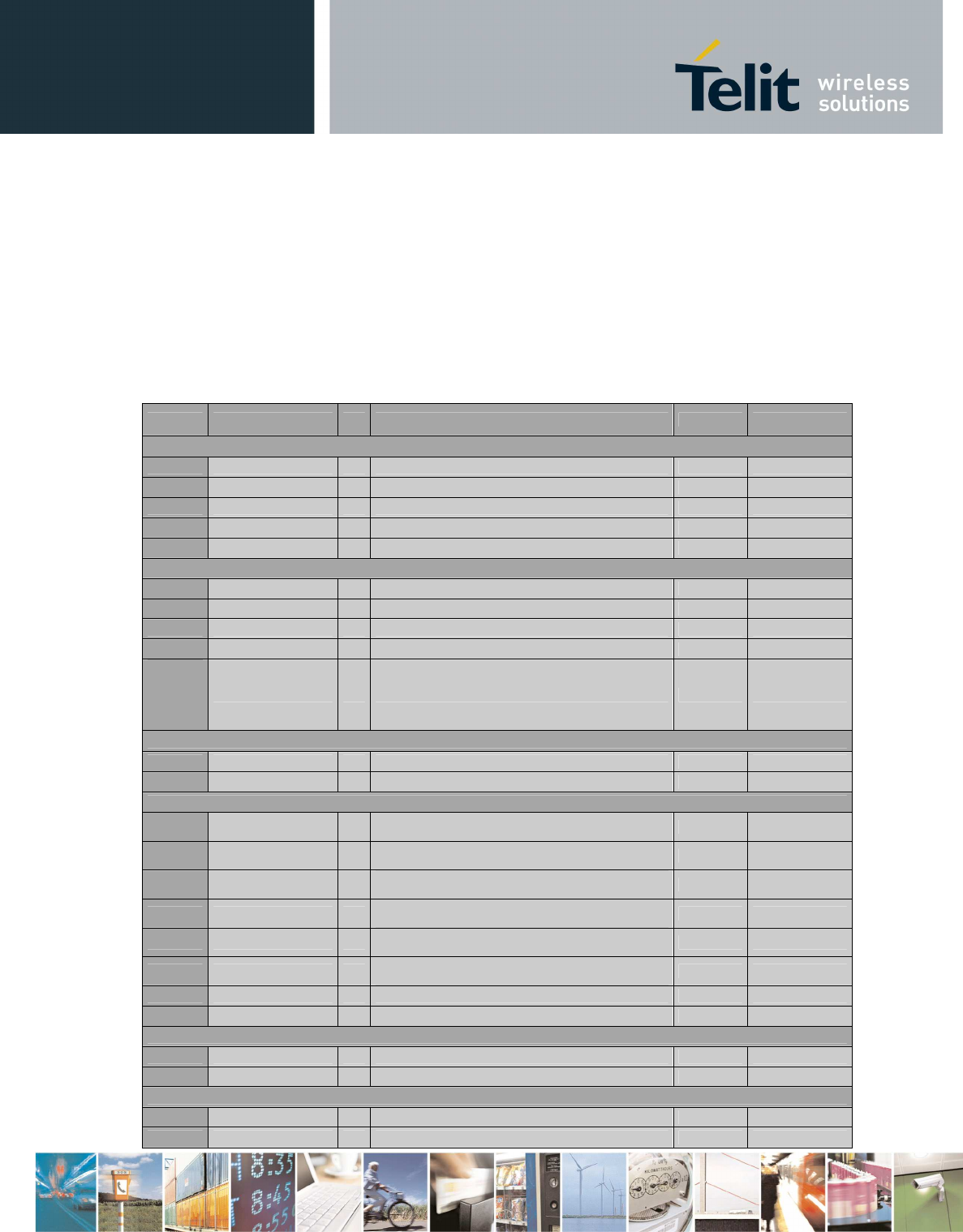
GE866-DUAL Hardware User Guide
1VV0301051 Rev. 2 – 2014-04-07
7
Reproduction forbidden without written authorization from Telit Communications S.p.A. - All Rights
Reserved. Page 13 of 82
Mod. 0805 2011-07 Rev.2
4. GE866-QUAD module connections
4.1. PIN-OUT
Pad Signal I/O
Function Note Type
Audio
E7 EAR- AO
Earphone signal output, phase - Audio
D7 EAR+ AO
Earphone signal output, phase + Audio
G7 MIC- AI Mic. signal input; phase- Audio
F7 MIC+ AI Mic. signal input; phase+ Audio
F6 AGND - Analog Ground Power
SIM card interface
C7 SIMVCC - External SIM signal – Power supply for the SIM 1,8 / 3V
B7 SIMRST O External SIM signal – Reset 1,8 / 3V
A7 SIMCLK O External SIM signal – Clock 1,8 / 3V
A6 SIMIO I/O External SIM signal – Data I/O 4.7k Pull up
1,8 / 3V
X
All GPI0
can be
program
med
SIMIN I Presence SIM input CMOS 1.8V
Trace
C2 RXD_AUX I Auxiliary UART (RX Data) CMOS 1.8V
C1 TXD_AUX O Auxiliary UART (TX Data) CMOS 1.8V
Prog. / Data + HW Flow Control
B2 C109/DCD/GPO O Output for Data carrier detect signal (DCD) to DTE
/ GP output CMOS 1.8V
B3 C125/RING/GPO O Output for Ring indicator signal (RI) to DTE
/ GP output CMOS 1.8V
A3 C107/DSR/GPO O Output for Data set ready signal (DSR) to DTE
/ GP output CMOS 1.8V
A2 C108/DTR/GPI I Input for Data terminal ready signal (DTR) from DTE
/ GP input CMOS 1.8V
A1 C105/RTS/GPI I Input for Request to send signal (RTS) from DTE
/ GP input CMOS 1.8V
B1 C106/CTS/GPO O Output for Clear to send signal (CTS) to DTE
/ GP output CMOS 1.8V
A4 C103/TXD I Serial data input (TXD) from DTE CMOS 1.8V
A5 C104/RXD O Serial data output to DTE CMOS 1.8V
DAC and ADC
F4 ADC_IN AI Analog/Digital converter input A/D
E4 DAC_OUT AO
Digital/Analog converter output D/A
Miscellaneous Functions
F5 VRTC AO
VRTC Backup 2.3V Power
G4 RESET* I Reset input CMOS 1.8V
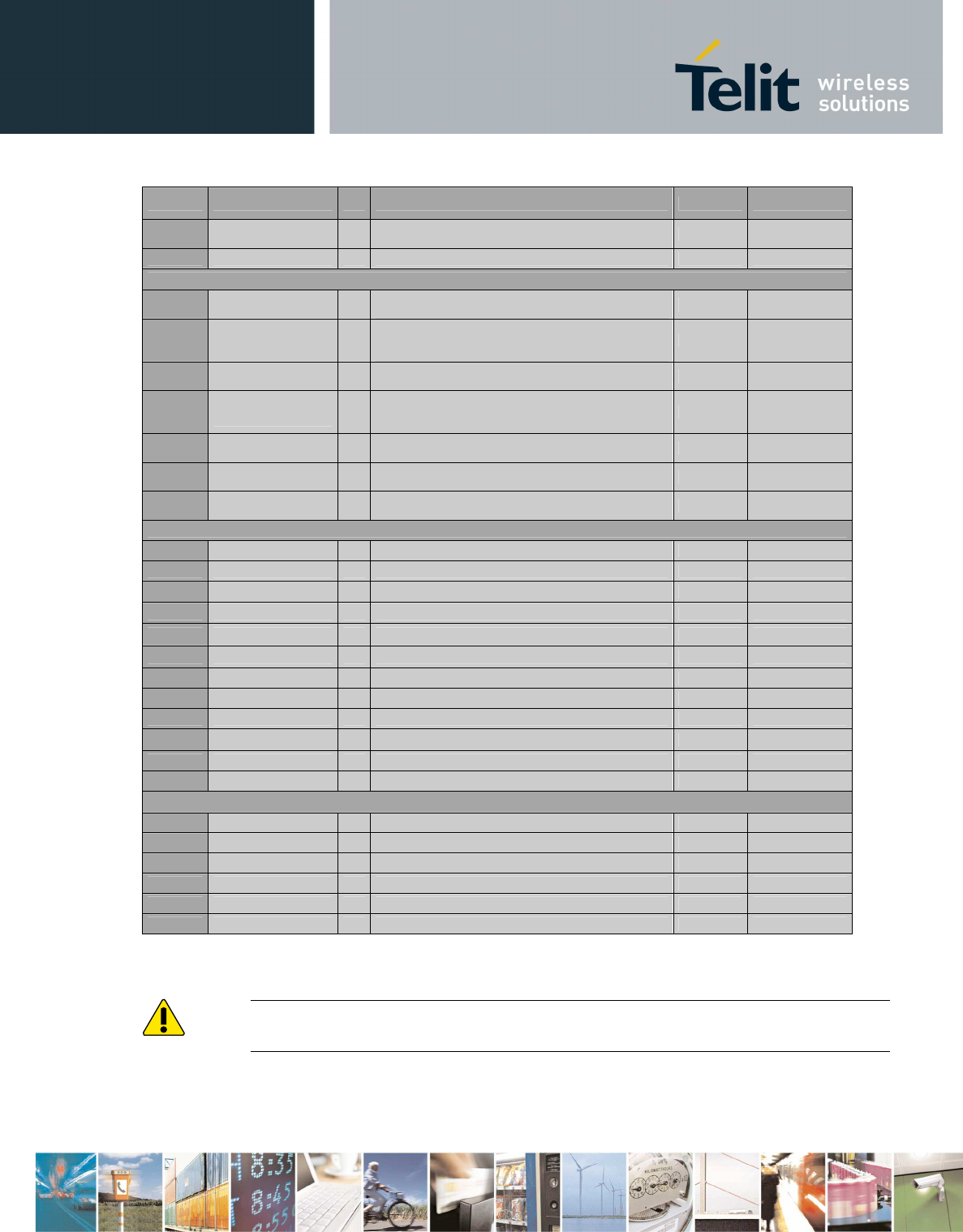
GE866-DUAL Hardware User Guide
1VV0301051 Rev. 2 – 2014-04-07
7
Reproduction forbidden without written authorization from Telit Communications S.p.A. - All Rights
Reserved. Page 14 of 82
Mod. 0805 2011-07 Rev.2
Pad Signal I/O
Function Note Type
G6 V_AUX / PWRMON O 1.8V stabilized output Imax=100mA
/ Power ON monitor Power Out 1.8V
G2 Antenna I/O Antenna pad – 50 Ω RF
GPIO
C5 GPIO_01 / DVI_WA0 I/O GPIO01 Configurable GPIO
/ Digital Audio Interface (WA0) CMOS 1.8V
C6 GPIO_02 / JDR /
DVI_RX I/O GPIO02 I/O pin
/ Jammer Detect Report
/ Digital Audio Interface (RX) CMOS 1.8V
D6 GPIO_03 / DVI_TX I/O GPIO03 GPIO I/O pin
/ Digital Audio Interface (TX) CMOS 1.8V
D5 GPIO_04 / TX Disable
/ DVI_CLK I/O GPIO04 Configurable GPIO
/ TX Disable input
/ Digital Audio Interface (CLK) CMOS 1.8V
B5 GPIO_05 / RFTXMON
I/O GPIO05 Configurable GPIO
/ Transmitter ON monitor CMOS 1.8V
B4 GPIO_06 / ALARM /
BUZZER I/O GPIO06 Configurable GPIO
/ ALARM CMOS 1.8V
C4 GPIO_07 / STAT_LED
I/O GPIO07 Configurable GPIO
/ Digital Audio Interface (CLK) CMOS 1.8V
Power Supply
E2 VBATT - Main power supply (Baseband) Power
E1 VBATT_PA - Main power supply (Radio PA) Power
F6 AGND - AF Signal Ground (see audio section) AF Signal
D1 GND - Ground Power
F1 GND - Ground Power
G1 GND - Ground Power
D2 GND - Ground Power
F2 GND - Ground Power
C3 GND - Ground Power
E3 GND - Ground Power
F3 GND - Ground Power
G3 GND - Ground Power
RESERVED
D3 -
D4 -
E5 -
G5 -
B6 -
E6 -
WARNING:
Reserved pins must not be connected.
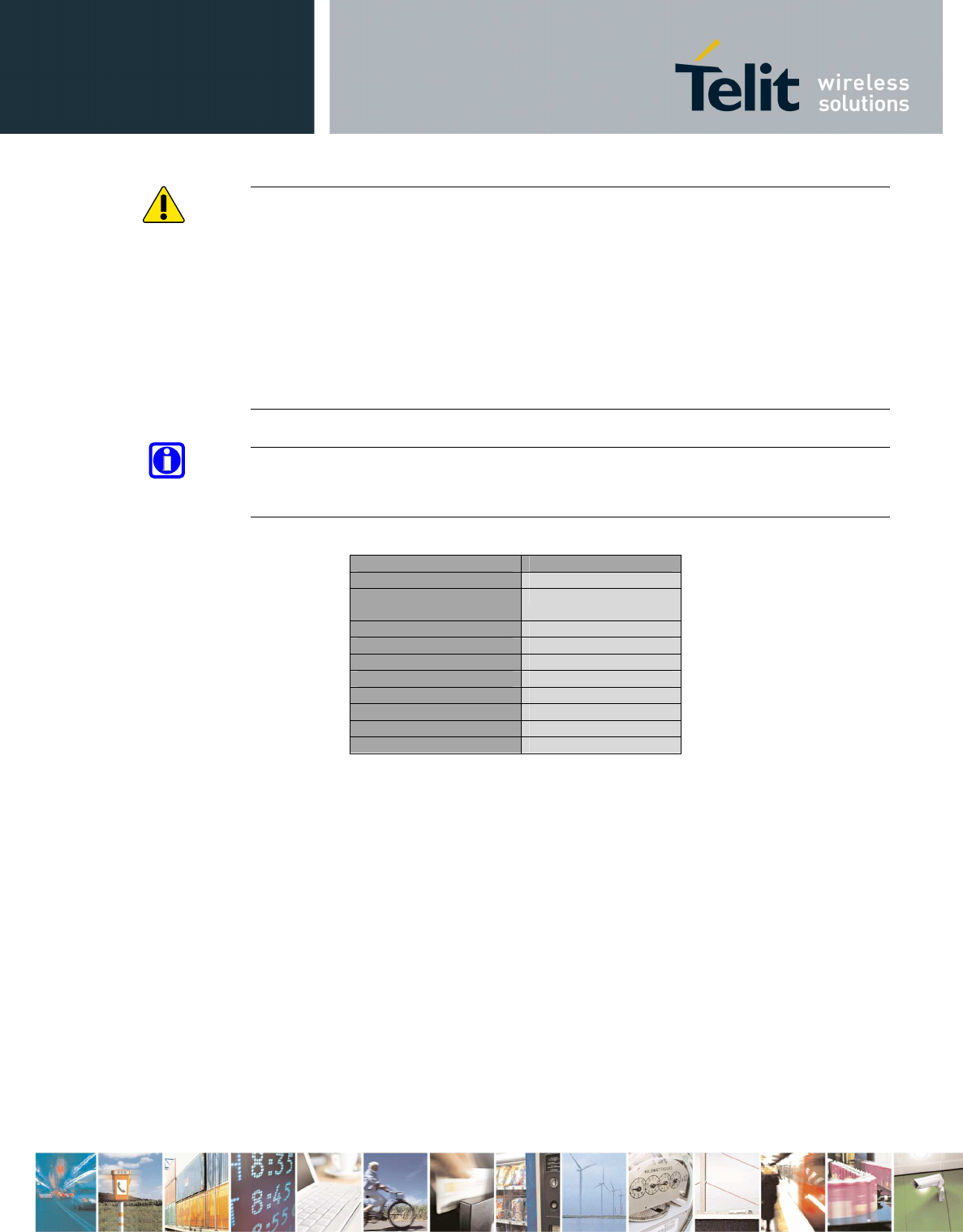
GE866-DUAL Hardware User Guide
1VV0301051 Rev. 2 – 2014-04-07
7
Reproduction forbidden without written authorization from Telit Communications S.p.A. - All Rights
Reserved. Page 15 of 82
Mod. 0805 2011-07 Rev.2
WARNING:
VAUX output must not be used to supply any device on the
customer application.
It is only provided as reference/supply voltage when voltage
translation to 1V8 CMOS is needed.
When its use is necessary, it is strongly recommended to
connect VAUX through a series resistor as closed as possible
to the module in order to reduce the inrush current of the
internal DC/DC supply. Use a low value resistor (e.g. 10 ohm,
1/3W) with a maximum power rating related to drained current.
NOTE:
If not used, almost all pins should be left disconnected. The
only exceptions are the following pins:
Pin signal
E2, E1 VBATT & VBATT_PA
D1, F1, G1, D2, F2, C2,
E3, F3, G3 GND
F6 AGND
A4 TXD
A5 RXD
A1 RTS
G6 V_AUX / PWRMON
G4 RESET*
C1 TXD_AUX
C2 RXD_AUX
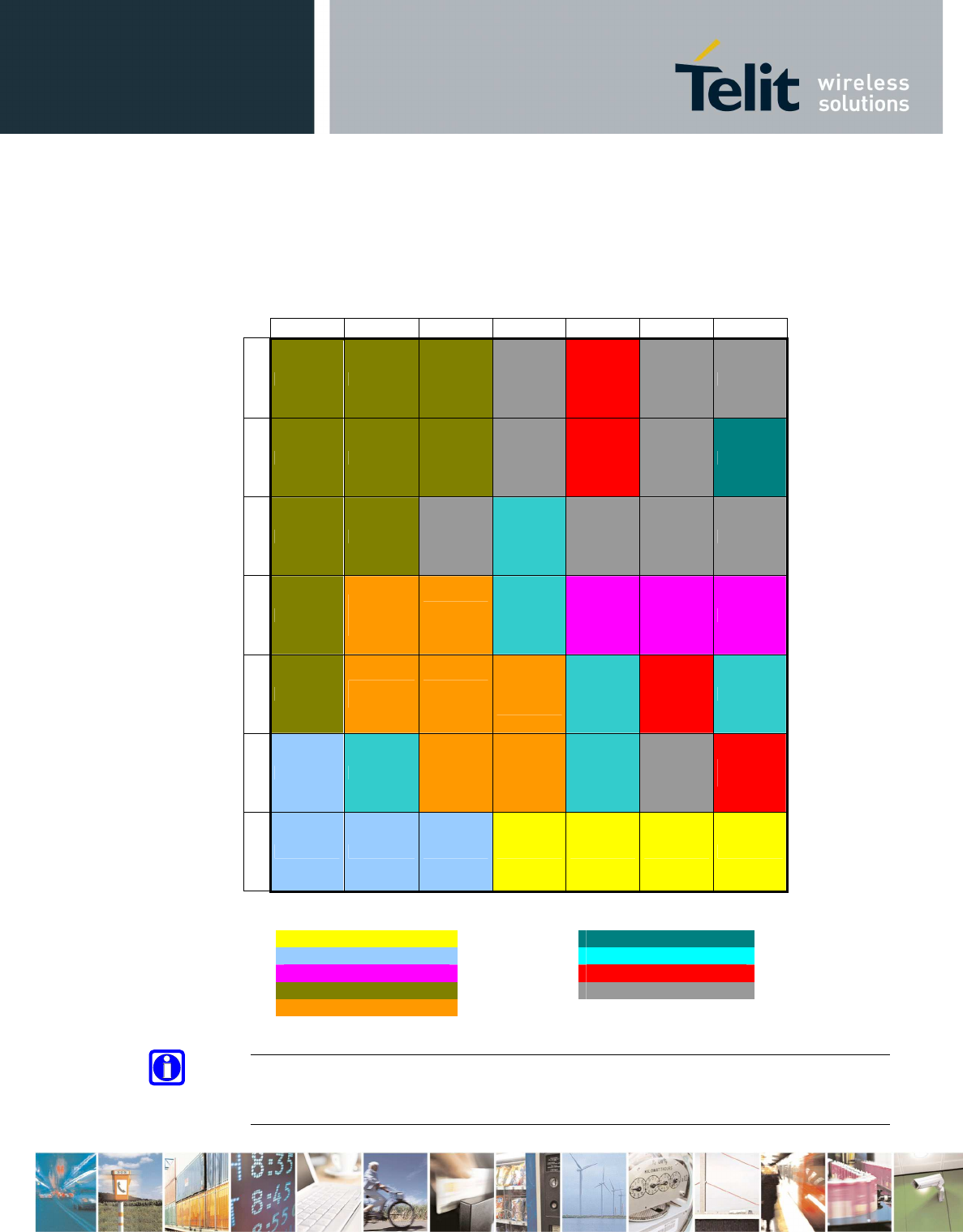
GE866-DUAL Hardware User Guide
1VV0301051 Rev. 2 – 2014-04-07
7
Reproduction forbidden without written authorization from Telit Communications S.p.A. - All Rights
Reserved. Page 16 of 82
Mod. 0805 2011-07 Rev.2
4.2. Pin Layout
TOP VIEW
A B C D E F G
1
C105/RTS
C106/CTS TXD_AUX GND VABTT_PA
GND GND
2
C108/DTR
C109/DCD RXD_AUX GND VABTT GND ANT
3
C107/DSR
C125/RING
GND RESERVED
GND GND GND
4
C103/TXD
GPIO_06/
ALRM/
BUZZER
GPIO_07/
STAT_LED
RESERVED
DAC_OUT ADC_IN RESET*
5
C104/RXD
GPIO_05/
RFTXMON GPIO_01/
DVI_WAO
GPIO_04/
TX_DIS/
DVI_CLK RESERVED
VRTC RESERVED
6
SIMIO RESERVED GPIO_02/
JDR/
DVI_RX
GPIO_03/
DVI_TX RESERVED
AGND V_AUX/
PWRMON
7
SIMCLK SIMRST SIMVCC EAR+ EAR- MIC+ MIC-
AUDIO ANTENNA
SIM RESERVED/FU
MISCELLANOUS POWER
SERIAL GND
GPIO
NOTE:
The pins defined RESERVED must not be connected to any pin in
the application.
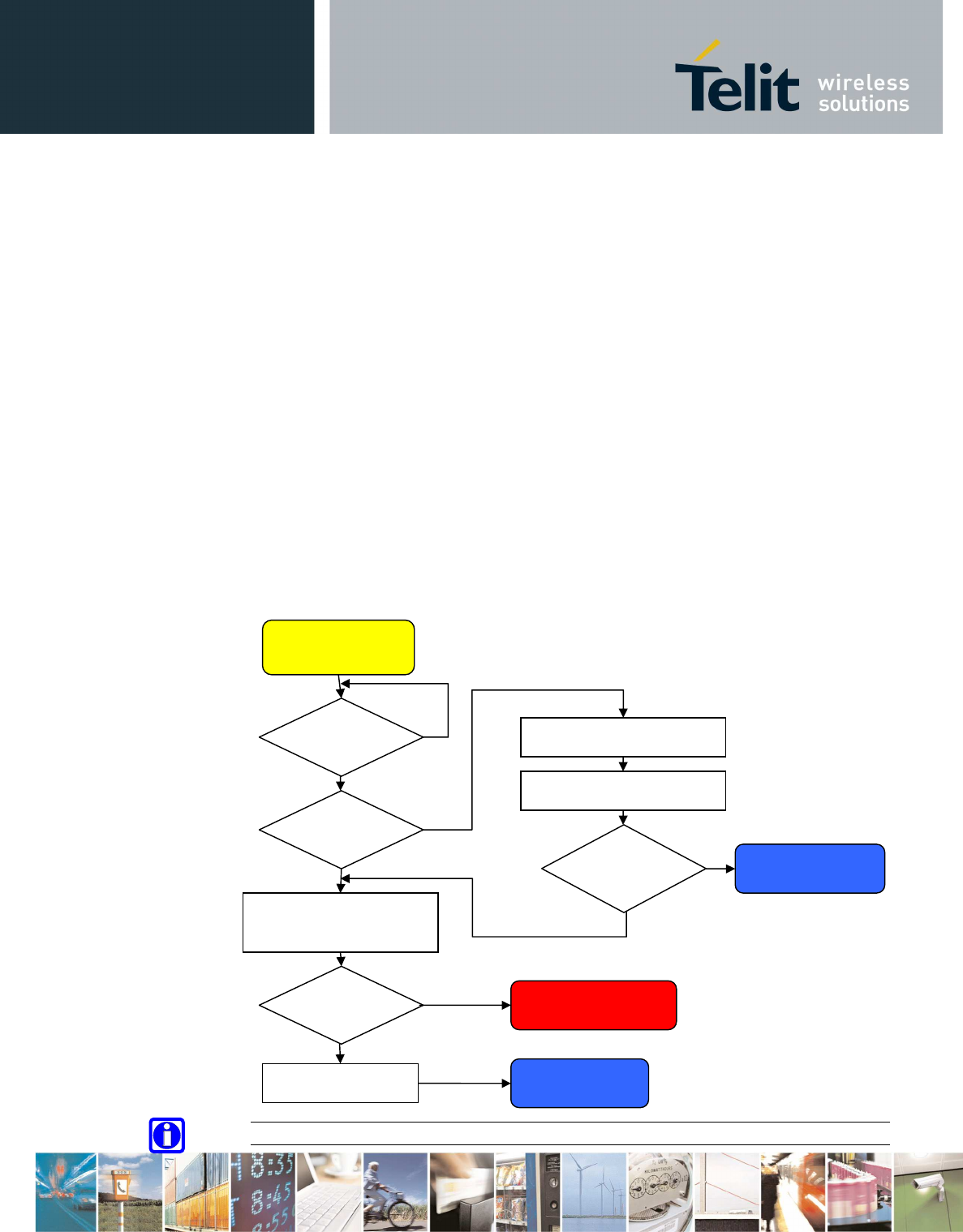
GE866-DUAL Hardware User Guide
1VV0301051 Rev. 2 – 2014-04-07
7
Reproduction forbidden without written authorization from Telit Communications S.p.A. - All Rights
Reserved. Page 17 of 82
Mod. 0805 2011-07 Rev.2
5. Hardware Commands
5.1. Auto-Turning ON the GE866-QUAD
To Auto-turn on the GE866-QUAD, the power supply must be
applied on the power pins VBATT and VBATT_PA, after 1000 m-
seconds, the V_AUX / PWRMON pin will be at the high logic
level and the module can be considered fully operating.
When the power supply voltage is between 3.22V and 3.4V, after
5000 m-seconds, the V_AUX / PWRMON pin will be at the high
logic level and the module can be considered fully operating.
The following flow chart shows the proper turn on procedure:
NOTE:
Modem ON Proc.
PWR supply = ON?
Y
Delay 1s - 5s for Low
Voltage Operating
Y
Modem Reset Proc.
AT init sequence.
N
Start AT CMD.
N
PWMON = ON?
Y
PWMON = ON?
Delay 300mS
Enter AT<CR>
AT answer in
1second ?
N
Y
N
Delay 1s
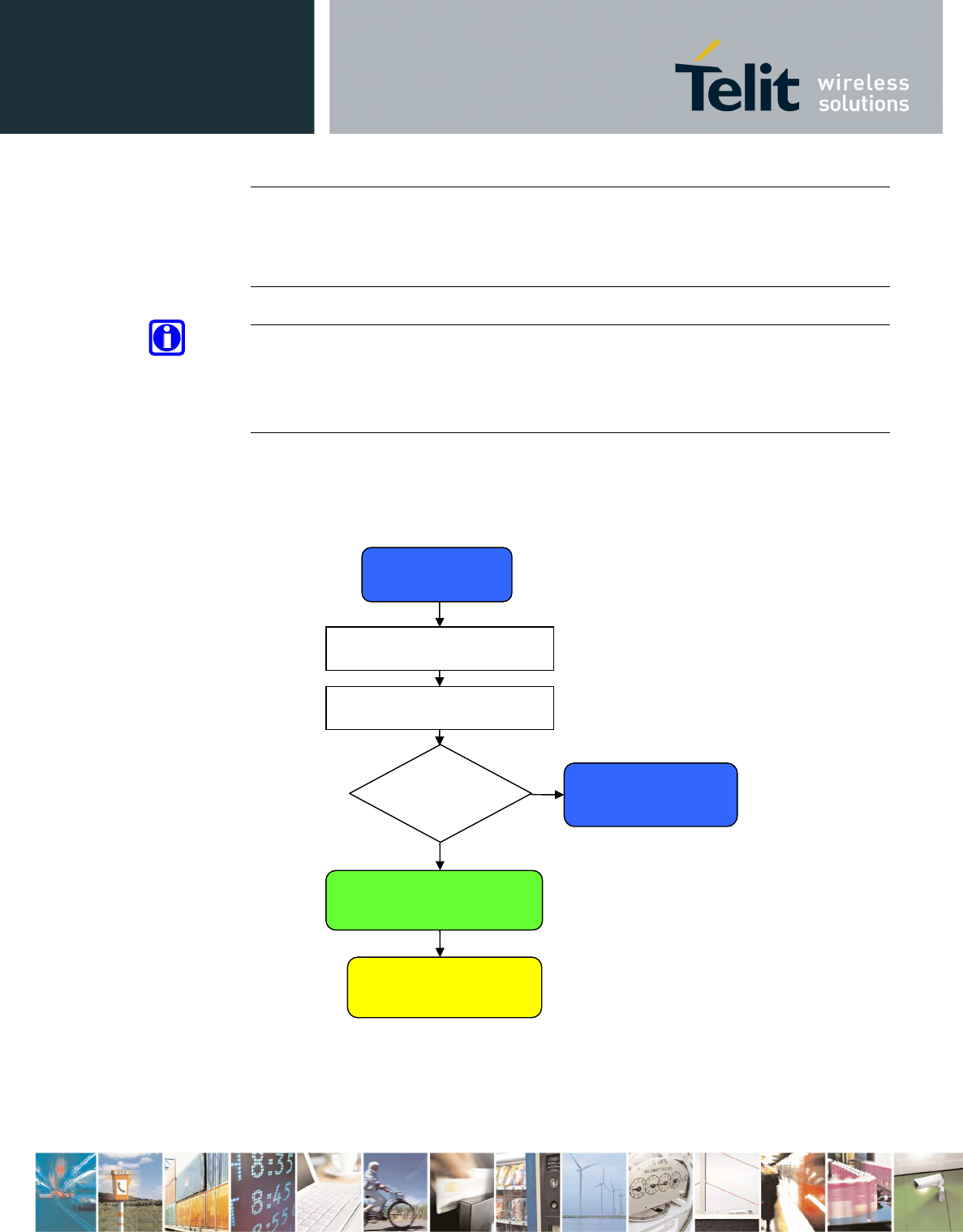
GE866-DUAL Hardware User Guide
1VV0301051 Rev. 2 – 2014-04-07
7
Reproduction forbidden without written authorization from Telit Communications S.p.A. - All Rights
Reserved. Page 18 of 82
Mod. 0805 2011-07 Rev.2
The power supply must be applied either at the same time on
pins VBATT and VBATT_PA, or first applied on VBATT_PA and then
on VBATT. The opposite sequence shall be avoided. The reverse
procedure applies for powering down the module: first
disconnect VBATT, then VBATT_PA, or both at once.
NOTE:
In order to prevent a back powering effect it is recommended
to avoid having any HIGH logic level signal applied to the
digital pins of the GE866-QUAD when the module is powered OFF
or during an ON/OFF transition.
A flow chart showing the AT commands managing procedure is
displayed below:
Modem ON Proc.
Disconnect PWR
supply
AT init sequence.
Delay 300mS
Enter AT<CR>
AT answer in
1second?
Y
N
Start AT CMD.

GE866-DUAL Hardware User Guide
1VV0301051 Rev. 2 – 2014-04-07
7
Reproduction forbidden without written authorization from Telit Communications S.p.A. - All Rights
Reserved. Page 19 of 82
Mod. 0805 2011-07 Rev.2
5.2. Turning OFF the GE866-QUAD
Turning off of the device can be done in two ways:
• General turn OFF
• Processor turn OFF
General turn OFF – disconnect the power supply from the both
power pins VBATT and VBATT_PA at the same time. In this case
all parts of the module are in OFF condition, no power
consumption is present.
Processor turn OFF – disconnect the power supply only from the
power pin VBATT, the power pin VBATT_PA can be connected to
power supply, in this case a low, about 30uA, power
consumption is present
Before either of both OFF procedures is applied, the
AT#SYSHALT AT command must be sent (see AT Commands Reference
Guide, 80000ST10025a), after the OK response message, wait for
10 seconds, then the module can be consider fully not
operating and at this moment is possible disconnect the Power
Supply.
The following flow chart shows the proper turnoff procedure:
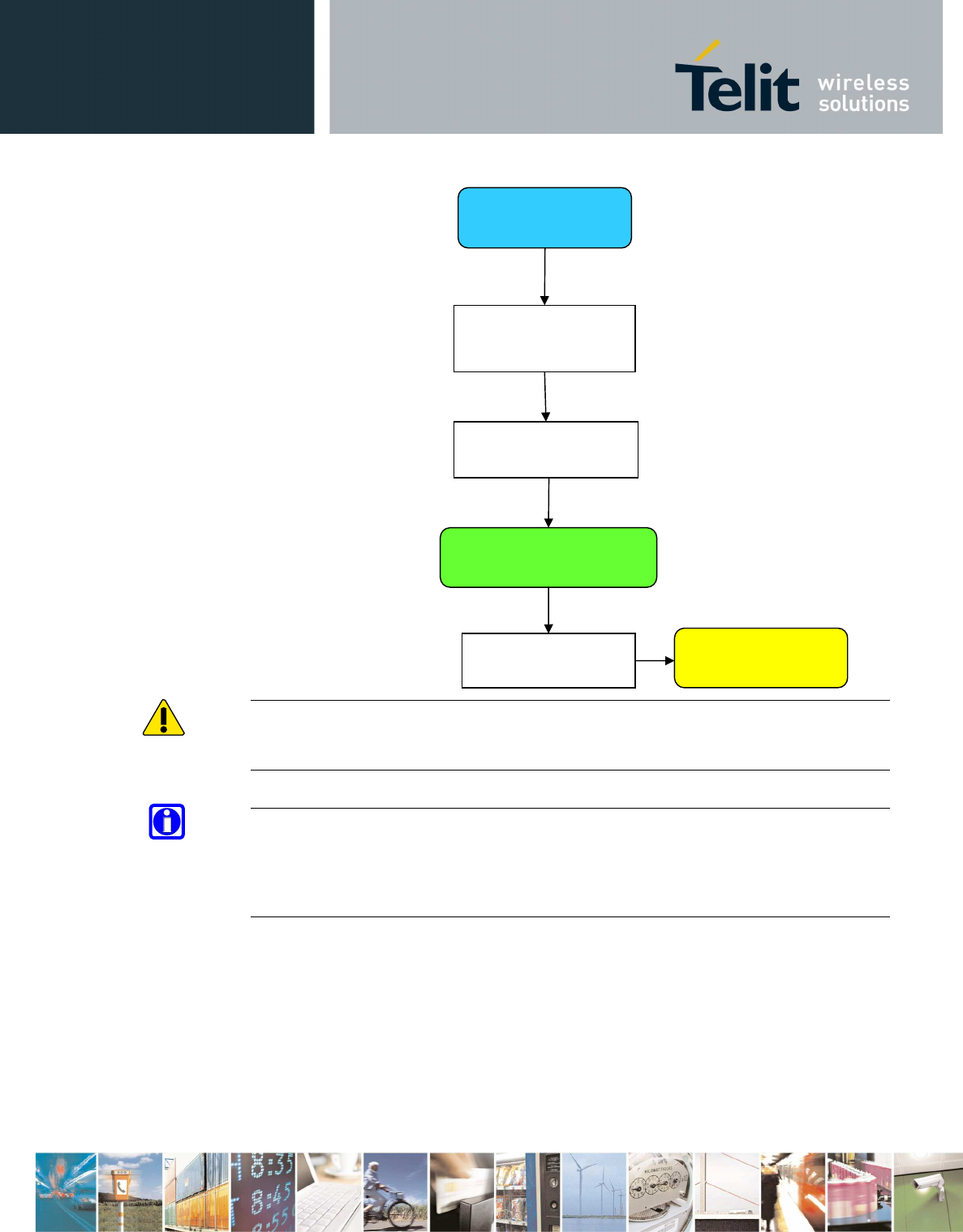
GE866-DUAL Hardware User Guide
1VV0301051 Rev. 2 – 2014-04-07
7
Reproduction forbidden without written authorization from Telit Communications S.p.A. - All Rights
Reserved. Page 20 of 82
Mod. 0805 2011-07 Rev.2
WARNING:
PWRMON can be used to monitor only the power on but it cannot
be used to monitor the power off because it remains high
NOTE:
In order to prevent a back powering effect it is recommended
to avoid having any HIGH logic level signal applied to the
digital pins of the GE866-QUAD when the module is powered off
or during an ON/OFF transition.
Modem OFF
Proc.
AT#SYSHALT
Disconnect PWR
supply
10s timeout
Modem ON Proc.
Delay 1.5s

GE866-DUAL Hardware User Guide
1VV0301051 Rev. 2 – 2014-04-07
7
Reproduction forbidden without written authorization from Telit Communications S.p.A. - All Rights
Reserved. Page 21 of 82
Mod. 0805 2011-07 Rev.2
5.3. Resetting the GE866-QUAD
5.3.1. Hardware Unconditional restart
WARNING:
The hardware unconditional Restart must not be used during
normal operation of the device since it does not detach the
device from the network. It shall be kept as an emergency exit
procedure to be done in the rare case that the device gets
stuck waiting for some network or SIM responses.
To unconditionally reboot the GE866-QUAD, the pad RESET* must
be tied low for at least 200 milliseconds and then released.
The maximum current that can be drained from the ON* pad is
0.15 mA.
NOTE:
Do not use any pull up resistor on the RESET* line nor any
totem pole digital output. Using pull up resistor may bring to
latch up problems on the GE866-QUAD power regulator and
improper functioning of the module. The line RESET* must be
connected only in open collector configuration; the transistor
must be connected as close as possible to the RESET* pin.
TIP:
The unconditional hardware restart must always be implemented
on the boards and the software must use it as an emergency
exit procedure.
A simple circuit to do it is:
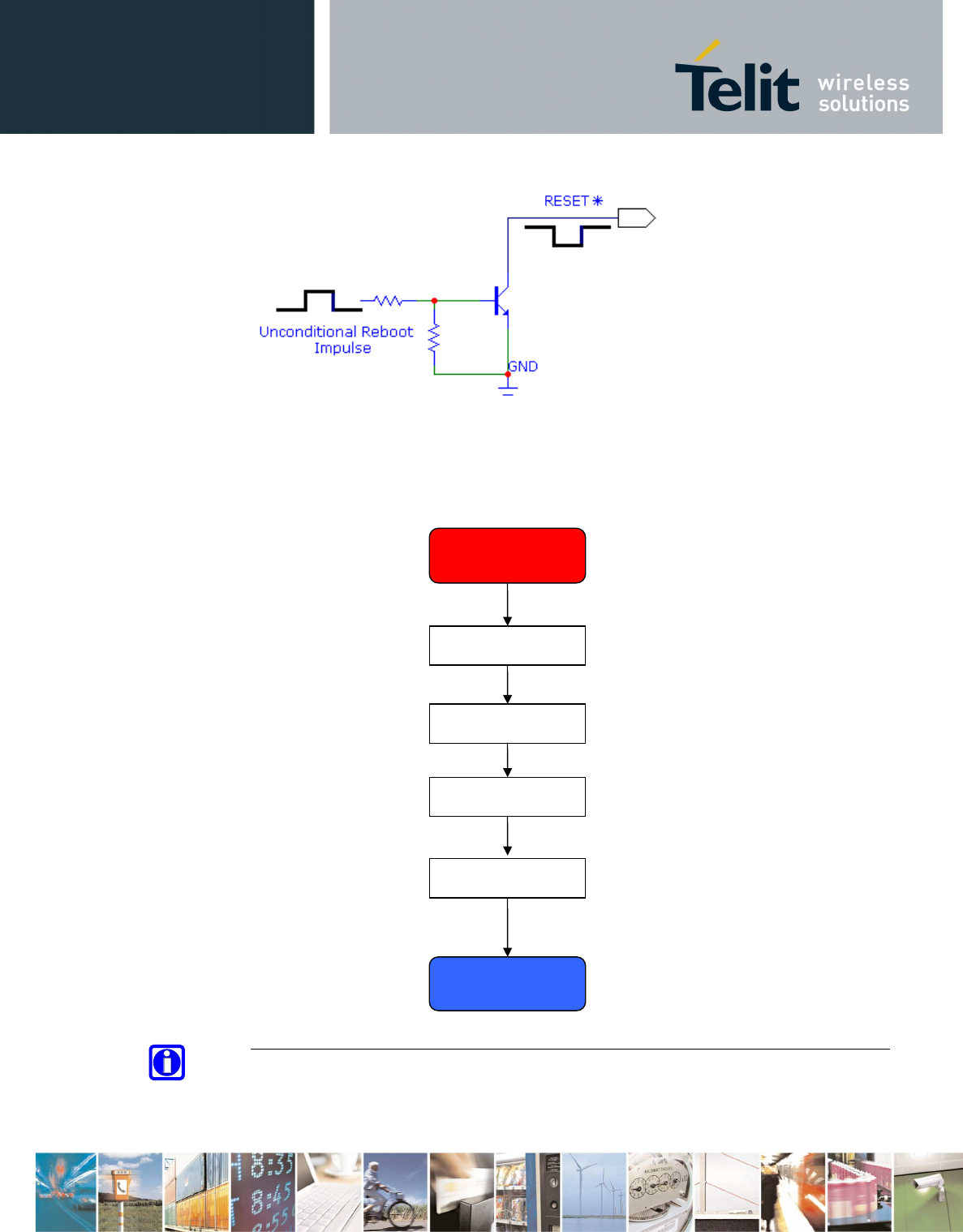
GE866-DUAL Hardware User Guide
1VV0301051 Rev. 2 – 2014-04-07
7
Reproduction forbidden without written authorization from Telit Communications S.p.A. - All Rights
Reserved. Page 22 of 82
Mod. 0805 2011-07 Rev.2
In the following flow chart is detailed the proper restart
procedure:
NOTE:
In order to prevent a back powering effect it is recommended
to avoid having any HIGH logic level signal applied to the
Modem Reset
Proc.
Reset = LOW
Delay 200ms
Reset = HIGH
Delay 1s
Start AT CMD.

GE866-DUAL Hardware User Guide
1VV0301051 Rev. 2 – 2014-04-07
7
Reproduction forbidden without written authorization from Telit Communications S.p.A. - All Rights
Reserved. Page 23 of 82
Mod. 0805 2011-07 Rev.2
digital pins of the GE866-QUAD when the module is powered OFF
or during an ON/OFF transition.
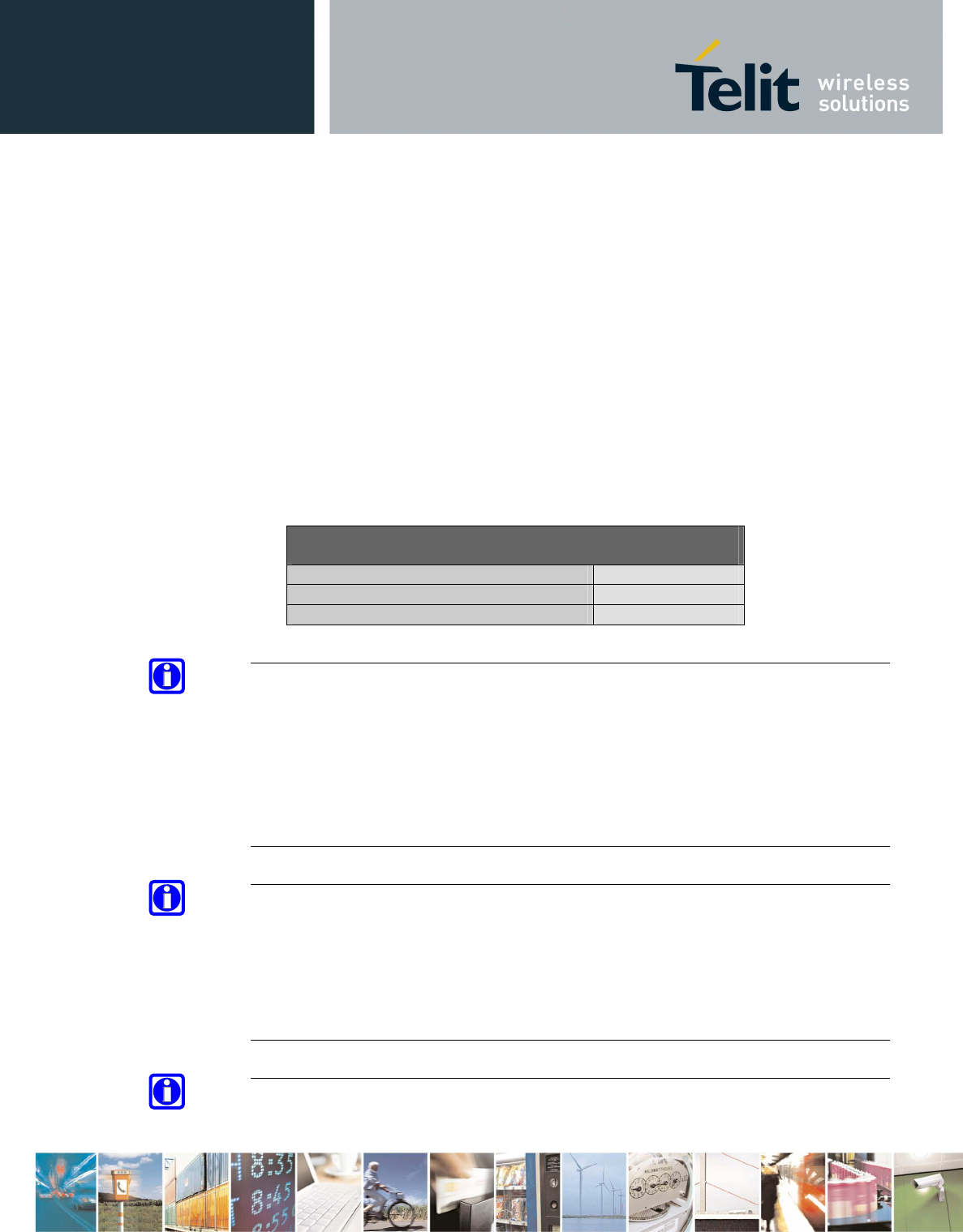
GE866-DUAL Hardware User Guide
1VV0301051 Rev. 2 – 2014-04-07
7
Reproduction forbidden without written authorization from Telit Communications S.p.A. - All Rights
Reserved. Page 24 of 82
Mod. 0805 2011-07 Rev.2
6. Power Supply
The power supply circuitry and board layout are a very
important part in the full product design and they strongly
reflect on the product overall performance, hence read the
requirements carefully and the guidelines that will follow for
a proper design.
6.1. Power Supply Requirements
The external power supply must be connected to VBATT &
VBATT_PA signals and must fulfill the following requirements:
POWER SUPPLY
Nominal Supply Voltage
3.8 V
Normal Operating Voltage Range
3.40 V÷ 4.20 V
Extended Operating Voltage Range
3.
10
V
÷ 4.50 V
NOTE:
The Operating Voltage Range MUST never be exceeded; care must
be taken when designing the application’s power supply section
to avoid having an excessive voltage drop.
If the voltage drop is exceeding the limits it could cause a
Power Off of the module.
The Power supply must be higher than 3.22 V to power on the
module.
NOTE:
Overshoot voltage (regarding MAX Extended Operating Voltage)
and drop in voltage (regarding MIN Extended Operating Voltage)
MUST never be exceeded;
The “Extended Operating Voltage Range” can be used only with
complete assumption and application of the HW User guide
suggestions.
NOTE:
When the power supply voltage is between 3.22V and 3.4V, after
5000 m-seconds, the V_AUX / PWRMON pin will be at the high

GE866-DUAL Hardware User Guide
1VV0301051 Rev. 2 – 2014-04-07
7
Reproduction forbidden without written authorization from Telit Communications S.p.A. - All Rights
Reserved. Page 25 of 82
Mod. 0805 2011-07 Rev.2
logic level and the module can be consider fully operating.
See Par. 5.1.
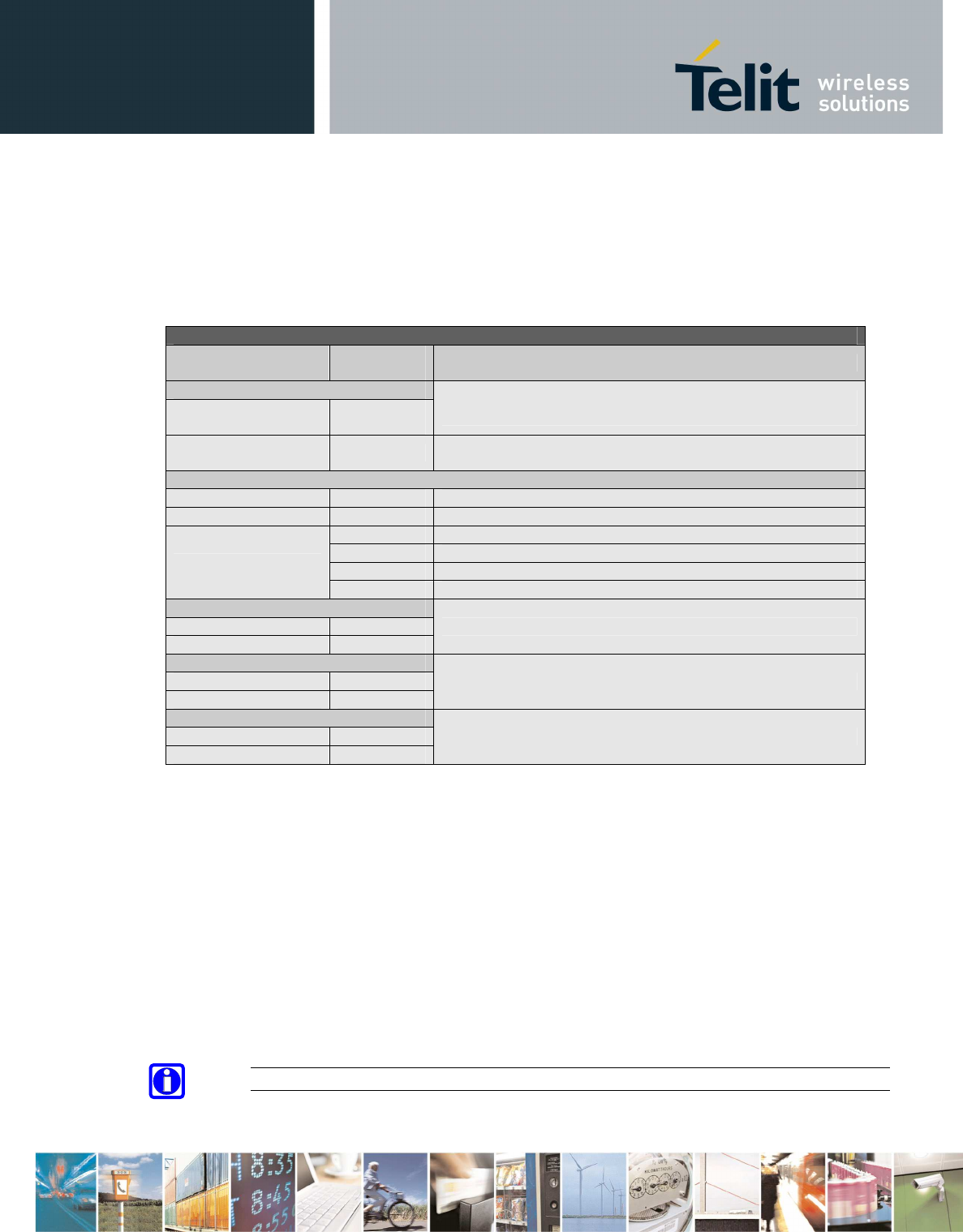
GE866-DUAL Hardware User Guide
1VV0301051 Rev. 2 – 2014-04-07
7
Reproduction forbidden without written authorization from Telit Communications S.p.A. - All Rights
Reserved. Page 26 of 82
Mod. 0805 2011-07 Rev.2
6.2. Power Consumption
The GE866-QUAD preliminary power consumptions are:
GE866-QUAD
Mode Average
(mA) Mode description
SWITCHED OFF Module power supplied only on VBATT_PA pin, the VBATT pin
is not power supplied.
Switched Off Typical 2uA
max 20uA
Switched Off with
AT#SYSHALT <500uA Module power supplied on VBATT_PA pin and VBATT pin, the
command AT#SYSHALT is applied.
IDLE mode
AT+CFUN=1 9 Normal mode: full functionality of the module
AT+CFUN=4 9
Disabled TX and RX; module is not registered on the network
AT+CFUN=0 or =5
1.7
Paging Multiframe 2
1.5
Paging Multiframe 3
1.3
Paging Multiframe 4
0,8
Paging Multiframe 9
CSD TX and RX mode GSM VOICE CALL GSM900 CSD PL5 200
DCS1800 CSD PL0
150
GPRS (class 1) 1TX + 1RX GPRS Sending data mode GSM900 PL5 200
DCS1800 PL0 140
GPRS (class 10) 2TX + 3RX GPRS Sending data mode GSM900 PL5 330
DCS1800 PL0
250
The GSM system is made in a way that the RF transmission is
not continuous, but it is packed into bursts at a base
frequency of approx. 217 Hz, and the relative current peaks
can be as high as about 2A. Therefore the power supply has to
be designed to withstand these current peaks without big
voltage drops; this means that both the electrical design and
the board layout must be designed for this current flow.
If the layout of the PCB is not well designed a strong noise
floor is generated on the ground and the supply; this will
reflect on all the audio paths producing an audible annoying
noise at approx. 217 Hz; if the voltage drop during the peak
current absorption is too much, then the device may even
shutdown as a consequence of the supply voltage drop.
NOTE:

GE866-DUAL Hardware User Guide
1VV0301051 Rev. 2 – 2014-04-07
7
Reproduction forbidden without written authorization from Telit Communications S.p.A. - All Rights
Reserved. Page 27 of 82
Mod. 0805 2011-07 Rev.2
The electrical design for the Power supply should be made
ensuring it will be capable of a peak current output of at
least 2 A.
6.3. General Design Rules
The principal guidelines for the Power Supply Design embrace
three different design steps:
• The electrical design
• The thermal design
• Thermal PCB layout
6.3.1. Electrical Design Guidelines
The electrical design of the power supply depends strongly on
the power source from which this power is drained. We will
distinguish them into three categories:
• +5V input (typically PC internal regulator output)
• +12V input (typically automotive)
• Battery
6.3.1.1. + 5V input Source Power Supply Design Guidelines
• The desired output for the power supply is 3.8V, hence
there's not a big difference between the input source and
the desired output and a linear regulator can be used. A
switching power supply will not be suited because of the
low drop out requirements.
• When using a linear regulator, a proper heat sink shall be
provided in order to dissipate the power generated.
• A Bypass low ESR capacitor of adequate capacity must be
provided in order to cut the current absorption peaks close
to the GE866-QUAD, a 100µF tantalum capacitor is usually
suited.
• Make sure the low ESR capacitor on the power supply output
(usually a tantalum one) is rated at least 10V.
• A protection diode should be inserted close to the power
input, in order to save the GE866-QUAD from power polarity
inversion.
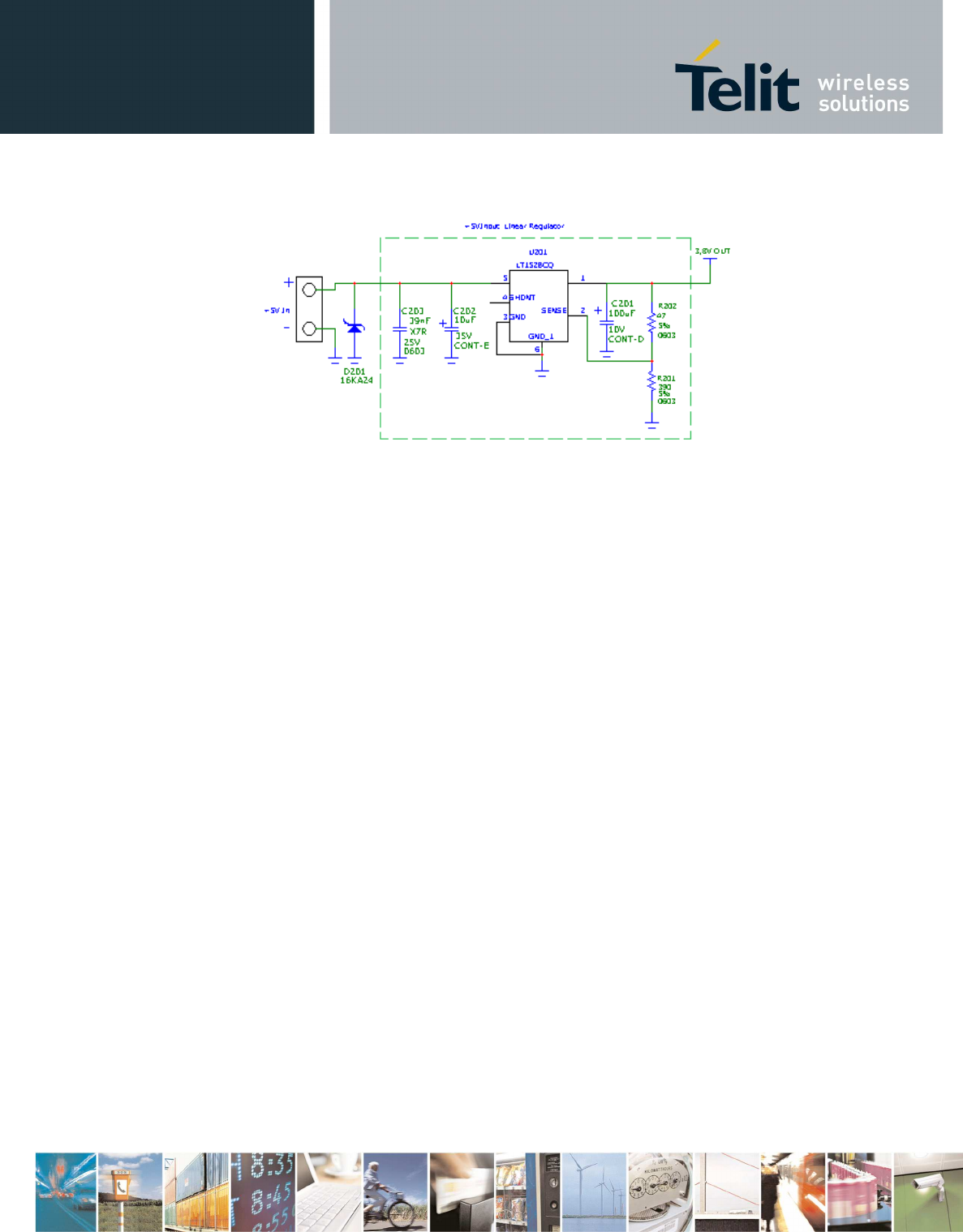
GE866-DUAL Hardware User Guide
1VV0301051 Rev. 2 – 2014-04-07
7
Reproduction forbidden without written authorization from Telit Communications S.p.A. - All Rights
Reserved. Page 28 of 82
Mod. 0805 2011-07 Rev.2
An example of linear regulator with 5V input is:
6.3.1.2. +
12V input Source Power Supply Design Guidelines
• The desired output for the power supply is 3.8V, hence due
to the big difference between the input source and the
desired output, a linear regulator is not suited and shall
not be used. A switching power supply will be preferable
because of its better efficiency especially with the 2A
peak current load represented by the GE866-QUAD.
• When using a switching regulator, a 500kHz or more
switching frequency regulator is preferable because of its
smaller inductor size and its faster transient response.
This allows the regulator to respond quickly to the current
peaks absorption.
• In any case the frequency and Switching design selection is
related to the application to be developed due to the fact
the switching frequency could also generate EMC
interferences.
• For car PB battery the input voltage can rise up to 15,8V
and this should be kept in mind when choosing components:
all components in the power supply must withstand this
voltage.
• A Bypass low ESR capacitor of adequate capacity must be
provided in order to cut the current absorption peaks, a
100µF tantalum capacitor is usually suited.
• Make sure the low ESR capacitor on the power supply output
(usually a tantalum one) is rated at least 10V.
• For Car applications a spike protection diode should be
inserted close to the power input, in order to clean the
supply from spikes.
• A protection diode should be inserted close to the power
input, in order to save the GE866-QUAD from power polarity
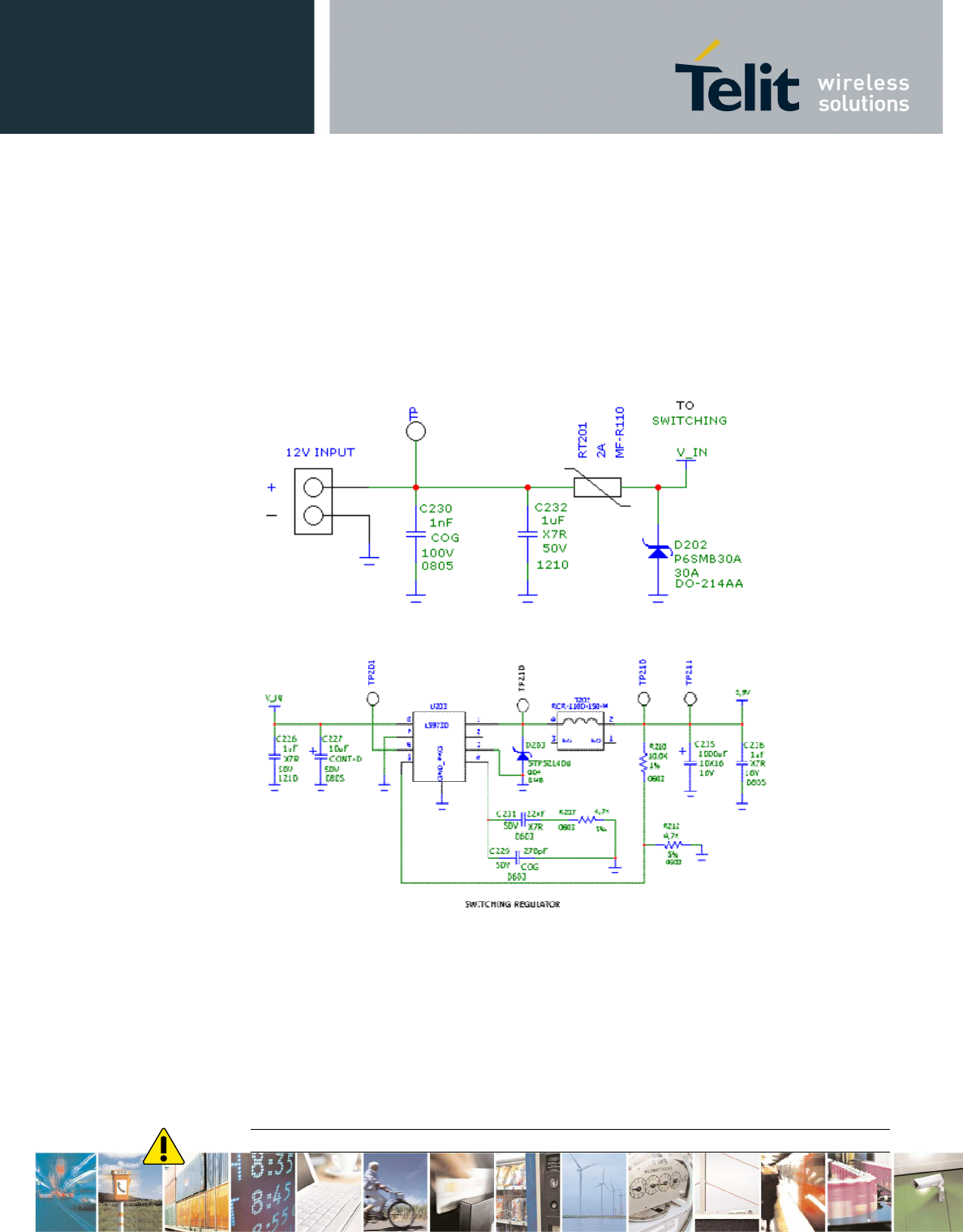
GE866-DUAL Hardware User Guide
1VV0301051 Rev. 2 – 2014-04-07
7
Reproduction forbidden without written authorization from Telit Communications S.p.A. - All Rights
Reserved. Page 29 of 82
Mod. 0805 2011-07 Rev.2
inversion. This can be the same diode as for spike
protection.
An example of switching regulator with 12V input is in the
below schematic:
6.3.1.3. Battery Source Power Supply Design Guidelines
• The desired nominal output for the power supply is 3.8V and
the maximum voltage allowed is 4.2V, hence a single 3.7V
Li-Ion cell battery type is suited for supplying the power
to the Telit GE866-QUAD module.
WARNING:

GE866-DUAL Hardware User Guide
1VV0301051 Rev. 2 – 2014-04-07
7
Reproduction forbidden without written authorization from Telit Communications S.p.A. - All Rights
Reserved. Page 30 of 82
Mod. 0805 2011-07 Rev.2
The three cells Ni/Cd or Ni/MH 3.6 V Nom. battery types or 4V
PB types MUST NOT BE USED DIRECTLY since their maximum voltage
can rise over the absolute maximum voltage for the GE866-QUAD
and damage it.
NOTE:
DON'T USE any Ni-Cd, Ni-MH, and Pb battery types directly
connected with GE866-QUAD. Their use can lead to overvoltage
on the GE866-QUAD and damage it. USE ONLY Li-Ion battery types.
• A Bypass low ESR capacitor of adequate capacity must be
provided in order to cut the current absorption peaks, a
100µF tantalum capacitor is usually suited.
• Make sure the low ESR capacitor (usually a tantalum one) is
rated at least 10V.
• A protection diode should be inserted close to the power
input, in order to save the GE866-QUAD from power polarity
inversion. Otherwise the battery connector should be done
in a way to avoid polarity inversions when connecting the
battery.
• The battery capacity must be at least 500mAh in order to
withstand the current peaks of 2A; the suggested capacity
is from 500mAh to 1000mAh.
6.3.2. Thermal Design Guidelines
The thermal design for the power supply heat sink should be
done with the following specifications:
See Par. 6.2 Power Consumption
NOTE:
The average consumption during transmissions depends on the
power level at which the device is requested to transmit by
the network. The average current consumption hence varies
significantly.
Considering the very low current during idle, especially if
Power Saving function is enabled, it is possible to consider
from the thermal point of view that the device absorbs current
significantly only during calls.

GE866-DUAL Hardware User Guide
1VV0301051 Rev. 2 – 2014-04-07
7
Reproduction forbidden without written authorization from Telit Communications S.p.A. - All Rights
Reserved. Page 31 of 82
Mod. 0805 2011-07 Rev.2
For the heat generated by the GE866-QUAD, you can consider it
to be during transmission 1W max during CSD/VOICE calls and 2W
max during class10 GPRS upload.
This generated heat will be mostly conducted to the ground
plane under the GE866-QUAD; you must ensure that your
application can dissipate it.

GE866-DUAL Hardware User Guide
1VV0301051 Rev. 2 – 2014-04-07
7
Reproduction forbidden without written authorization from Telit Communications S.p.A. - All Rights
Reserved. Page 32 of 82
Mod. 0805 2011-07 Rev.2
6.3.3. Power Supply PCB layout Guidelines
As seen on the electrical design guidelines the power supply
shall have a low ESR capacitor on the output to cut the
current peaks and a protection diode on the input to protect
the supply from spikes and polarity inversion. The placement
of these components is crucial for the correct working of the
circuitry. A misplaced component can be useless or can even
decrease the power supply performance.
• The Bypass low ESR capacitor must be placed close to the
Telit GE866-QUAD power input pads or in the case the power
supply is a switching type it can be placed close to the
inductor to cut the ripple provided the PCB trace from the
capacitor to the GE866-QUAD is wide enough to ensure a
dropless connection even during the 2A current peaks.
• The protection diode must be placed close to the input
connector where the power source is drained.
• The PCB traces from the input connector to the power
regulator IC must be wide enough to ensure no voltage drops
occur when the 2A current peaks are absorbed. Note that this
is not made in order to save power loss but especially to
avoid the voltage drops on the power line at the current
peaks frequency of approx. 217 Hz that will reflect on all
the components connected to that supply, introducing the
noise floor at the burst base frequency. For this reason
while a voltage drop of 300-400 mV may be acceptable from
the power loss point of view, the same voltage drop may not
be acceptable from the noise point of view. If your
application doesn't have audio interface but only uses the
data feature of the Telit GE866-QUAD, then this noise is not
so disturbing and power supply layout design can be more
forgiving.
• The PCB traces to the GE866-QUAD and the Bypass capacitor
must be wide enough to ensure no significant voltage drops
occur when the 2A current peaks are absorbed. This is for
the same reason as previous point. Try to keep this trace as
short as possible.
• The PCB traces connecting the Switching output to the
inductor and the switching diode must be kept as short as
possible by placing the inductor and the diode very close to
the power switching IC (only for switching power supply).
This is done in order to reduce the radiated field (noise)
at the switching frequency (100-500 kHz usually).
• The use of a good common ground plane is suggested.

GE866-DUAL Hardware User Guide
1VV0301051 Rev. 2 – 2014-04-07
7
Reproduction forbidden without written authorization from Telit Communications S.p.A. - All Rights
Reserved. Page 33 of 82
Mod. 0805 2011-07 Rev.2
• The placement of the power supply on the board should be
done in such a way to guarantee that the high current return
paths in the ground plane are not overlapped to any noise
sensitive circuitry as the microphone amplifier/buffer or
earphone amplifier.
• The power supply input cables should be kept separate from
noise sensitive lines such as microphone/earphone cables.
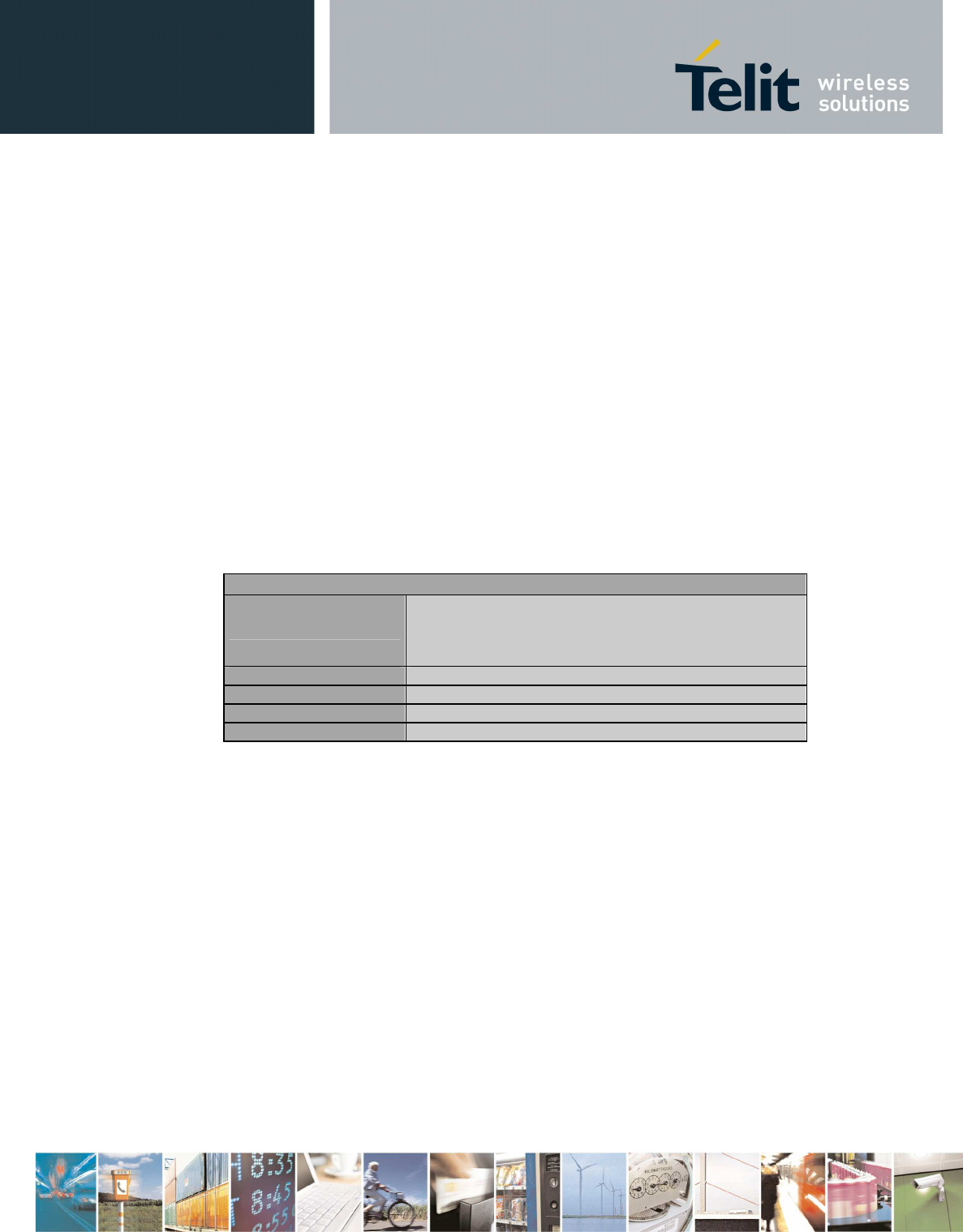
GE866-DUAL Hardware User Guide
1VV0301051 Rev. 2 – 2014-04-07
7
Reproduction forbidden without written authorization from Telit Communications S.p.A. - All Rights
Reserved. Page 34 of 82
Mod. 0805 2011-07 Rev.2
7. Antenna
The antenna connection and board layout design are the most
important aspect in the full product design as they strongly
affect the product overall performance, hence read carefully
and follow the requirements and the guidelines for a proper
design.
7.1. GSM Antenna Requirements
As suggested on the Product Description the antenna and
antenna transmission line on PCB for a Telit GE866-QUAD device
shall fulfill the following requirements:
ANTENNA REQUIREMENTS
Frequency range
824
-
894 MHz GSM850 band
880-960 MHz GSM900 band
1710-1885MHz DCS1800 band
1850-1990MHz PCS1900 band
Impedance
50 Ohm
Input power
> 2 W
VSWR absolute max ≤ 10:1 (limit to avoid permanent damage)
VSWR recommended ≤ 2:1 (limit to fulfill all regulatory requirements)
Furthermore if the devices are developed for the US market
and/or Canada market they shall comply to the FCC and/or IC
approval requirements:
Those devices are to be used only for mobile and fixed
application. The antenna(s) used for this transmitter must be
installed to provide a separation distance of at least 20 cm
from all persons and must not be co-located or operating in
conjunction with any other antenna or transmitter. End-Users
must be provided with transmitter operation conditions for
satisfying RF exposure compliance. OEM integrators must ensure
that the end user has no manual instructions to remove or
install the GE866-QUAD. Antennas used for those OEM modules
must not exceed 3dBi gain for mobile and fixed operating
configurations.
7.1.1. GE866-QUAD Antenna – PCB line Guidelines
When using the Telit GE866-QUAD module, since there's no
antenna connector on the module, the antenna must be connected
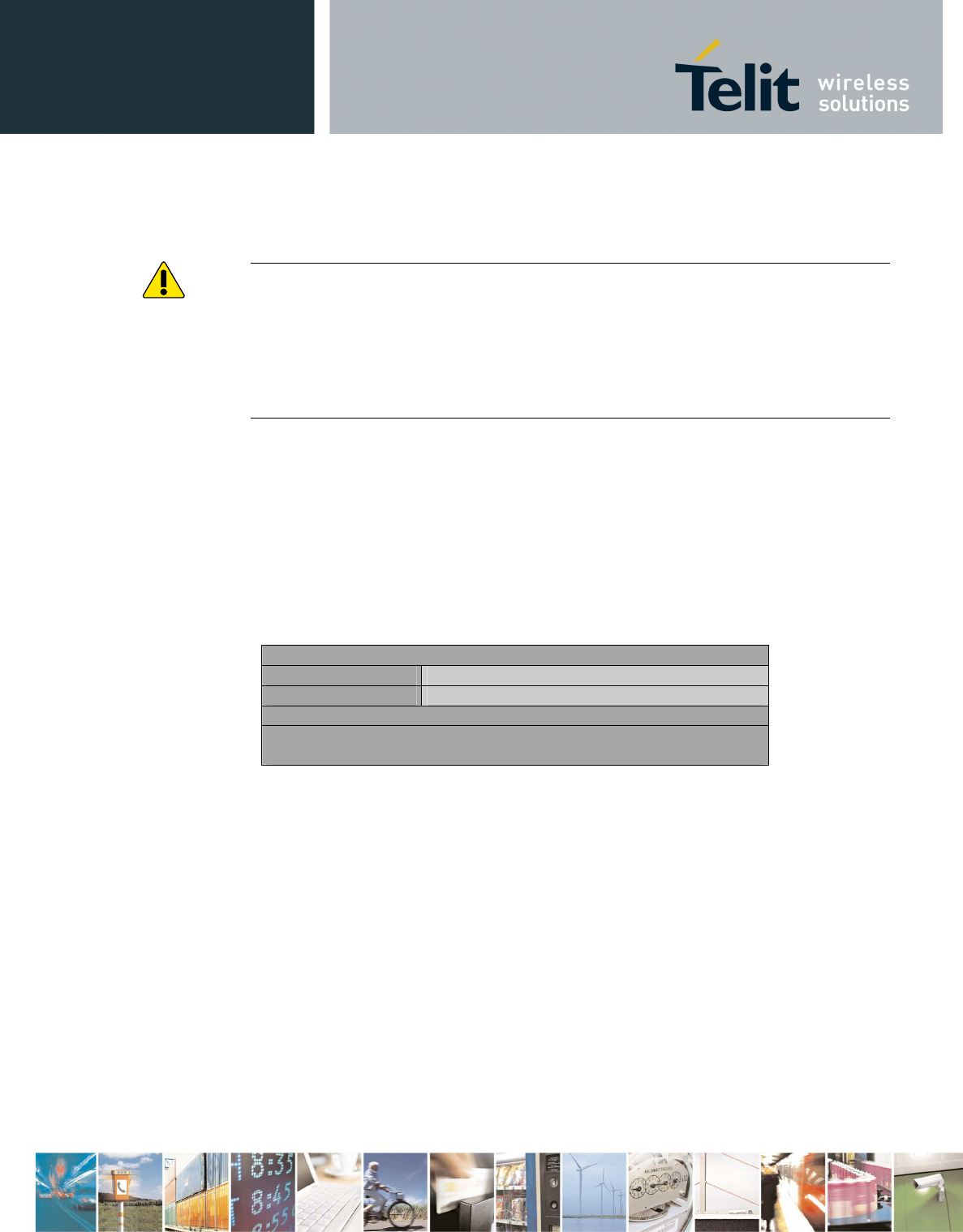
GE866-DUAL Hardware User Guide
1VV0301051 Rev. 2 – 2014-04-07
7
Reproduction forbidden without written authorization from Telit Communications S.p.A. - All Rights
Reserved. Page 35 of 82
Mod. 0805 2011-07 Rev.2
to the GE866-QUAD through the PCB with the antenna pad (pin
G2).
WARNING:
High Frequency harmonics may still not be sufficiently
attenuated in the GE866’s small package. The suggested Pi
network, between antenna output of the module and antenna
connector on application board, is used to meet the standard
specifications.
In first designs its use is strongly recommended.
In the case that the antenna is not directly developed on the
same PCB, hence directly connected at the antenna pad of the
GE866-QUAD, then a PCB line is needed in order to connect with
it or with its connector.
This transmission line shall fulfill the following
requirements:
ANTENNA LINE ON PCB REQUIREMENTS
Impedance 50 ohm
Max Attenuation 0,3 dB
No coupling with other signals allowed
Cold End (Ground Plane) of antenna shall be equipotential to the
GE866-QUAD ground pins
This transmission line should be designed according to the
following guidelines:
• Ensure that the antenna line impedance is 50 ohm;
• Keep the antenna line on the PCB as short as possible, since
the antenna line loss shall be less than 0,3 dB;
• Antenna line must have uniform characteristics, constant
cross section, avoid meanders and abrupt curves;
• Keep, if possible, one layer of the PCB used only for the
Ground plane;
• Surround (on the sides, over and under) the antenna line on
PCB with Ground, avoid having other signal tracks facing
directly the antenna line track;

GE866-DUAL Hardware User Guide
1VV0301051 Rev. 2 – 2014-04-07
7
Reproduction forbidden without written authorization from Telit Communications S.p.A. - All Rights
Reserved. Page 36 of 82
Mod. 0805 2011-07 Rev.2
• The ground around the antenna line on PCB has to be strictly
connected to the Ground Plane by placing vias every 2mm at
least;
• Place EM noisy devices as far as possible from GE866-QUAD
antenna line;
• Keep the antenna line far away from the GE866-QUAD power
supply lines;
• If you have EM noisy devices around the PCB hosting the
GE866-QUAD, such as fast switching ICs, take care of the
shielding of the antenna line by burying it inside the
layers of PCB and surround it with Ground planes, or shield
it with a metal frame cover.
• If you don't have EM noisy devices around the PCB of GE866-
QUAD, by using a micro strip on the superficial copper layer
for the antenna line, the line attenuation will be lower
than a buried one.
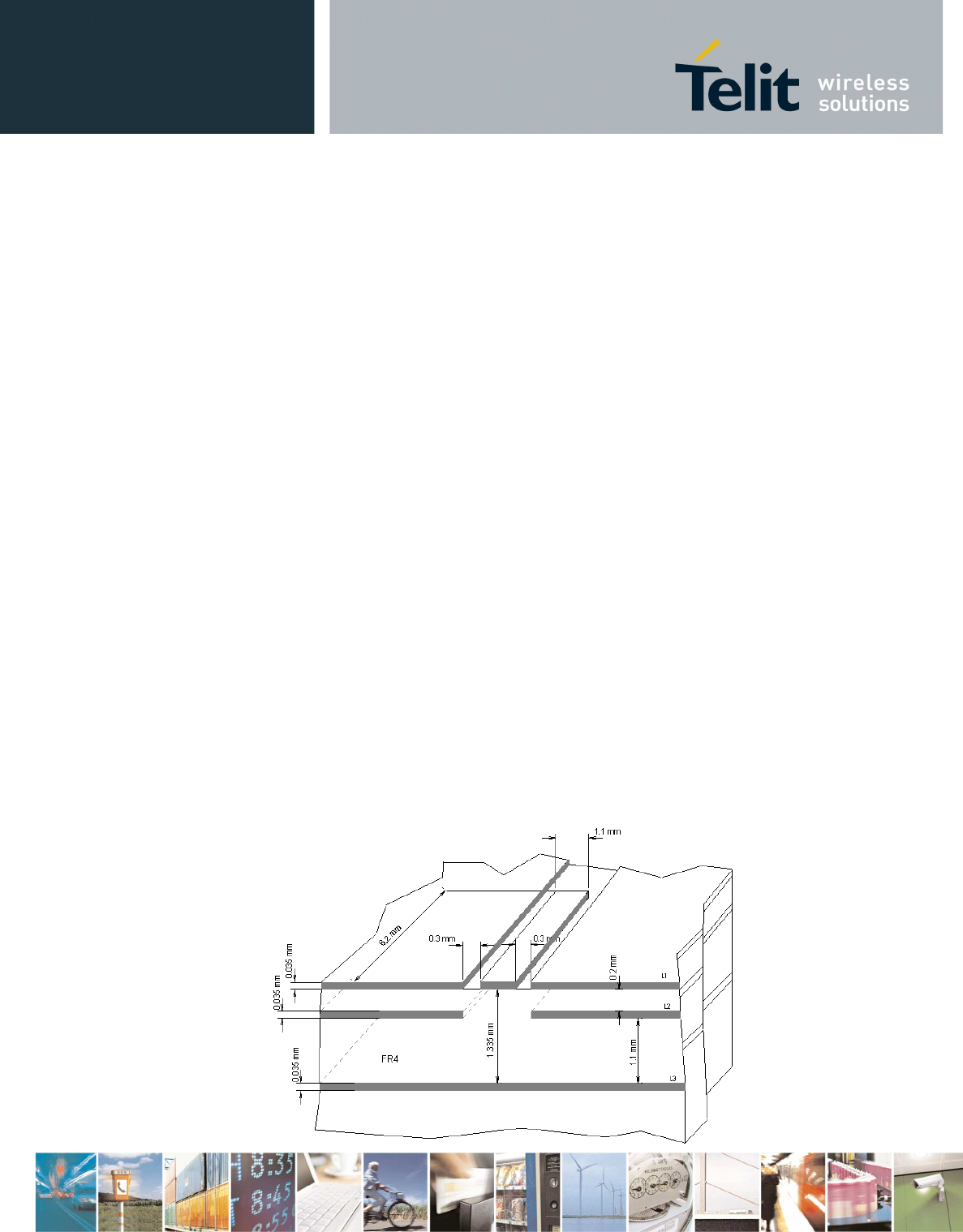
GE866-DUAL Hardware User Guide
1VV0301051 Rev. 2 – 2014-04-07
7
Reproduction forbidden without written authorization from Telit Communications S.p.A. - All Rights
Reserved. Page 37 of 82
Mod. 0805 2011-07 Rev.2
7.2. PCB Design Guidelines
This section explains the suggested design for the
transmission line on the customer’s application board.
7.2.1. Transmission line design
During the design of the GE866-QUAD interface board, the
placement of components has been chosen properly, in order to
keep the line length as short as possible, thus leading to
lowest power losses possible. A Grounded Coplanar Waveguide
(G-CPW) line has been chosen, since this kind of transmission
line ensures good impedance control and can be implemented in
an outer PCB layer as needed in this case. A SMA female
connector has been used to feed the line.
The interface board is realized on a FR4, 4-layers PCB.
Substrate material is characterized by relative permittivity
εr = 4.6 ± 0.4 @ 1 GHz, TanD= 0.019 ÷ 0.026 @ 1 GHz.
A characteristic impedance of nearly 50 Ω is achieved using
trace width = 1.1 mm, clearance from coplanar ground plane =
0.3 mm each side. The line uses reference ground plane on
layer 3, while copper is removed from layer 2 underneath the
line. Height of trace above ground plane is 1.335 mm.
Calculated characteristic impedance is 51.6 Ω, estimated line
loss is less than 0.1 dB. The line geometry is shown below:
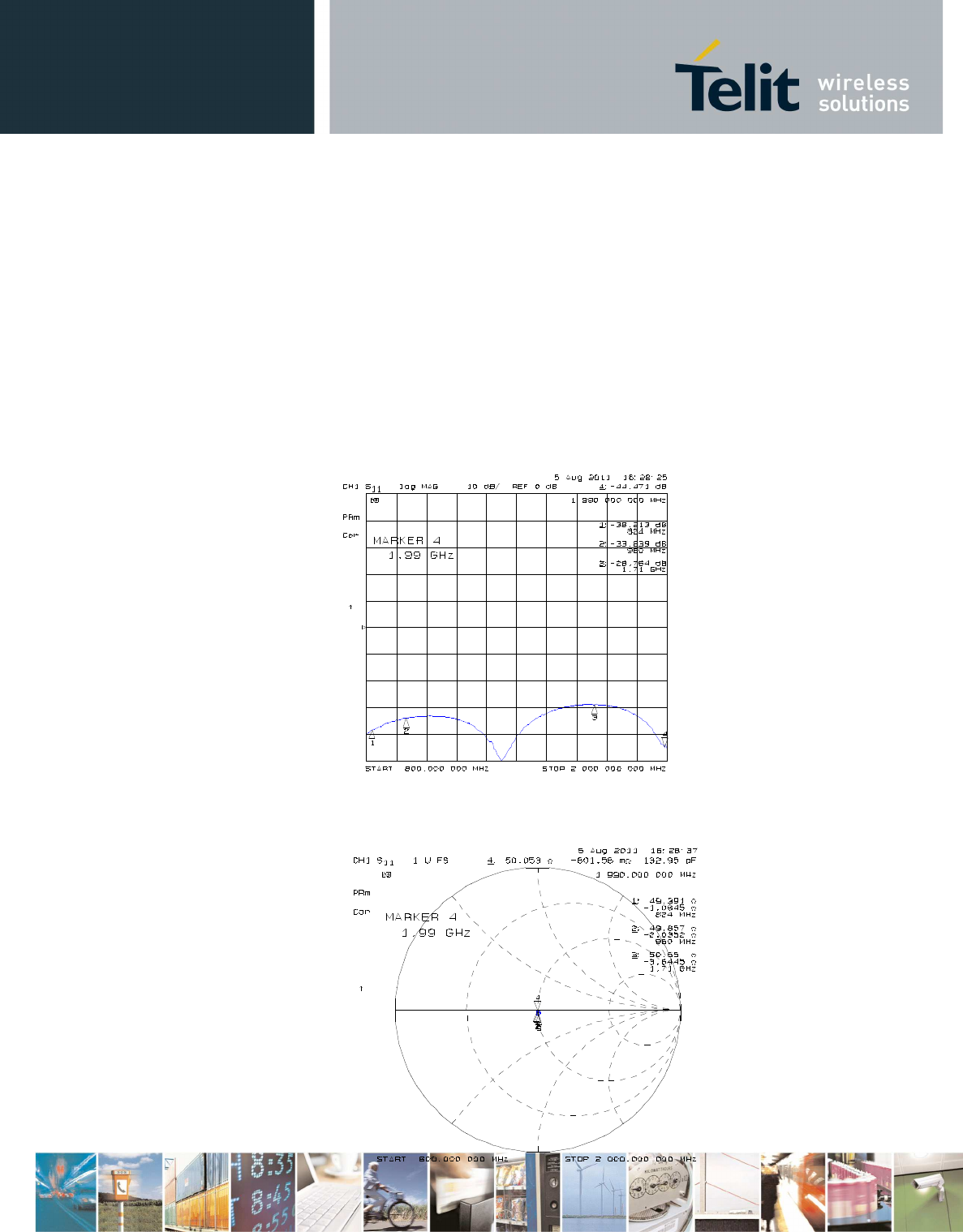
GE866-DUAL Hardware User Guide
1VV0301051 Rev. 2 – 2014-04-07
7
Reproduction forbidden without written authorization from Telit Communications S.p.A. - All Rights
Reserved. Page 38 of 82
Mod. 0805 2011-07 Rev.2
7.2.2. Transmission line measurements
HP8753E VNA (Full-2-port calibration) has been used in this
measurement session. A calibrated coaxial cable has been
soldered at the pad corresponding to GE866-QUAD RF output; a
SMA connector has been soldered to the board in order to
characterize the losses of the transmission line including the
connector itself. During Return Loss / impedance measurements,
the transmission line has been terminated to 50 Ω load.
Return Loss plot of line under test is shown below:
Line input impedance (in Smith Chart format, once the line has
been terminated to 50 Ω load) is shown in the following
figure:
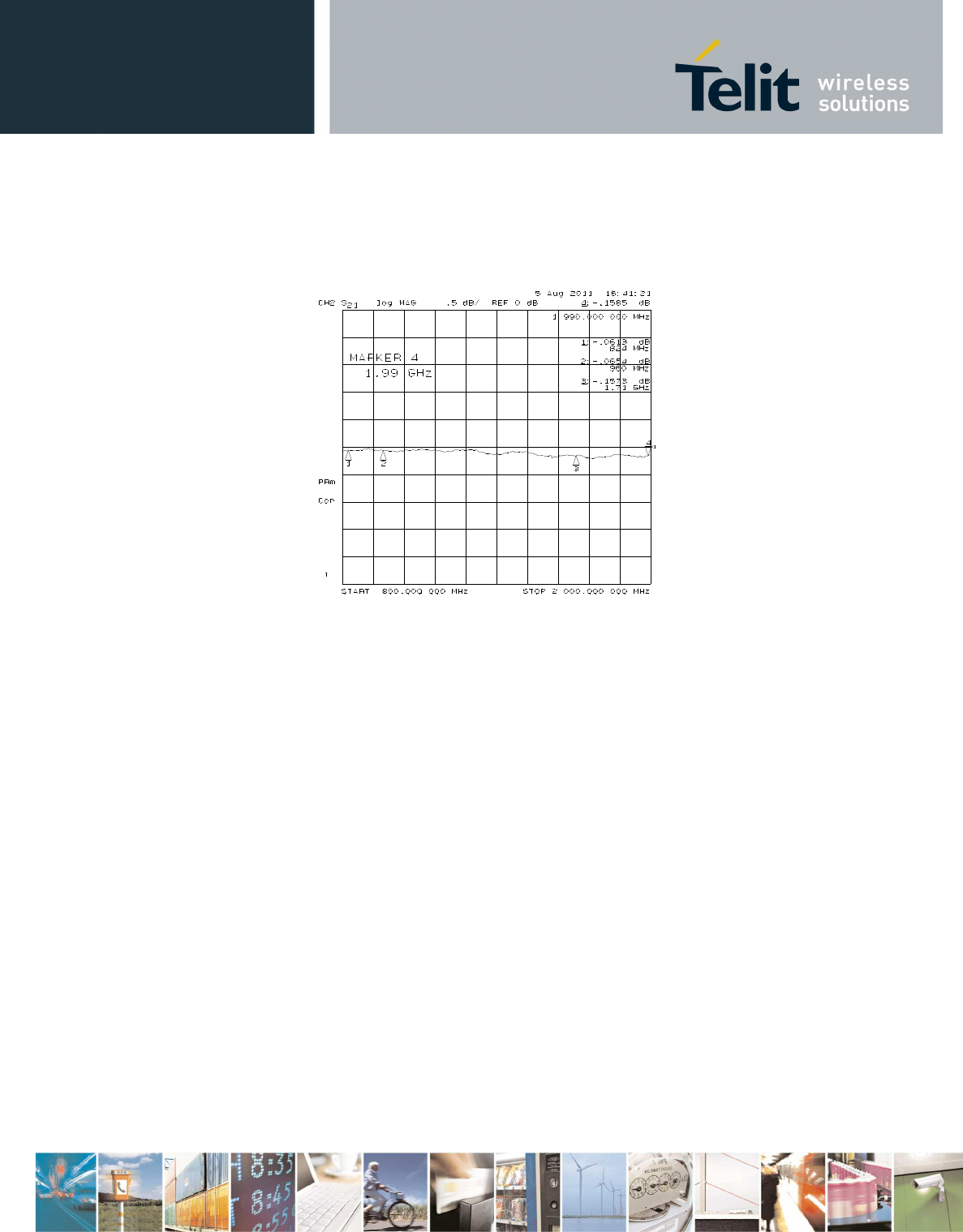
GE866-DUAL Hardware User Guide
1VV0301051 Rev. 2 – 2014-04-07
7
Reproduction forbidden without written authorization from Telit Communications S.p.A. - All Rights
Reserved. Page 39 of 82
Mod. 0805 2011-07 Rev.2
Insertion Loss of G-CPW line plus SMA connector is shown
below:
7.3. GSM Antenna - installation Guidelines
• Install the antenna in a place covered by the GSM signal.
• Antenna shall not be installed inside metal cases
• Antenna shall be installed also according to antenna
manufacturer instructions.
• Ddd Installation should also take in account the R&TTE
requirements described in the “Conformity Assessment Issues”
chapter
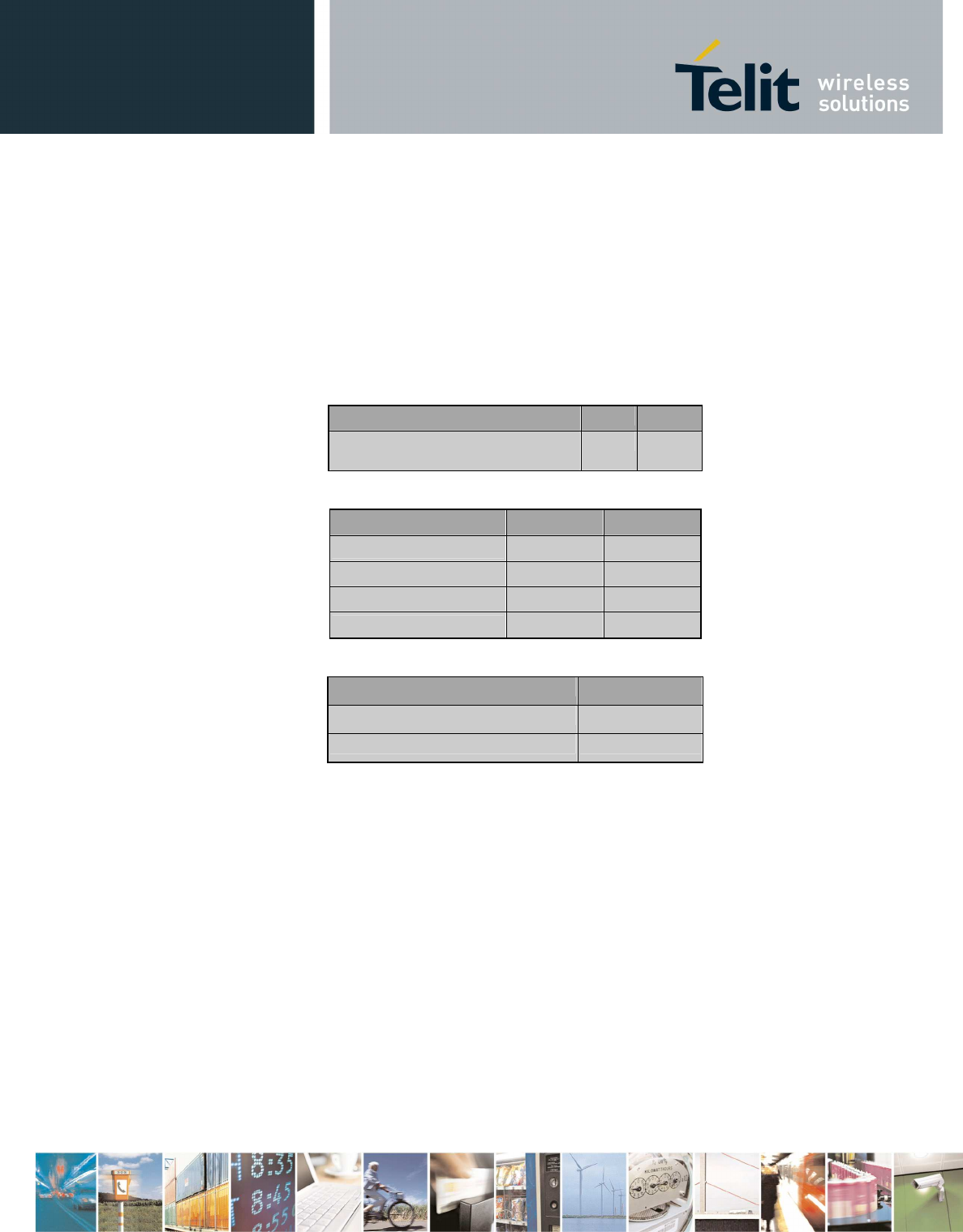
GE866-DUAL Hardware User Guide
1VV0301051 Rev. 2 – 2014-04-07
7
Reproduction forbidden without written authorization from Telit Communications S.p.A. - All Rights
Reserved. Page 40 of 82
Mod. 0805 2011-07 Rev.2
8. Logic levels specifications
Where not specifically stated, all the interface circuits work
at 1.8V CMOS logic levels. The following table shows the logic
level specifications used in the GE866-QUAD interface
circuits:
Parameter Min Max
Input level on any digital pin
(CMOS 1.8) when on
-0.3V
+2.1V
Level Min Max
Input high level 1.3V 1.9V
Input low level 0V 0.35V
Output high level 1.6V 1.9V
Output low level 0V 0.2V
Level Typical
Output Current 1mA
Input Current 1uA
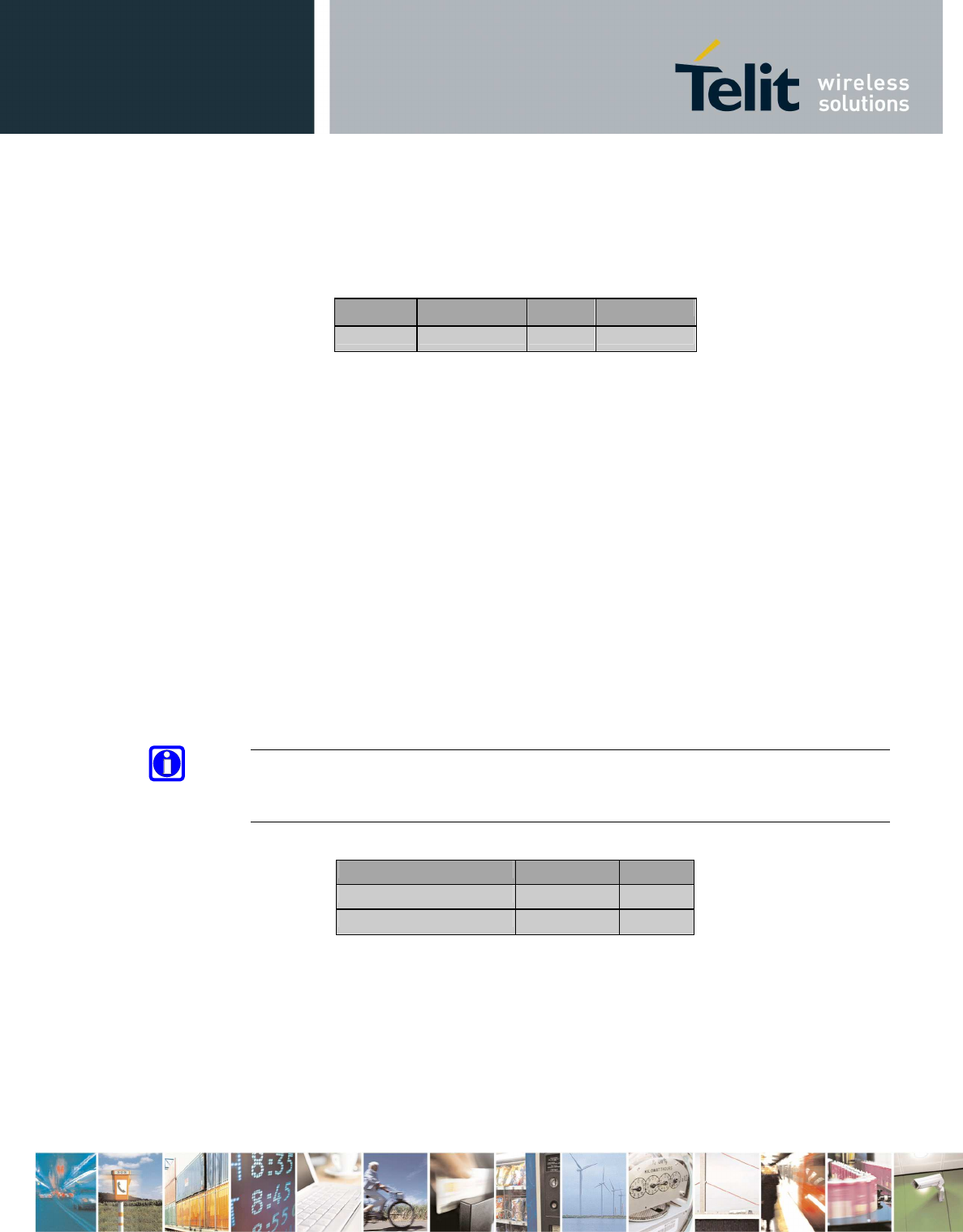
GE866-DUAL Hardware User Guide
1VV0301051 Rev. 2 – 2014-04-07
7
Reproduction forbidden without written authorization from Telit Communications S.p.A. - All Rights
Reserved. Page 41 of 82
Mod. 0805 2011-07 Rev.2
8.1. Reset signal
Signal Function I/O pin
RESET* Phone reset I G4
RESET* is used to reset the GE866-QUAD. Whenever this signal
is pulled low, the GE866-QUAD is reset. When the device is
reset it stops any operation. After the release of the reset
GE866-QUAD is unconditionally shut down, without doing any
detach operation from the network where it is registered. This
behaviour is not a proper shut down because any GSM device is
requested to issue a detach request on turn off. For this
reason the Reset signal must not be used to normally shutting
down the device, but only as an emergency exit in the rare
case the device remains stuck waiting for some network
response.
The RESET* is internally controlled on start-up to achieve a
proper power-on reset sequence, so there's no need to control
this pin on start-up. It may only be used to reset a device
already on that is not responding to any command.
NOTE:
Do not use this signal to power OFF the GE866-QUAD. Use the
ON/OFF procedure to perform this function.
Signal Min Max
RESET* Input high 1.8V(NOTE1) 2.1V
RESET* Input low
0V
0
.2V
(NOTE1) this signal is internally pulled up so the pin can be
left floating if not used.
If unused, this signal may be left unconnected. If used, then
it must always be connected with an open collector transistor,
to permit to the internal circuitry the power on reset and
under voltage lockout functions.

GE866-DUAL Hardware User Guide
1VV0301051 Rev. 2 – 2014-04-07
7
Reproduction forbidden without written authorization from Telit Communications S.p.A. - All Rights
Reserved. Page 42 of 82
Mod. 0805 2011-07 Rev.2
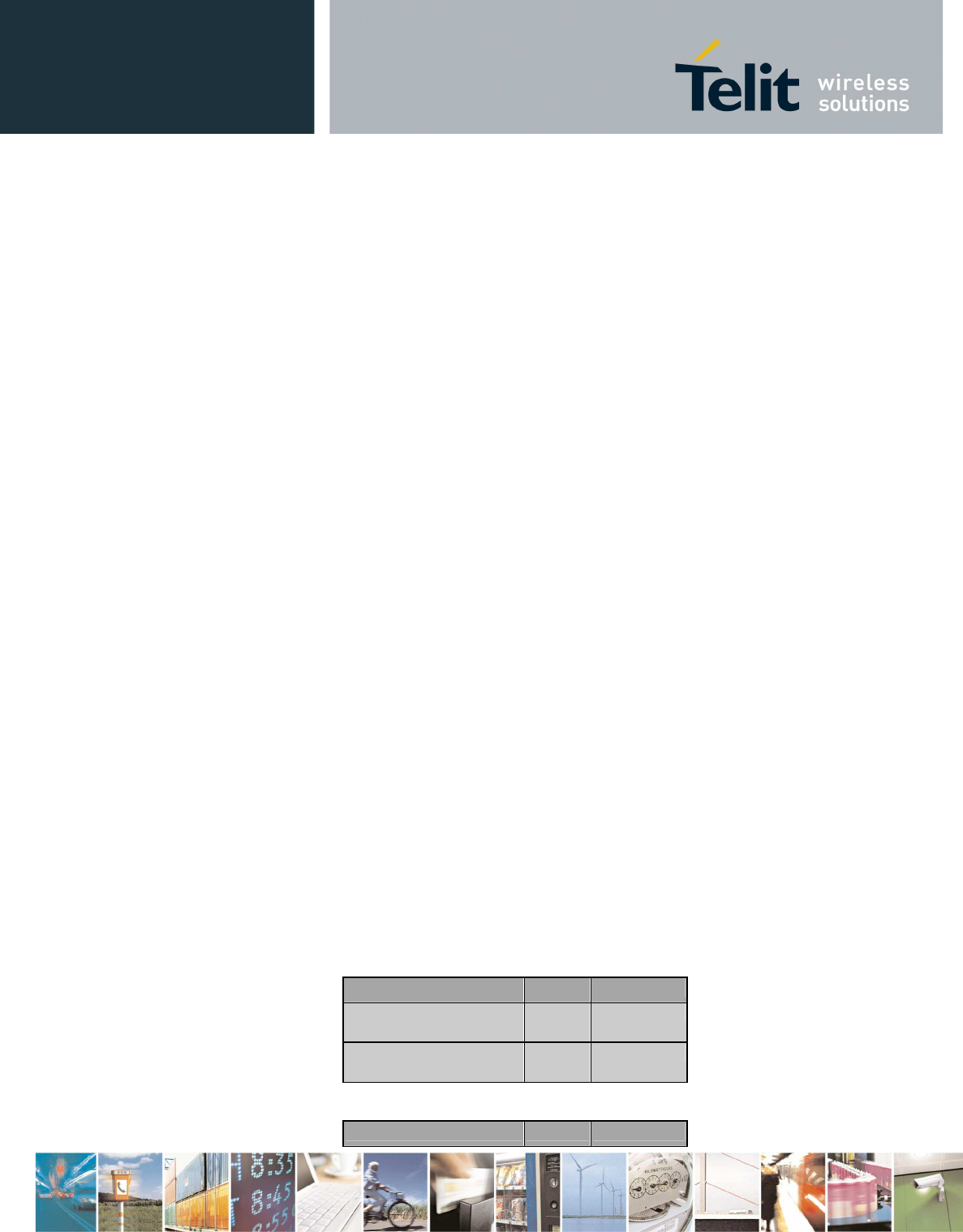
GE866-DUAL Hardware User Guide
1VV0301051 Rev. 2 – 2014-04-07
7
Reproduction forbidden without written authorization from Telit Communications S.p.A. - All Rights
Reserved. Page 43 of 82
Mod. 0805 2011-07 Rev.2
9. Serial Ports
The serial port on the GE866-QUAD is the core of the interface
between the module and OEM hardware.
2 serial ports are available on the module:
• MODEM SERIAL PORT 1 (Main, ASC0)
• MODEM SERIAL PORT 2 (Auxiliary, ASC1)
9.1. Modem Serial Port
Several configurations can be designed for the serial port on
the OEM hardware, but the most common are:
• RS232 PC com port
• microcontroller UART @ 1.8V (Universal Asynchronous Receive
Transmit)
• microcontroller UART @ 3V or other voltages different from
1.8V
• microcontroller UART @ 5V or other voltages different from
1.8V
Depending from the type of serial port on the OEM hardware a
level translator circuit may be needed to make the system work.
The only configuration that doesn't need a level translation
is the 1.8V UART.
The serial port on the GE866-QUAD is a +1.8V UART with all the
8 RS232 signals. It differs from the PC-RS232 in the signal
polarity (RS232 is reversed) and levels. The levels for the
GE866-QUAD UART are the CMOS levels:
Parameter Min Max
Input level on any digital
pad when on
-0.3V +2.1V
Input voltage on analog
pads when on -0.3V +2.1V
Level Min Max
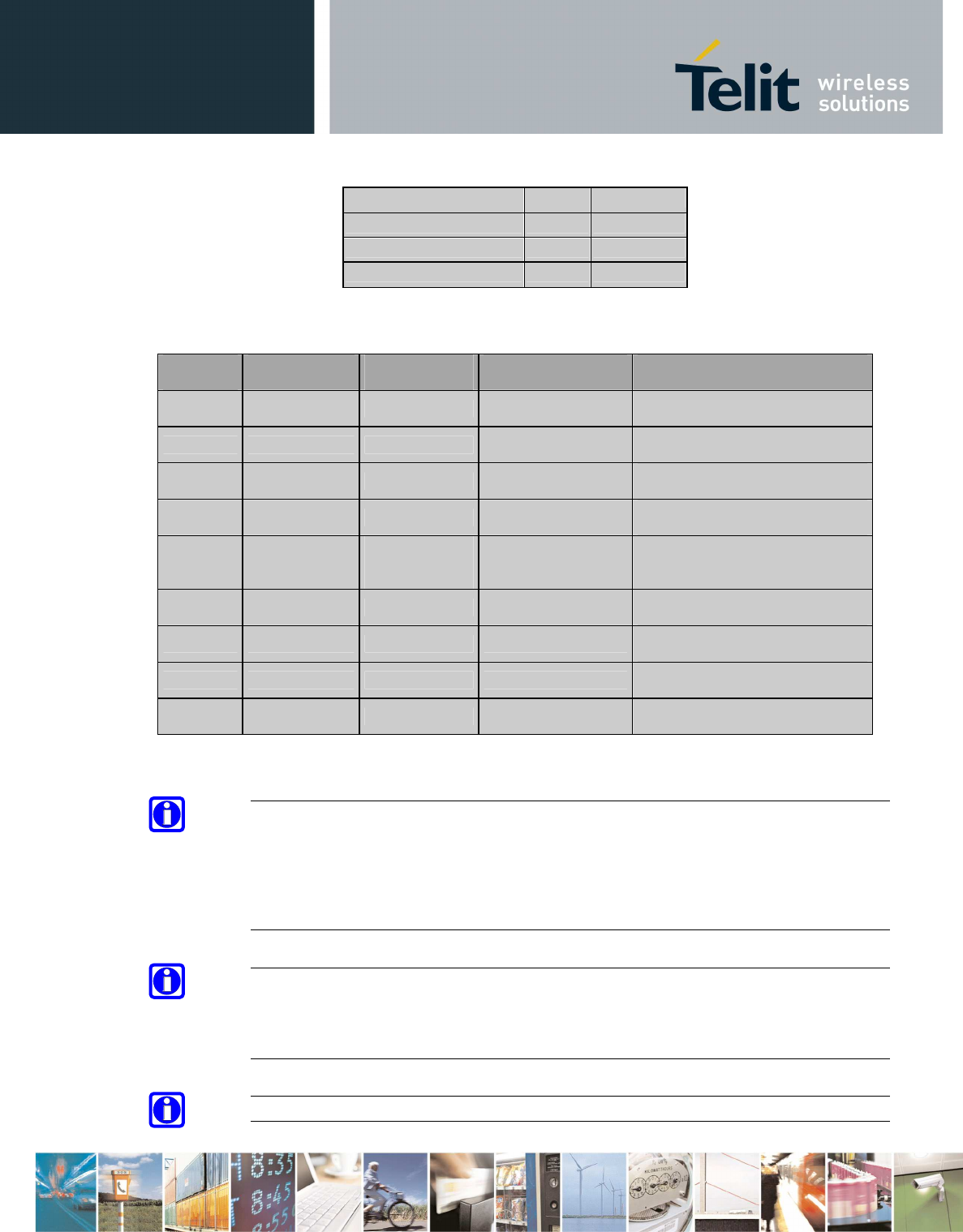
GE866-DUAL Hardware User Guide
1VV0301051 Rev. 2 – 2014-04-07
7
Reproduction forbidden without written authorization from Telit Communications S.p.A. - All Rights
Reserved. Page 44 of 82
Mod. 0805 2011-07 Rev.2
Input high level V
IH
1.5V 1.9V
Input low level V
IL
0V 0.35V
Output high level V
OH
1.6V 1.9V
Output low level V
OL
0V 0.2V
The signals of the GE866-QUAD serial port are:
RS232 Pin
Number Signal GE866-QUAD
Pad Number Name Usage
1 DCD - dcd_uart B2 Data Carrier Detect
Output from the
GE866
-
QUAD
that
indicates the carrier presence
2 RXD - tx_uart A5 Transmit line *see
Note Output transmit line of GE866-
QUAD UART
3 TXD - rx_uart A4 Receive line *see Note
Input receive of the
GE866
-
QUAD
UART
4 DTR - dtr_uart A2 Data Terminal Ready Input to the GE866-QUAD that
controls the DTE READY condition
5 GND D1, F1, G1, D2,
F2, C2, E3, F3,
G3 Ground Ground
6 DSR - dsr_uart A3 Data Set Ready Output from the GE866-QUAD that
indicates the module is ready
7 RTS - rts_uart A1 Request to Send
Input to the
GE866
-
QUAD
that
controls the Hardware flow control
8 CTS - cts_uart B1 Clear to Send Output from the GE866-QUAD that
controls the Hardware flow control
9 RI - ri_uart B3 Ring Indicator
Output from the
GE866
-
QUAD
that
indicates the incoming call condition
NOTE:
According to V.24, RX/TX signal names are referred to the
application side, therefore on the GE866-QUAD side these
signal are on the opposite direction: TXD on the application
side will be connected to the receive line (here named TXD/
rx_uart ) of the GE866-QUAD serial port and vice versa for RX.
NOTE:
For a minimum implementation, only the TXD and RXD lines can
be connected, the other lines can be left open provided a
software flow control is implemented.
NOTE:

GE866-DUAL Hardware User Guide
1VV0301051 Rev. 2 – 2014-04-07
7
Reproduction forbidden without written authorization from Telit Communications S.p.A. - All Rights
Reserved. Page 45 of 82
Mod. 0805 2011-07 Rev.2
In order to avoid a back powering effect it is recommended to
avoid having any HIGH logic level signal applied to the
digital pins of the GE866-QUAD when the module is powered off
or during an ON/OFF transition.

GE866-DUAL Hardware User Guide
1VV0301051 Rev. 2 – 2014-04-07
7
Reproduction forbidden without written authorization from Telit Communications S.p.A. - All Rights
Reserved. Page 46 of 82
Mod. 0805 2011-07 Rev.2
9.2. RS232 levels translation
In order to interface the GE866-QUAD with a PC com port or a
RS232 (EIA/TIA-232) application a level translator is
required. This level translator must:
• invert the electrical signal in both directions;
• change the level from 0/1.8V to +15/-15V
Actually, the RS232 UART 16450, 16550, 16650 & 16750 chipsets
accept signals with lower levels on the RS232 side (EIA/TIA-
562), allowing a lower voltage-multiplying ratio on the level
translator. Note that the negative signal voltage must be less
than 0V and hence some sort of level translation is always
required.
The simplest way to translate the levels and invert the signal
is by using a single chip level translator. There are a
multitude of them, differing in the number of drivers and
receivers and in the levels (be sure to get a true RS232 level
translator not a RS485 or other standards).
By convention the driver is the level translator from the 0-
1.8V UART to the RS232 level. The receiver is the translator
from the RS232 level to 0-1.8V UART.
In order to translate the whole set of control lines of the
UART you will need:
• 5 drivers
• 3 receivers
NOTE:
The digital input lines working at 1.8V CMOS have an absolute
maximum input voltage of 2.1V; therefore the level translator
IC shall not be powered by the +3.8V supply of the module.
Instead, it must be powered from a +1.8V (dedicated) power
supply.
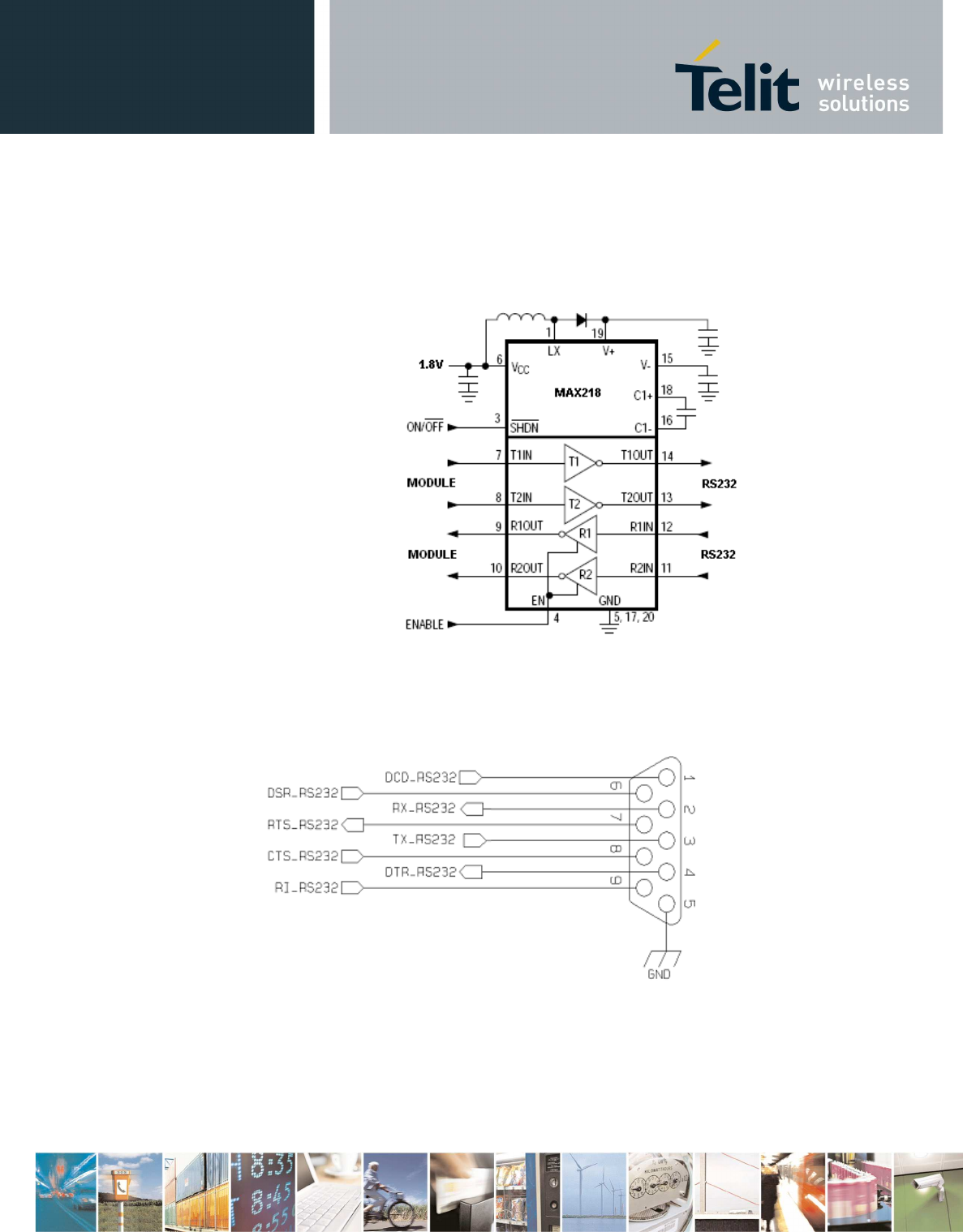
GE866-DUAL Hardware User Guide
1VV0301051 Rev. 2 – 2014-04-07
7
Reproduction forbidden without written authorization from Telit Communications S.p.A. - All Rights
Reserved. Page 47 of 82
Mod. 0805 2011-07 Rev.2
An example of RS232 level adaptation circuitry could be done
using a MAXIM transceiver (MAX218).
In this case the chipset is capable to translate directly from
0/1.8V to the RS232 levels (Example done on 4 signals only).
The RS232 serial port lines are usually connected to a DB9
connector with the following layout:
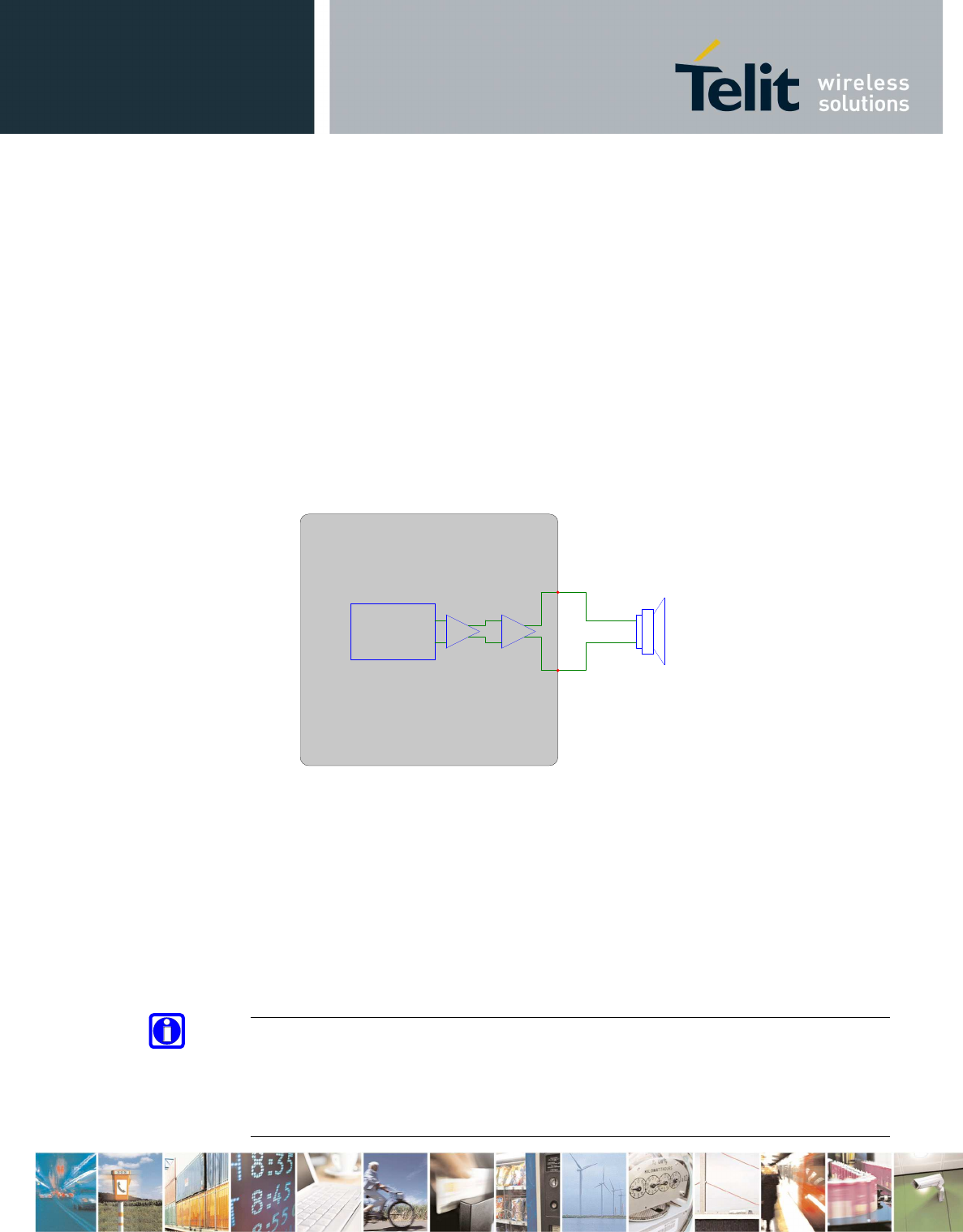
GE866-DUAL Hardware User Guide
1VV0301051 Rev. 2 – 2014-04-07
7
Reproduction forbidden without written authorization from Telit Communications S.p.A. - All Rights
Reserved. Page 48 of 82
Mod. 0805 2011-07 Rev.2
10. Audio Section Overview
10.1. MIC Connection
The Base Band Chip of the GE866-QUAD provides one input for
audio to be transmitted (Uplink).
10.2. EAR Connection
The audio output of the GE866-QUAD is balanced, this is
helpful to double the level and to reject common mode (click
and pop are common mode and therefore rejected); furthermore
the output stage is class-D, so it can manage directly a
loudspeaker with electrical impedance of at least 8Ohm. This
stage is powered by switching from Vbatt to gnd at a frequency
ranging from 0.6 to 2MHz, so it has a good efficiency and thus
a big power budget 0.7W; being a class-D architecture, please
use some caution (see the NOTE below).
NOTE:
When the loudspeaker is connected with a long cable, an L-C
filter is recommended.
When the EAR+/- are feeding some electronic circuitry, an R-C
filter is recommended.
EAR+
EAR-
TELIT MODU
LE
-
+
OUTPUT
DAC
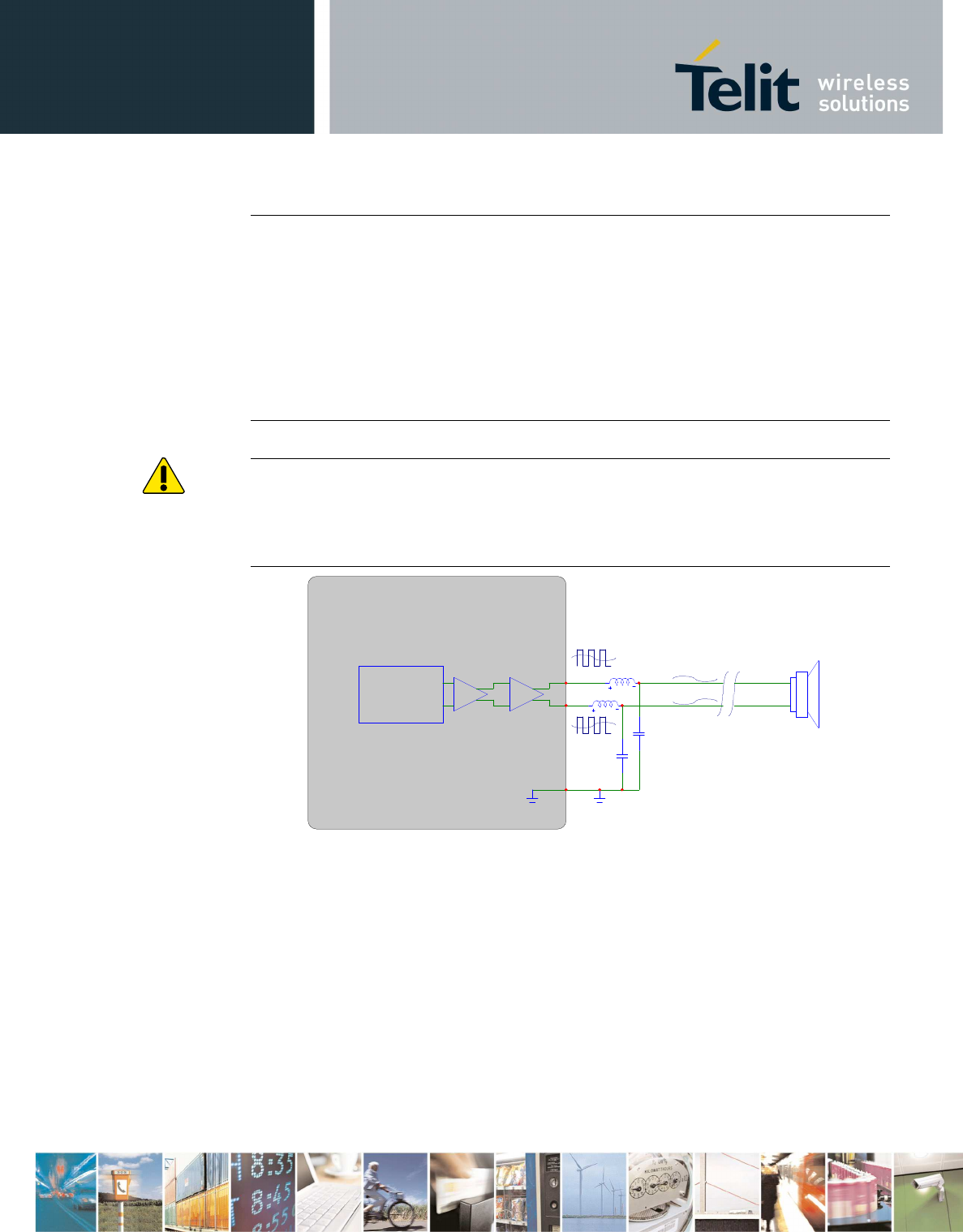
GE866-DUAL Hardware User Guide
1VV0301051 Rev. 2 – 2014-04-07
7
Reproduction forbidden without written authorization from Telit Communications S.p.A. - All Rights
Reserved. Page 49 of 82
Mod. 0805 2011-07 Rev.2
TIP:
In order to get the maximum audio level at a given output
voltage level (dBspl/Vrms), the following breaking through
procedure can be used. Have the loudspeaker as close as you
can to the listener (this simplify also the echo cancelling);
choose the loudspeaker with the higher sensitivity (dBspl per
W); choose loudspeakers with the impedance close to the limit
(ex: 16 or 8 Ohm), in order to feed more power inside the
transducer (it increases the W/Vrms ratio). If this were not
enough, an external amplifier should be used.
WARNING:
This The audio output hardware of the GE866-QUAD is based on a
Class-D amplifier so any singled-end output configuration MUST
NOT BE USED, otherwise the presence of GSM buzzing and low
level audio performance will result.
L-C filtering for LOW impedance load.
EAR+
EAR
-
TELIT MODULE
-
+
OUTPUT
DAC
GND
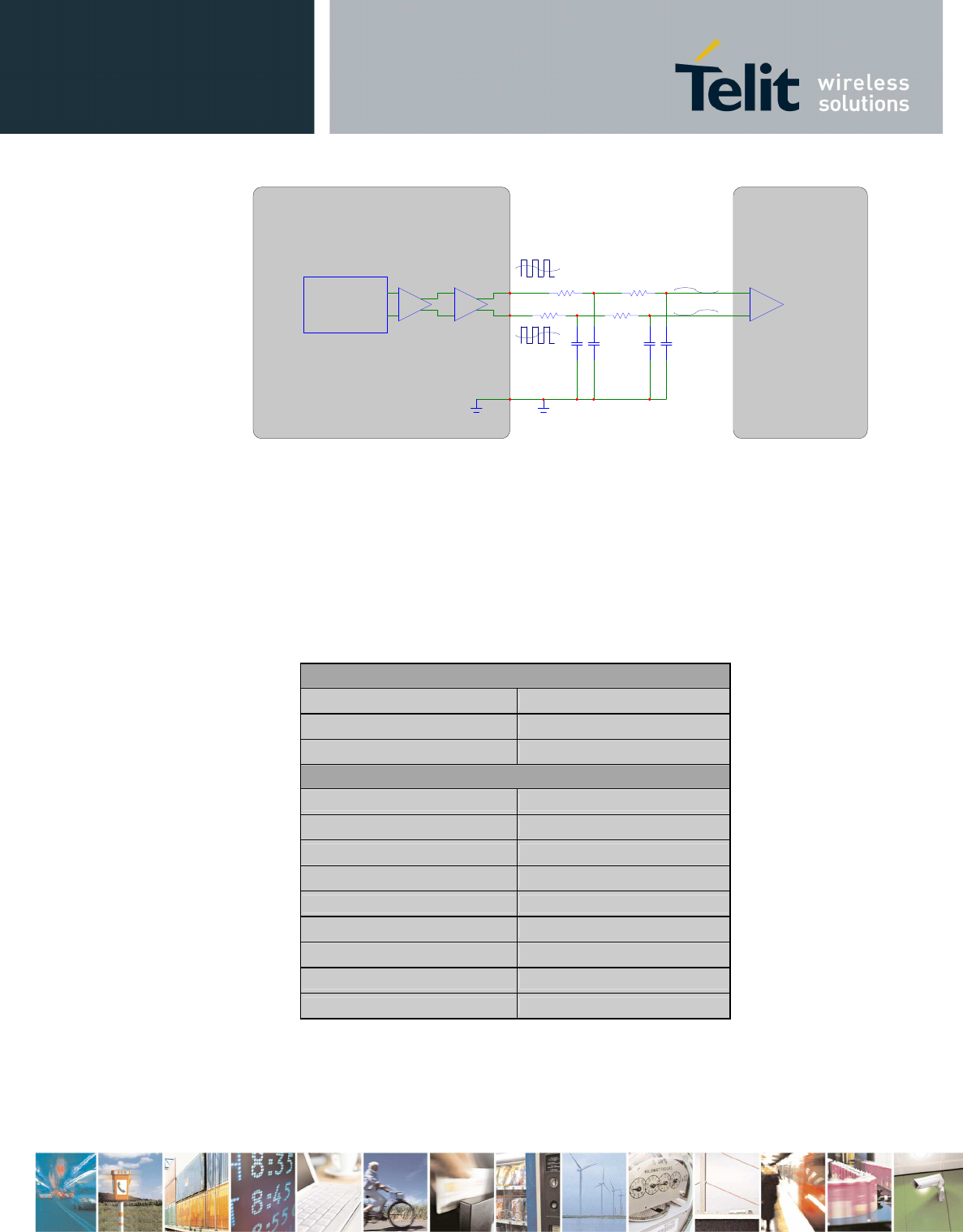
GE866-DUAL Hardware User Guide
1VV0301051 Rev. 2 – 2014-04-07
7
Reproduction forbidden without written authorization from Telit Communications S.p.A. - All Rights
Reserved. Page 50 of 82
Mod. 0805 2011-07 Rev.2
R-C filtering for HIGH impedance load.
10.3. Electrical Characteristics
10.3.1. Input lines
Microphone/Line-in path
Line Type Differential
Coupling capacitor ≥ 100nF
Differential input resistance 50kΩ
Levels
To have 0 dBfs @1KHz
(*)
Differential input voltage
MIC Gain = 0dB 290mVrms
MIC Gain = +6dB 145mVrms
MIC Gain = +12dB 72mVrms
MIC Gain = +18dB 36mVrms
MIC Gain = +24dB 18mVrms
MIC Gain = +30dB 9mVrms
MIC Gain = +36dB 4.5mVrms
MIC Gain = +42dB 2.25mVrms
(*) 0 dBfs in the network are +3.14 dBm0
EAR+
EAR-
TELIT MODULE
-
+
OUTPUTDAC
GND
HiZ CIRCUITRY
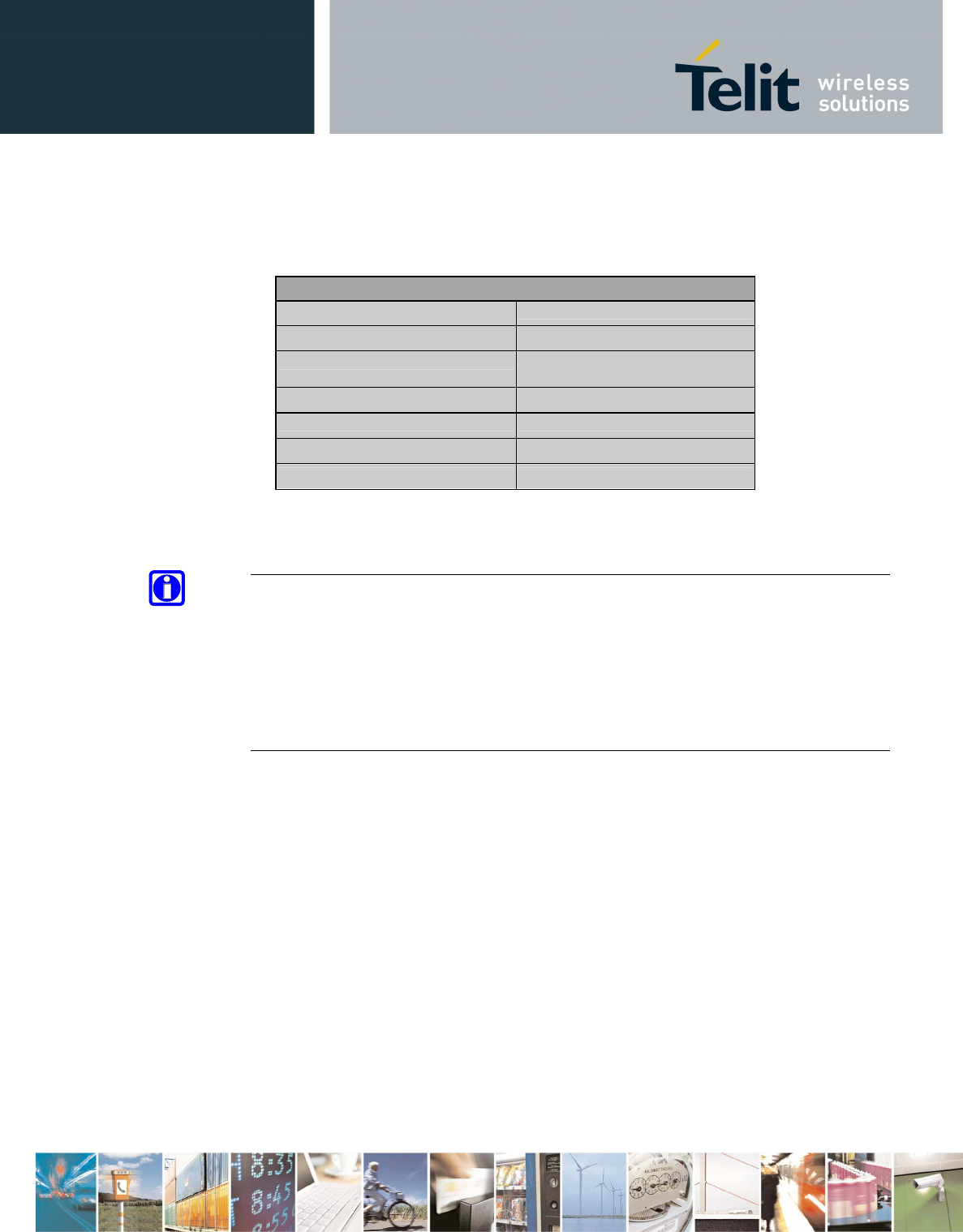
GE866-DUAL Hardware User Guide
1VV0301051 Rev. 2 – 2014-04-07
7
Reproduction forbidden without written authorization from Telit Communications S.p.A. - All Rights
Reserved. Page 51 of 82
Mod. 0805 2011-07 Rev.2
10.3.2. Output lines
EAR/Line-out Output
Differential line coupling Direct connection (V
DC
=1.7÷2.1V)
output load resistance ≥ 8 Ω
signal bandwidth 250÷3400Hz
(@ -3dB with default filter)
max. differential output voltage
1120 mV
pp
@3.14dBm0
(*)
differential output voltage 550mV
rms
@0dBm0 (*)
volume increment 2dB per step
volume steps 0..10
(*) in default condition: Output Volume = +20dB, Output
Attenuation = 0dB
TIP:
We suggest driving the load differentially; this kills all the
common mode noises (click and pop, for example), the output
swing will double (+6dB) and the big output coupling capacitor
will be avoided.
In order to get the maximum power output from the device, the
resistance of the tracks has to be negligible in comparison to
the load.
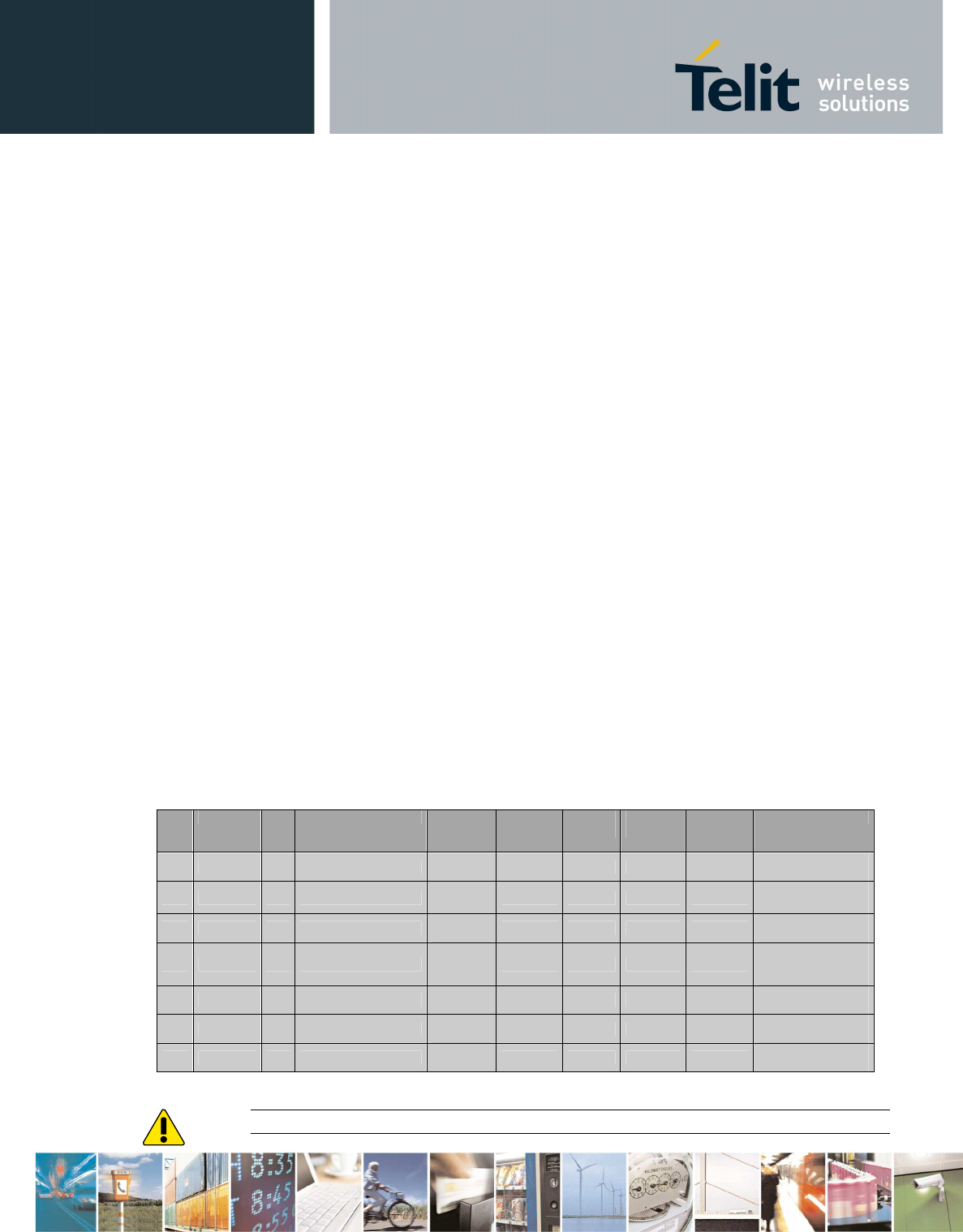
GE866-DUAL Hardware User Guide
1VV0301051 Rev. 2 – 2014-04-07
7
Reproduction forbidden without written authorization from Telit Communications S.p.A. - All Rights
Reserved. Page 52 of 82
Mod. 0805 2011-07 Rev.2
11. General Purpose I/O
The general purpose I/O pads can be configured to act in three
different ways:
• input
• output
• alternate function (internally controlled)
Input pads can be read; they report the digital value (high or
low) present on the pad at the read time.
Output pads can only be written or queried and set the value
of the pad output.
An alternate function pad is internally controlled by the
GE866-QUAD firmware and acts depending on the function
implemented.
For Logic levels please refer to chapter 8.
The following table shows the available GPIO on the GE866-
QUAD.
Pin Signal I/O Function Type Input /
output
current
Default
State ON_OFF
state State
during
Reset
Note
C5 GPIO_01 I/O Configurable GPIO CMOS
1.8V 1uA/1mA INPUT 0 0 Alternate function
DVI_WA0
C6 GPIO_02 I/O Configurable GPIO CMOS
1.8V 1uA/1mA INPUT 0 0
Alternate function
JDR and DVI_RX
D6 GPIO_03 I/O Configurable GPIO CMOS
1.8V 1uA/1mA INPUT 0 0 Alternate function
DVI_TX
D5 GPIO_04 I/O Configurable GPIO CMOS
1.8V 1uA/1mA INPUT 0 0 Alternate function
TX Disable and
DVI_TX
B5 GPIO_05 I/O Configurable GPIO CMOS
1.8V 1uA/1mA INPUT 0 0 Alternate function
RFTXMON
B4 GPIO_06 I/O Configurable GPIO CMOS
1.8V 1uA/1mA INPUT 0 0 Alternate function
ALARM / BUZZER
C4 GPIO_07 I/O Configurable GPIO CMOS
1.8V 1uA/1mA INPUT 0 0 Alternate function
STAT_LED
WARNING:
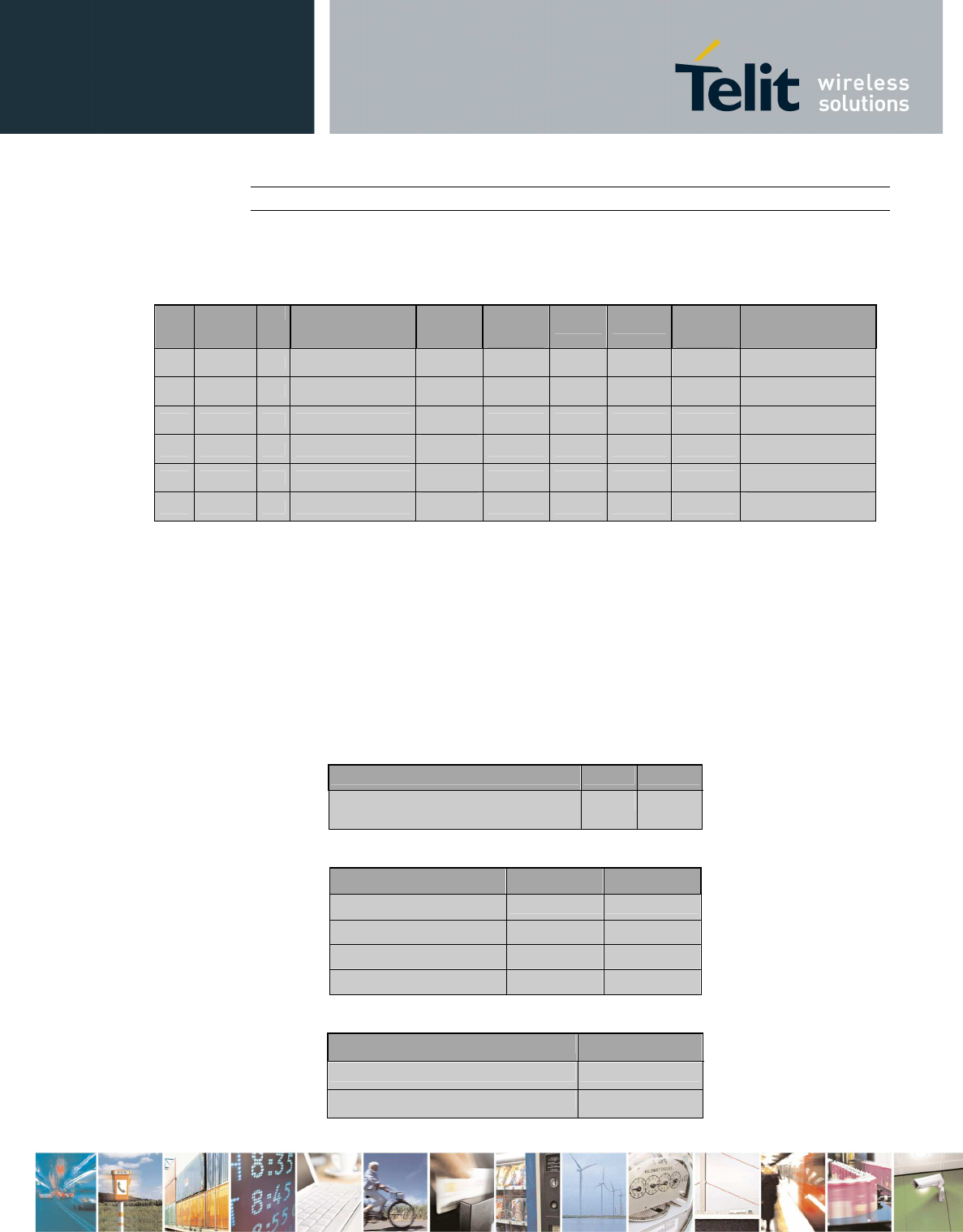
GE866-DUAL Hardware User Guide
1VV0301051 Rev. 2 – 2014-04-07
7
Reproduction forbidden without written authorization from Telit Communications S.p.A. - All Rights
Reserved. Page 53 of 82
Mod. 0805 2011-07 Rev.2
During power up the GPIOs may be subject to transient glitches.
Also the UART‘s control flow pins can be used as GPIO.
Pin Signal I/O Function Type Input /
output
current
Default
State ON_OFF
state State
during
Reset
Note
B2 GPO_A O Configurable GPO CMOS
1.8V 1uA/1mA INPUT 0 0 Alternate function
C109/DCD
B3 GPO_B O Configurable GPO CMOS
1.8V 1uA/1mA INPUT 0 0 Alternate function
C125/RING
A3 GPO_C O Configurable GPO CMOS
1.8V 1uA/1mA INPUT 0 0 Alternate function
C107/DSR
A2 GPI_E I Configurable GPI CMOS
1.8V 1uA/1mA INPUT 0 0 Alternate function
C108/DTR
A1 GPI_F I Configurable GPI CMOS
1.8V 1uA/1mA INPUT 0 0 Alternate function
C105/RTS
B1 GPO_D O Configurable GPO CMOS
1.8V 1uA/1mA INPUT 0 0 Alternate function
C106/CTS
11.1. GPIO Logic Levels
Where not specifically stated, all the interface circuits work
at 1.8V CMOS logic levels.
The following table shows the logic level specifications used
in the GE866-QUAD interface circuits:
Parameter Min Max
Input level on any digital pin
(CMOS 1.8) when on -0.3V
+2.1V
Level Min Max
Input high level 1.5V 1.9V
Input low level 0V 0.35V
Output high level 1.6V 1.9V
Output low level 0V 0.2V
Level Typical
Output Current 1mA
Input Current 1uA

GE866-DUAL Hardware User Guide
1VV0301051 Rev. 2 – 2014-04-07
7
Reproduction forbidden without written authorization from Telit Communications S.p.A. - All Rights
Reserved. Page 54 of 82
Mod. 0805 2011-07 Rev.2
11.2. Using a GPIO Pad as INPUT
The GPIO pads, when used as inputs, can be connected to a
digital output of another device and report its status,
provided this device has interface levels compatible with the
1.8V CMOS levels of the GPIO.
If the digital output of the device to be connected with the
GPIO input pad has interface levels different from the 1.8V
CMOS, then it can be buffered with an open collector
transistor with a 47K pull up to 1.8V.
NOTE:
In order to avoid a back powering effect it is recommended to
avoid having any HIGH logic level signal applied to the
digital pins of the GE866-QUAD when the module is powered OFF
or during an ON/OFF transition.
TIP:
The V_AUX / PWRMON pin can be used for input pull up reference
or/and for ON monitoring.
11.3. Using a GPIO Pad as OUTPUT
The GPIO pads, when used as outputs, can drive 1.8V CMOS
digital devices or compatible hardware. When set as outputs,
the pads have a push-pull output and therefore the pull-up
resistor may be omitted.
11.4. Using the RF Transmission Control GPIO4
The GPIO4 pin, when configured as RF Transmission Control
Input, permits to disable the Transmitter when the GPIO is set
to Low by the application.

GE866-DUAL Hardware User Guide
1VV0301051 Rev. 2 – 2014-04-07
7
Reproduction forbidden without written authorization from Telit Communications S.p.A. - All Rights
Reserved. Page 55 of 82
Mod. 0805 2011-07 Rev.2
In the design is necessary to add a resistor 47K pull up to
2.8V, this pull up must be switched off when the module is in
off condition.
11.5. Using the RFTXMON Output GPIO5
The GPIO5 pin, when configured as RFTXMON Output, is
controlled by the GE866-QUAD module and will rise when the
transmitter is active and fall after the transmitter activity
is completed.
There are 2 different modes for this function:
1) Active during the Call:
For example, if a call is started, the line will be HIGH
during all the conversation and it will be again LOW after
hanged up.
The line rises up 300ms before first TX burst and will became
again LOW from 500ms to 1s after last TX burst.
2) Active during the TX activity
The GPIO is following the TX bursts
Please refer to the AT User interface manual for additional
information on how to enable this function.
11.6. Using the ALARM/BUZZER output GPIO6
The GPIO6 has 2 alternate functions:
• ALARM
• BUZZER
The GPIO6 pad, when configured as Alarm Output, is controlled
by the GE866-QUAD module and will rise when the alarm starts
and fall after the issue of a dedicated AT command.
This output can be used to controlling microcontroller or
application at the alarm time.
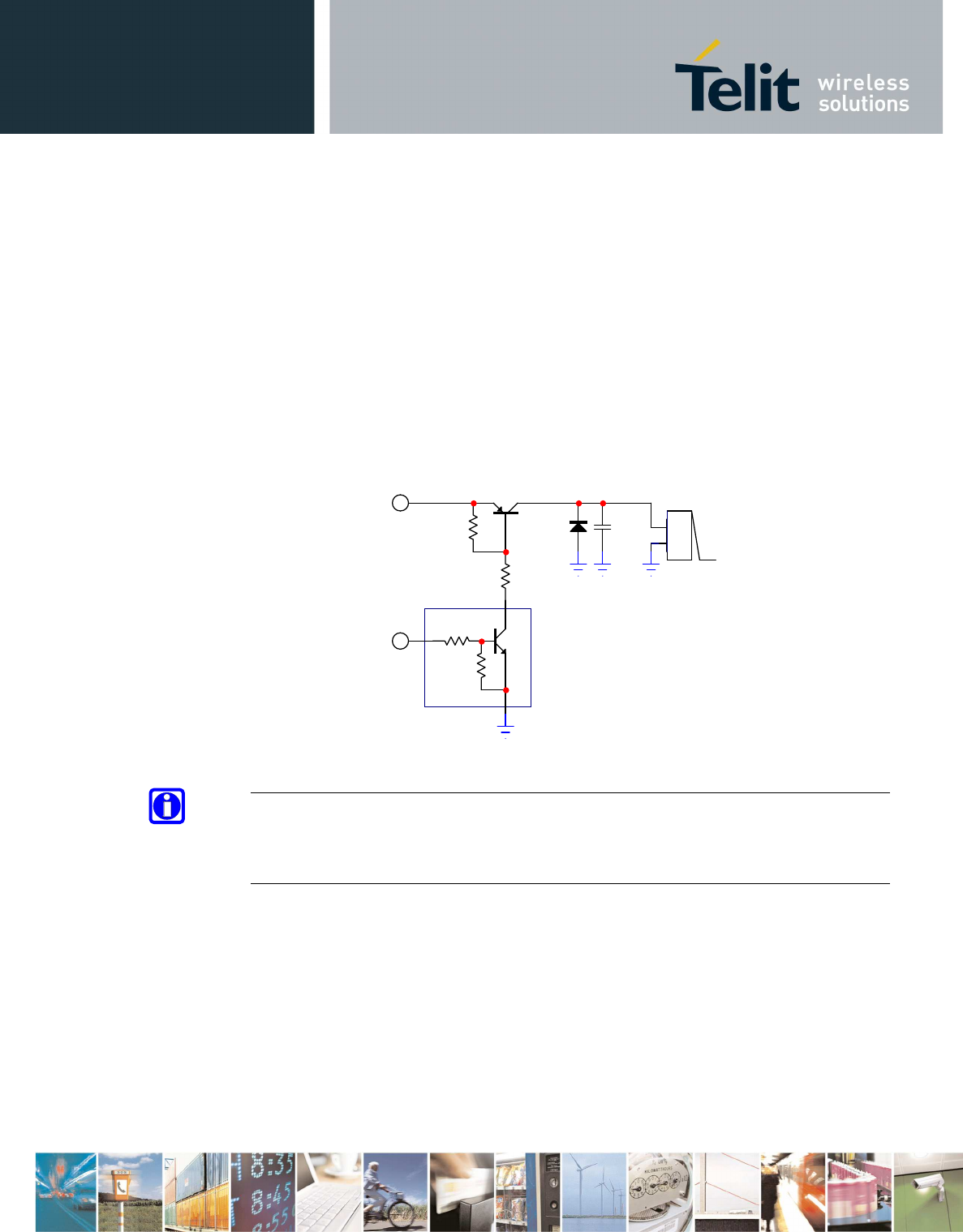
GE866-DUAL Hardware User Guide
1VV0301051 Rev. 2 – 2014-04-07
7
Reproduction forbidden without written authorization from Telit Communications S.p.A. - All Rights
Reserved. Page 56 of 82
Mod. 0805 2011-07 Rev.2
The GPIO6 pad, when configured as Buzzer Output, is controlled
by the GE866-QUAD module and will drive a Buzzer driver with
appropriate square waves.
This permits to your application to easily implement Buzzer
feature with ringing tones or melody played at the call
incoming, tone playing on SMS incoming or simply playing a
tone or melody when needed.
A sample interface scheme is included below to give you an
idea of how to interface a Buzzer to the GPIO6:
TR1
BCR141W
TR2
SMBT2907A
R1
4,7K
R2
1K
D1
D1N4148 C1
33pF +
-
+V buzzer
GPIO7
NOTE:
To correctly drive a buzzer a driver must be provided, its
characteristics depend on the Buzzer and for them refer to
your buzzer vendor
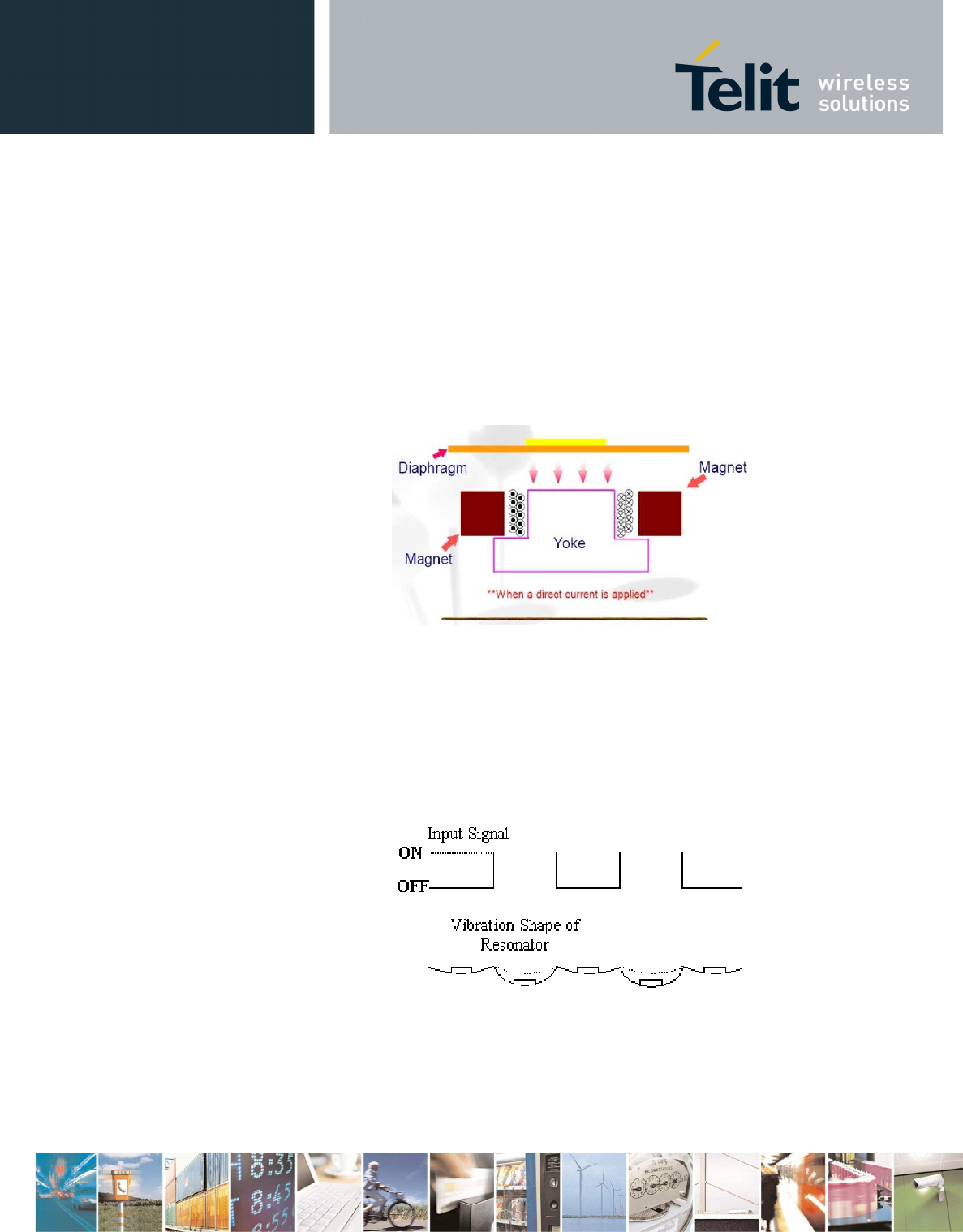
GE866-DUAL Hardware User Guide
1VV0301051 Rev. 2 – 2014-04-07
7
Reproduction forbidden without written authorization from Telit Communications S.p.A. - All Rights
Reserved. Page 57 of 82
Mod. 0805 2011-07 Rev.2
11.7. Magnetic Buzzer Concepts
11.7.1. Short Description
A magnetic Buzzer is a sound-generating device with a coil
located in the magnetic circuit consisting of a permanent
magnet, an iron core, a high permeable metal disk and a
vibrating diaphragm.
Drawing of the Magnetic Buzzer.
The disk and diaphragm are attracted to the core by the
magnetic field. When an oscillating signal is moved through
the coil, it produces a fluctuating magnetic field which
vibrates the diaphragm at the frequency of the drive signal.
Thus the sound is produced relative to the frequency applied.
Diaphragm movement.

GE866-DUAL Hardware User Guide
1VV0301051 Rev. 2 – 2014-04-07
7
Reproduction forbidden without written authorization from Telit Communications S.p.A. - All Rights
Reserved. Page 58 of 82
Mod. 0805 2011-07 Rev.2
11.7.2. Frequency Behaviour
The frequency behavior represents the effectiveness of the
reproduction of the applied signals. Because performance is
related to a square driving waveform (whose amplitude varies
from 0V to Vpp), if you modify the waveform (e.g. from square
to sinus) the frequency response will change.
11.7.3. Power Supply Influence
Applying a signal whose amplitude is different from that
suggested by the manufacturer, the performance change
following the rule “if resonance frequency fo increases,
amplitude decreases”.
Because resonance frequency depends on acoustic design, by
lowering the amplitude of the driving signal the response
bandwidth tends to become narrow, and vice versa.
Summarizing: V
pp
↑ f
o
↓ V
pp
↓ f
o
↑
The risk is that the fo could easily fall outside of new
bandwidth; consequently the SPL could be much lower than the
expected.
WARNING:
It is very important to respect the sense of the applied
voltage: never apply to the "-" pin a voltage more positive
than the "+" pin: if this happens, the diaphragm vibrates in
the opposite direction with a high probability to be expelled
from its physical position. This damages the device
permanently.
11.7.4. Working Current Influence
In the component data sheet you will find the value of MAX
CURRENT: this represents the maximum average current that can
flow at nominal voltage without current limitation. In other
words it is not the peak current, which could be twice or
three times higher. If driving circuitry does not support
these peak values, the SPL will never reach the declared level
or the oscillations will stop.
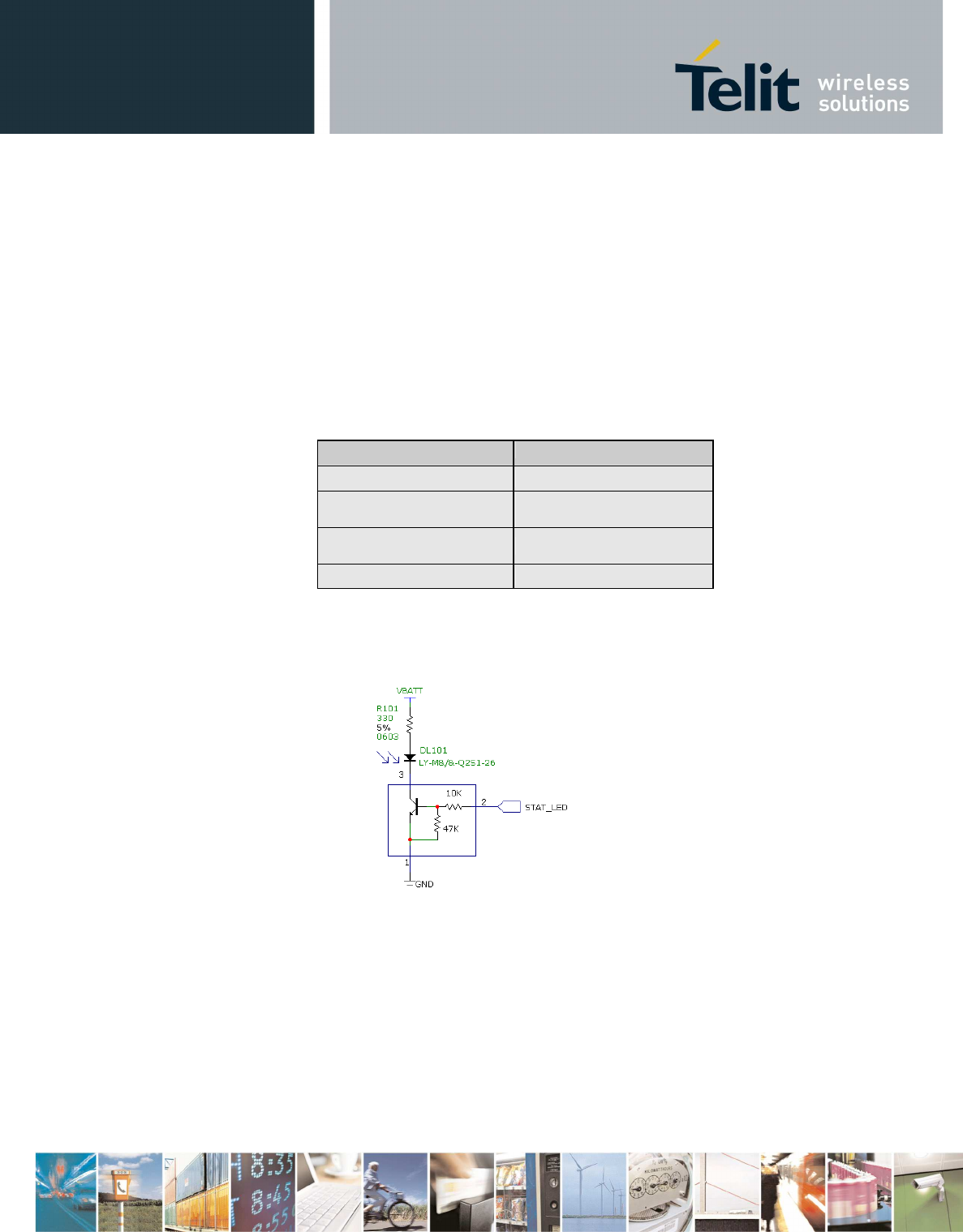
GE866-DUAL Hardware User Guide
1VV0301051 Rev. 2 – 2014-04-07
7
Reproduction forbidden without written authorization from Telit Communications S.p.A. - All Rights
Reserved. Page 59 of 82
Mod. 0805 2011-07 Rev.2
11.8. STAT LED Indication of network service
availability
The STAT_LED pin status shows information on the network
service availability and Call status.
In the GE866-QUAD modules, the STAT_LED usually needs an
external transistor to drive an external LED.
Therefore, the status indicated in the following table is
reversed with respect to the pin status.
LED status Device Status
Permanently off Device off
Fast blinking
(Period 1s, Ton 0,5s) Net search / Not registered /
turning off
Slow blinking
(Period 3s, Ton 0,3s) Registered full service
Permanently on a call is active
A schematic example could be:

GE866-DUAL Hardware User Guide
1VV0301051 Rev. 2 – 2014-04-07
7
Reproduction forbidden without written authorization from Telit Communications S.p.A. - All Rights
Reserved. Page 60 of 82
Mod. 0805 2011-07 Rev.2
11.9. SIMIN detect function
All the GPIO pins can be used as SIM DETECT input. The AT
Command used to enable the function is:
AT#SIMINCFG
Use the AT command AT#SIMDET=2 to enable the SIMIN detection
Use the AT command AT&W0 and AT&P0 to store the SIMIN
detection in the common profile.
For full details see AT Commands Reference Guide,
80000ST10025a.
NOTE:
Don’t use the SIM IN function on the same pin where the GPIO
function is enabled and vice versa!
11.10. RTC Bypass out
The VRTC pin brings out the Real Time Clock supply, which is
separate from the rest of the digital part, allowing having
only RTC going on when all the other parts of the device are
off.
To this power output a backup battery can be added in order to
increase the RTC autonomy during power off of the main battery
(power supply). NO Devices must be powered from this pin.
11.11. SIM Holder Implementation
Please refer to the related User Guide (SIM Holder Design
Guides, 80000NT10001a).
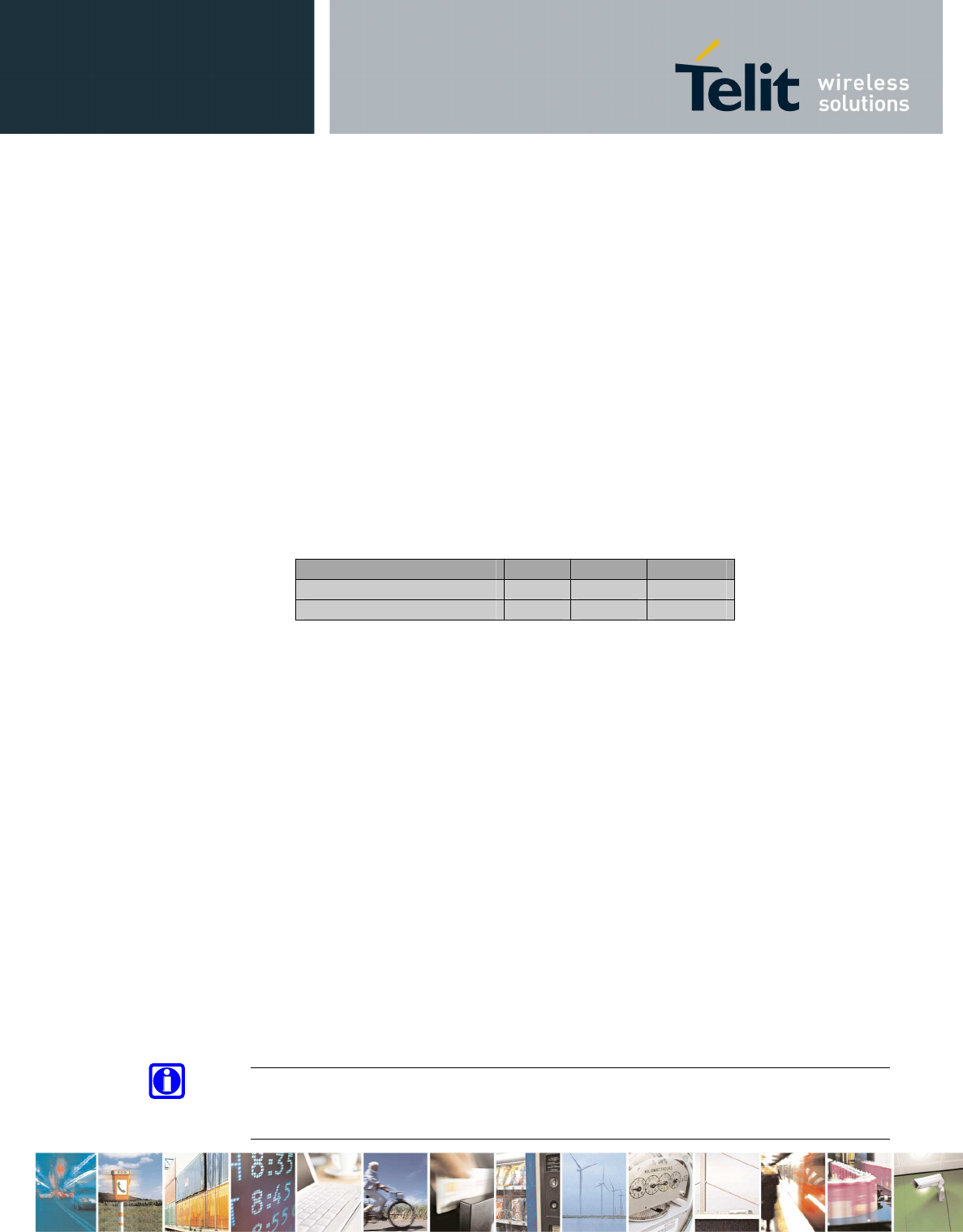
GE866-DUAL Hardware User Guide
1VV0301051 Rev. 2 – 2014-04-07
7
Reproduction forbidden without written authorization from Telit Communications S.p.A. - All Rights
Reserved. Page 61 of 82
Mod. 0805 2011-07 Rev.2
12. DAC and ADC section
12.1. DAC Converter
12.1.1. Description
The GE866-QUAD provides a Digital to Analog Converter. The
signal (named DAC_OUT) is available on pin E4 of the GE866-
QUAD.
The on board DAC is a 10 bit converter, able to generate an
analogue value based on a specific input in the range from 0
up to 1023. However, an external low-pass filter is necessary
Min Max Units
Voltage range (filtered)
0
1.8
Volt
Range 0 1023 Steps
The precision is 10 bits so, if we consider that the maximum
voltage is 2V, the integrated voltage could be calculated with
the following formula:
Integrated output voltage = (2 *value) / 1023
DAC_OUT line must be integrated (for example with a low band
pass filter) in order to obtain an analog voltage.
12.1.2. Enabling DAC
An AT command is available to use the DAC function.
The command is: AT#DAC= [<enable> [, <value>]]
<value> - scale factor of the integrated output voltage
(0..1023 - 10 bit precision)
it must be present if <enable>=1
Refer to SW User Guide or AT Commands Reference Guide for the
full description of this function.
NOTE:
The DAC frequency is selected internally. D/A converter must
not be used during POWERSAVING.
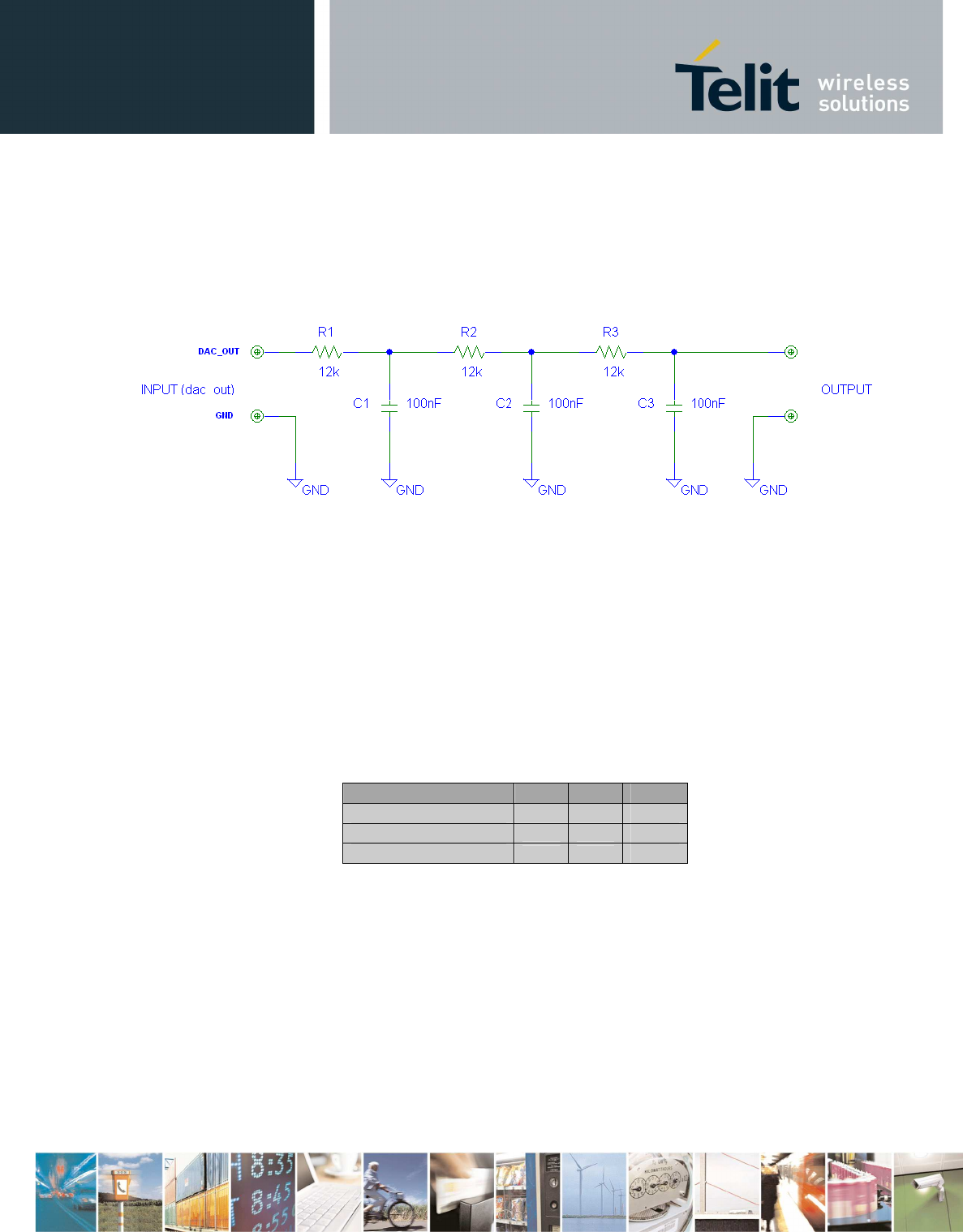
GE866-DUAL Hardware User Guide
1VV0301051 Rev. 2 – 2014-04-07
7
Reproduction forbidden without written authorization from Telit Communications S.p.A. - All Rights
Reserved. Page 62 of 82
Mod. 0805 2011-07 Rev.2
12.1.3. Low Pass Filter Example
12.2. ADC Converter
12.2.1. Description
The on board A/D converter is a 11-bit converter. It’s able to
read a voltage level in the range of 0÷2 volts applied on the
ADC pin input, store and convert it into 11 bit word.
Min
Max
Units
Input Voltage range
0 1.2
Volt
AD conversion
- 10
bits
Resolution
- > 1
mV
The GE866-QUAD module provides one Analog to Digital
Converters.
The input line is:
ADC_IN
Available on pin F4

GE866-DUAL Hardware User Guide
1VV0301051 Rev. 2 – 2014-04-07
7
Reproduction forbidden without written authorization from Telit Communications S.p.A. - All Rights
Reserved. Page 63 of 82
Mod. 0805 2011-07 Rev.2
12.2.2. Using ADC Converter
An AT command is available to use the ADC function.
The command is AT#ADC=1,2
The read value is expressed in mV
Refer to SW User Guide or AT Commands Reference Guide for the
full description of this function.
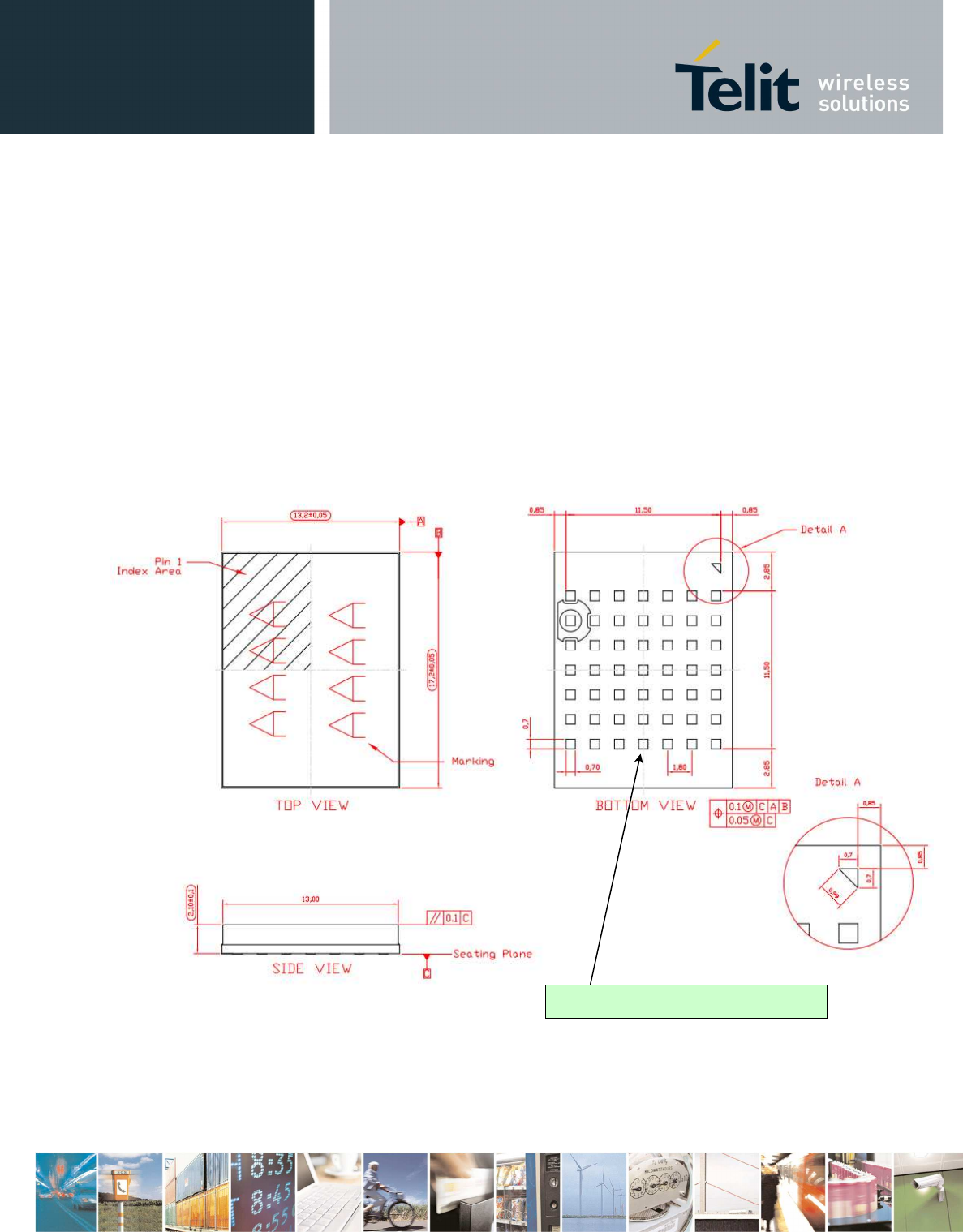
GE866-DUAL Hardware User Guide
1VV0301051 Rev. 2 – 2014-04-07
7
Reproduction forbidden without written authorization from Telit Communications S.p.A. - All Rights
Reserved. Page 64 of 82
Mod. 0805 2011-07 Rev.2
13. Mounting the GE866 on your Board
13.1. General
The GE866 modules have been designed in order to be compliant
with a standard lead-free SMT process.
13.2. Module finishing & dimensions
Dimensions in mm
Surface finishing Ni/Au for all solder pads
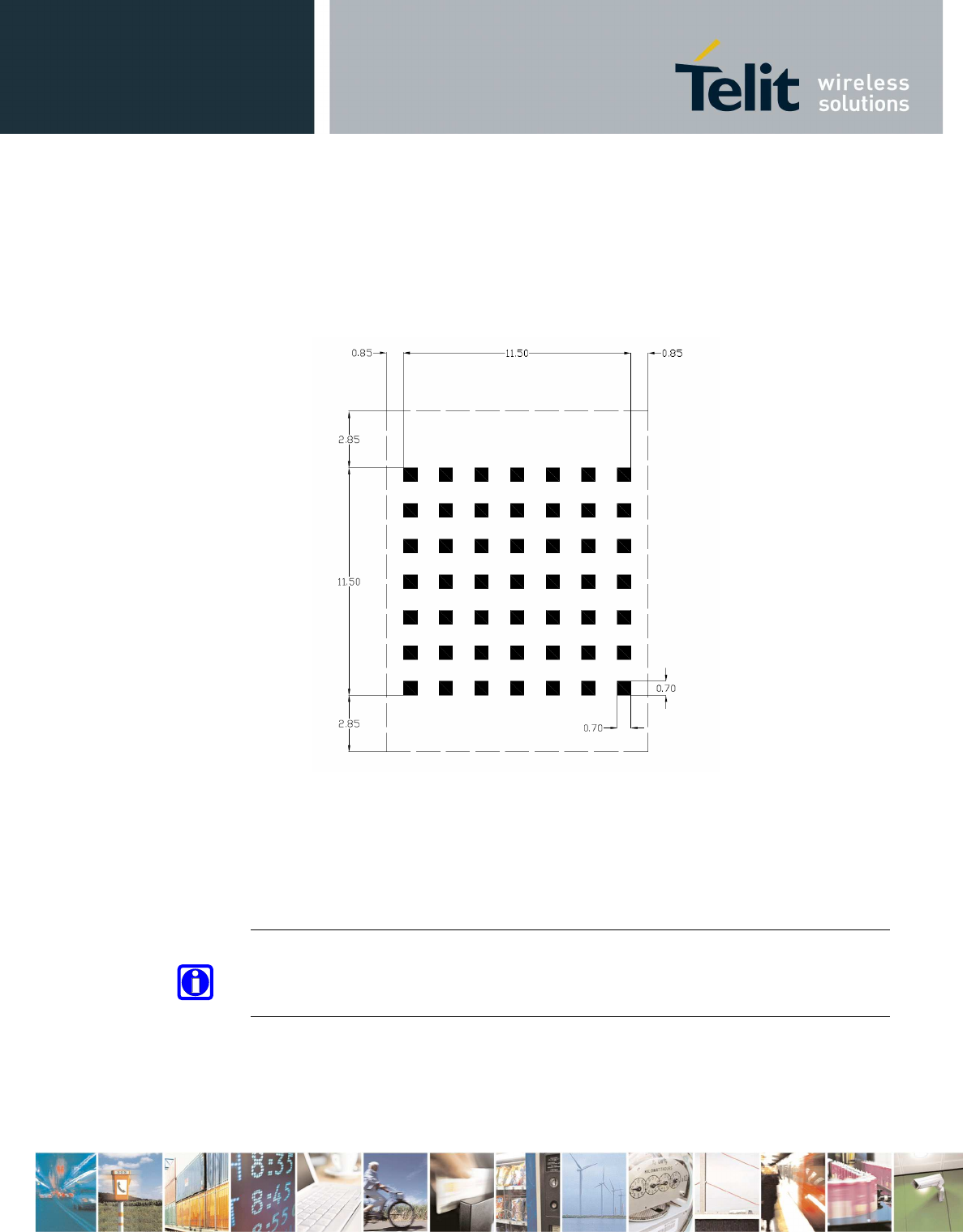
GE866-DUAL Hardware User Guide
1VV0301051 Rev. 2 – 2014-04-07
7
Reproduction forbidden without written authorization from Telit Communications S.p.A. - All Rights
Reserved. Page 65 of 82
Mod. 0805 2011-07 Rev.2
13.3. Recommended foot print for the
application (dimensions in mm):
In order to easily rework the GE866 is suggested to consider
on the application a 1.5 mm placement inhibit area around the
module.
It is also suggested, as common rule for an SMT component, to
avoid having a mechanical part of the application in direct
contact with the module.
NOTE:
In the customer application, the region under WIRING INHIBIT
(see figure above) must be clear from signal or ground paths
.
Top View
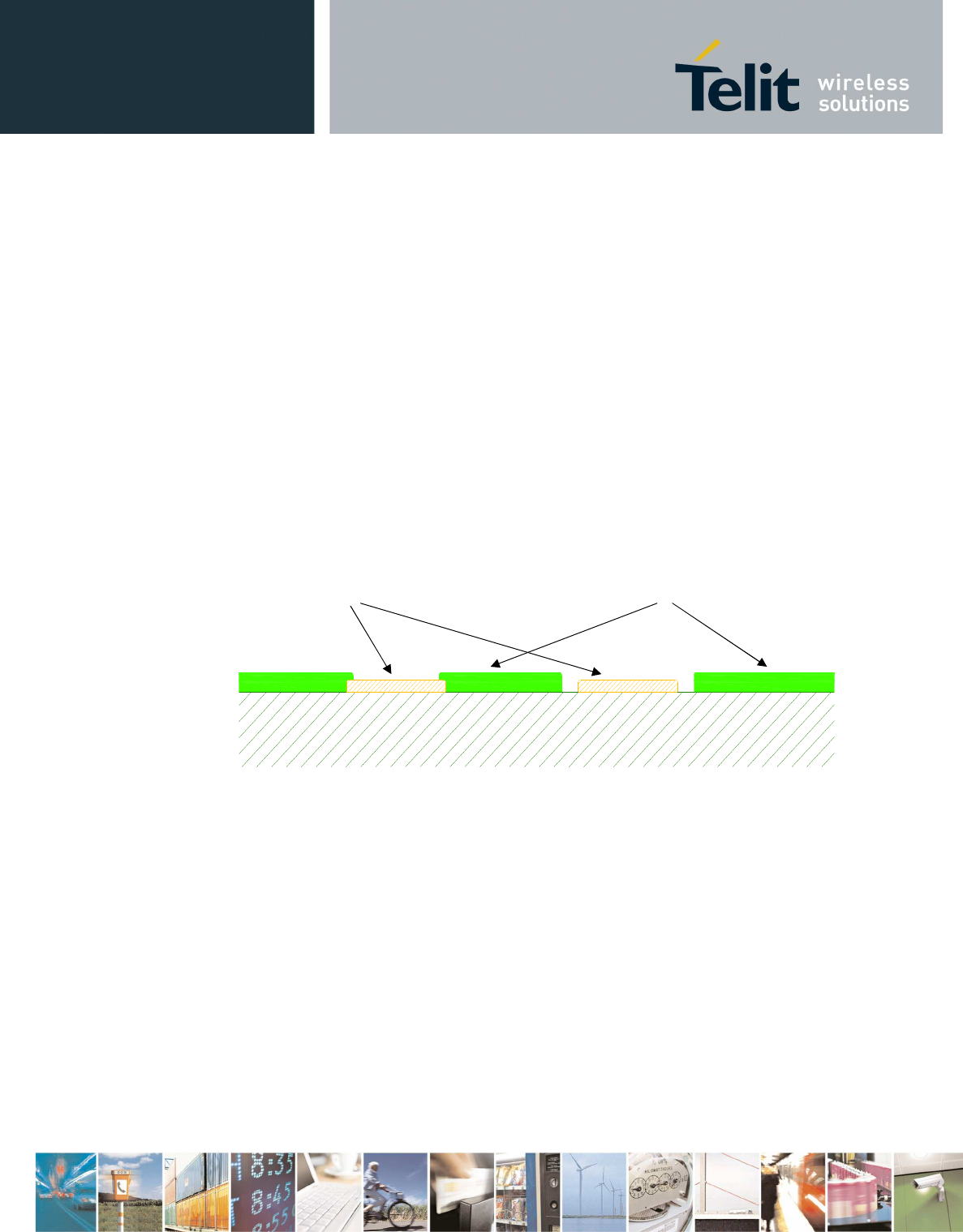
GE866-DUAL Hardware User Guide
1VV0301051 Rev. 2 – 2014-04-07
7
Reproduction forbidden without written authorization from Telit Communications S.p.A. - All Rights
Reserved. Page 66 of 82
Mod. 0805 2011-07 Rev.2
13.4. Stencil
Stencil’s apertures layout can be the same of the recommended
footprint (1:1), we suggest a thickness of stencil foil ≥ 120
µm.
13.5. PCB pad design
Non solder mask defined (NSMD) type is recommended for the
solder pads on the PCB.
PCB
Copper Pad
Pad
Solder Mask
SMD
(Solder Mask Defined)
NSMD
(Non Solder Mask Defined)
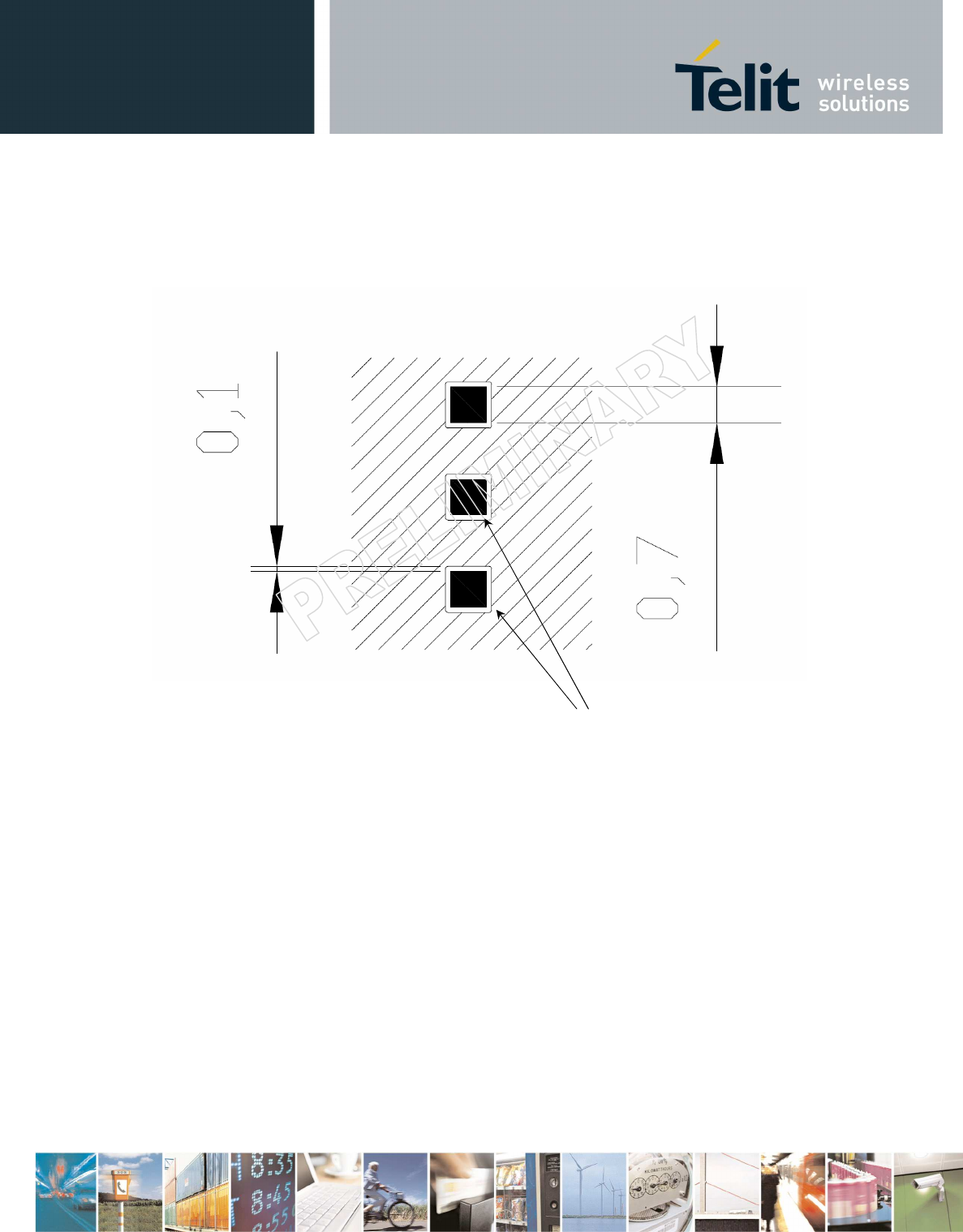
GE866-DUAL Hardware User Guide
1VV0301051 Rev. 2 – 2014-04-07
7
Reproduction forbidden without written authorization from Telit Communications S.p.A. - All Rights
Reserved. Page 67 of 82
Mod. 0805 2011-07 Rev.2
13.6. Recommendations for PCB pad dimensions
(mm):
Solder resist openings
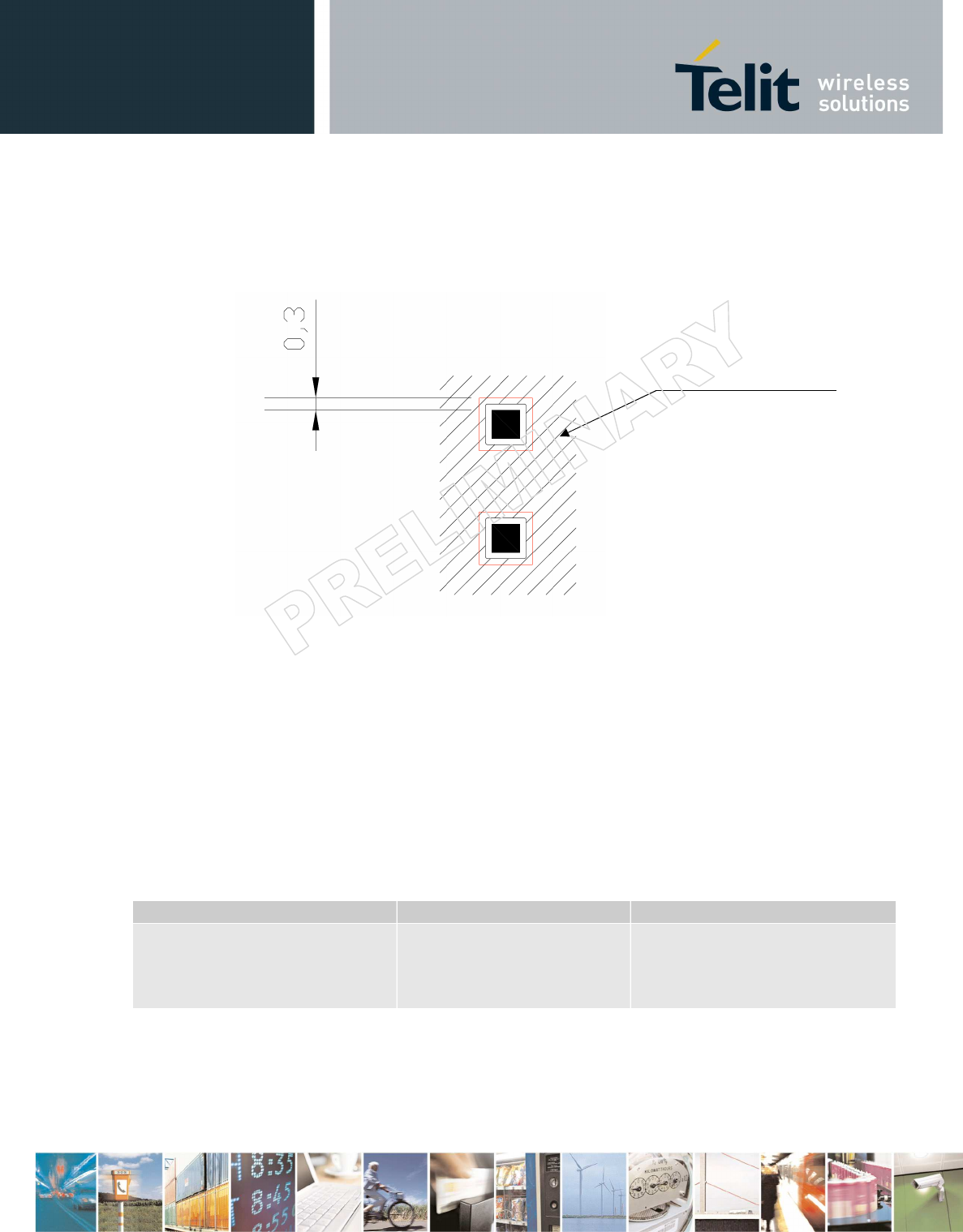
GE866-DUAL Hardware User Guide
1VV0301051 Rev. 2 – 2014-04-07
7
Reproduction forbidden without written authorization from Telit Communications S.p.A. - All Rights
Reserved. Page 68 of 82
Mod. 0805 2011-07 Rev.2
It is not recommended to place via or micro-via not covered by
solder resist in an area of 0,3 mm around the pads unless it
carries the same signal of the pad itself (see following
figure).
Holes in pad are allowed only for blind holes and not for
through holes.
Recommendations for PCB pad surfaces:
Finish Layer thickness [µm] Properties
Electro-less Ni /
Immersion Au 3 –7 / 0.05 – 0.15
good solder ability
protection,
high shear force values
The PCB must be able to resist the higher temperatures which
are occurring at the lead-free process. This issue should be
discussed with the PCB-supplier. Generally, the wettability of
Inhibit area for micro
-
via
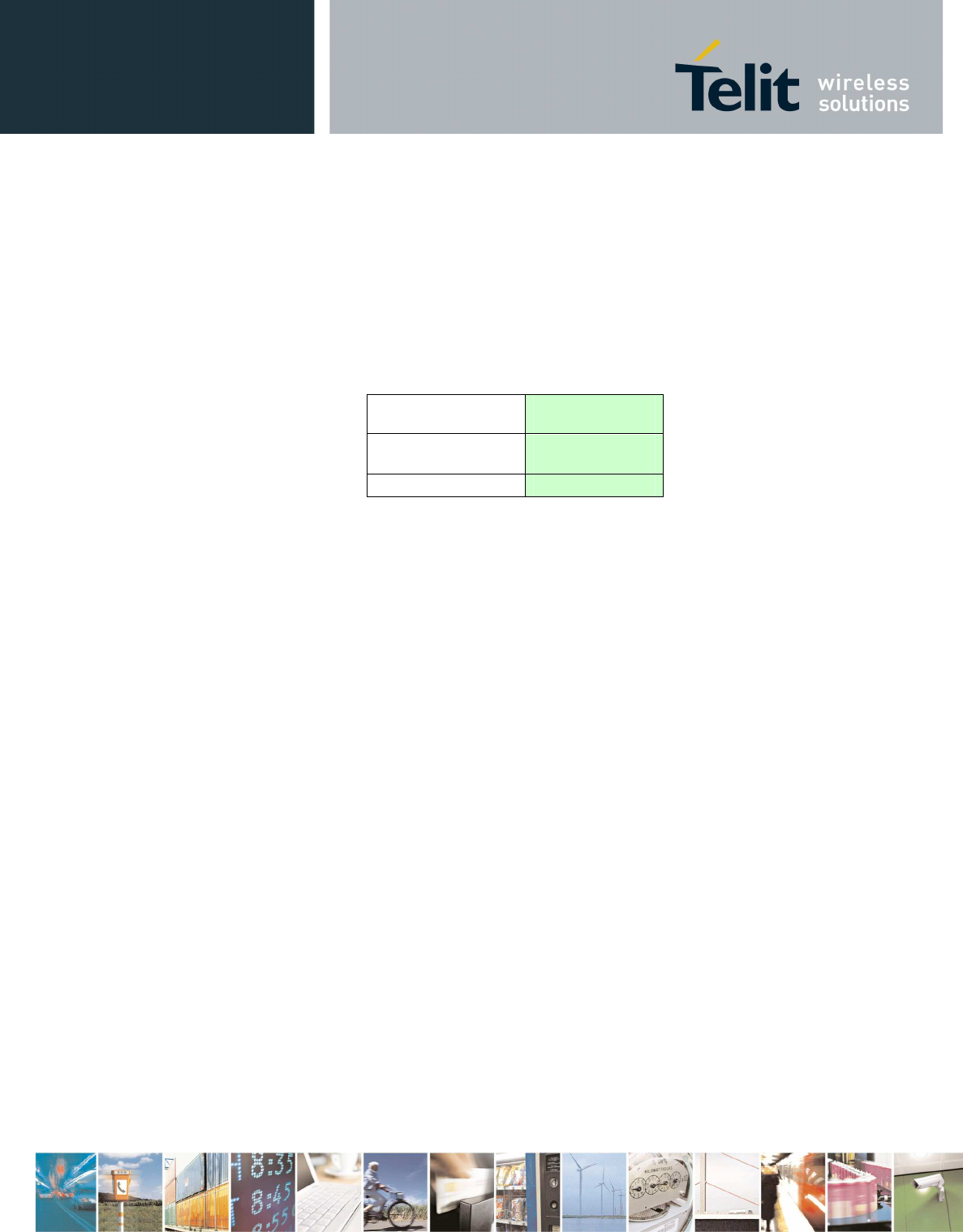
GE866-DUAL Hardware User Guide
1VV0301051 Rev. 2 – 2014-04-07
7
Reproduction forbidden without written authorization from Telit Communications S.p.A. - All Rights
Reserved. Page 69 of 82
Mod. 0805 2011-07 Rev.2
tin-lead solder paste on the described surface plating is
better compared to lead-free solder paste.
It is not necessary to panel the application PCB, however in
that case it is suggested to use milled contours and
predrilled board breakouts; scoring or v-cut solutions are not
recommended.
13.7. Solder paste
Lead free
Solder paste
Sn/Ag/Cu
We recommend using only “no clean” solder paste in order to
avoid the cleaning of the modules after assembly.
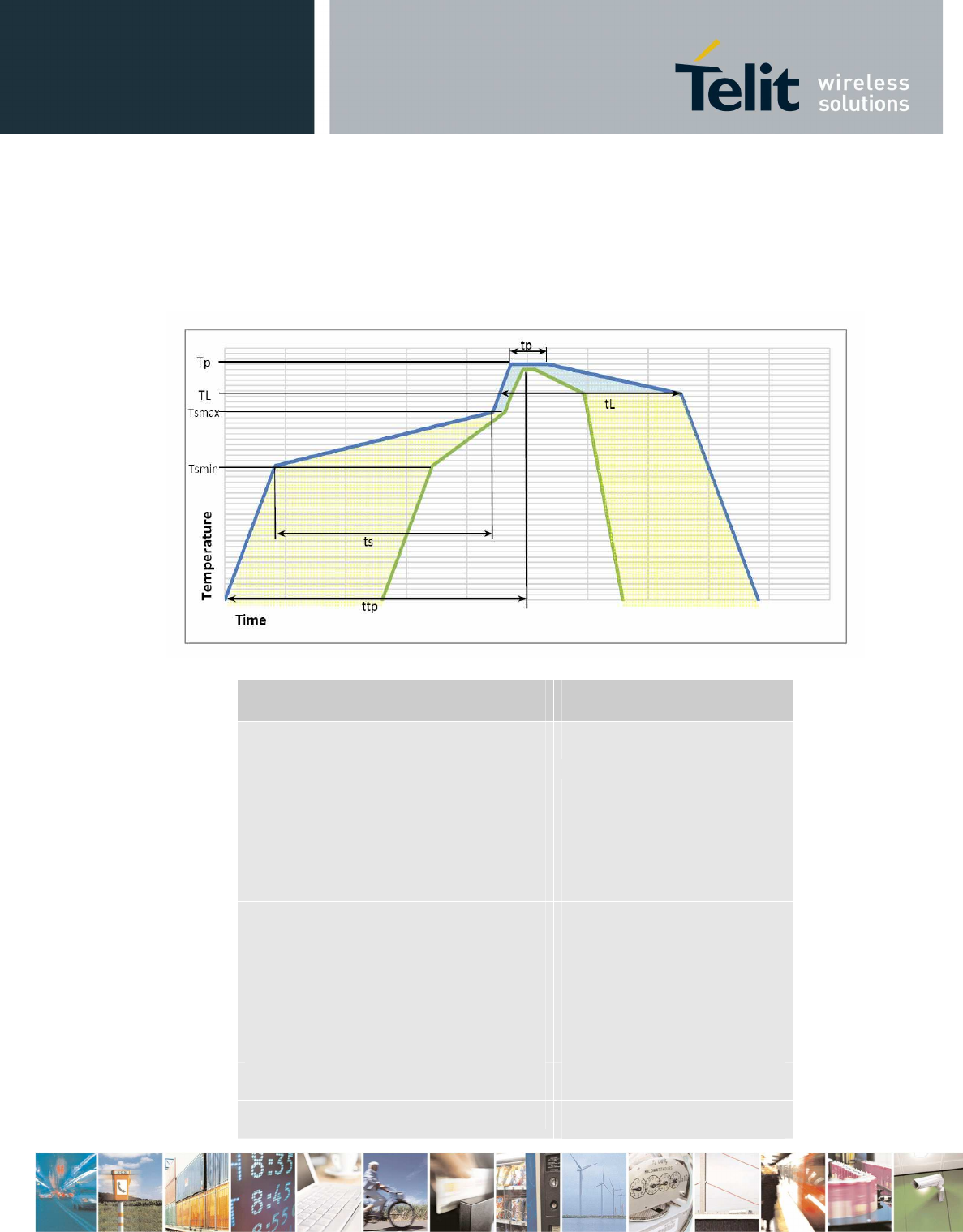
GE866-DUAL Hardware User Guide
1VV0301051 Rev. 2 – 2014-04-07
7
Reproduction forbidden without written authorization from Telit Communications S.p.A. - All Rights
Reserved. Page 70 of 82
Mod. 0805 2011-07 Rev.2
13.8. GE866 Solder reflow
Recommended solder reflow profile
Profile Feature Pb-Free Assembly
Average ramp-
up rate (TL to
TP)
3°C/second max
Preheat
– Temperature Min (Tsmin)
– Temperature Max (Tsmax)
– Time (min to max) (ts)
150°C
200°C
60-180 seconds
Tsmax to TL
– Ramp-up Rate
3°C/second max
Time maintained above:
– Temperature (TL)
– Time (tL)
217°C
60-150 seconds
Peak Temperature (Tp) 245 +0/-5°C
Time within 5°C of actual
10-30 seconds
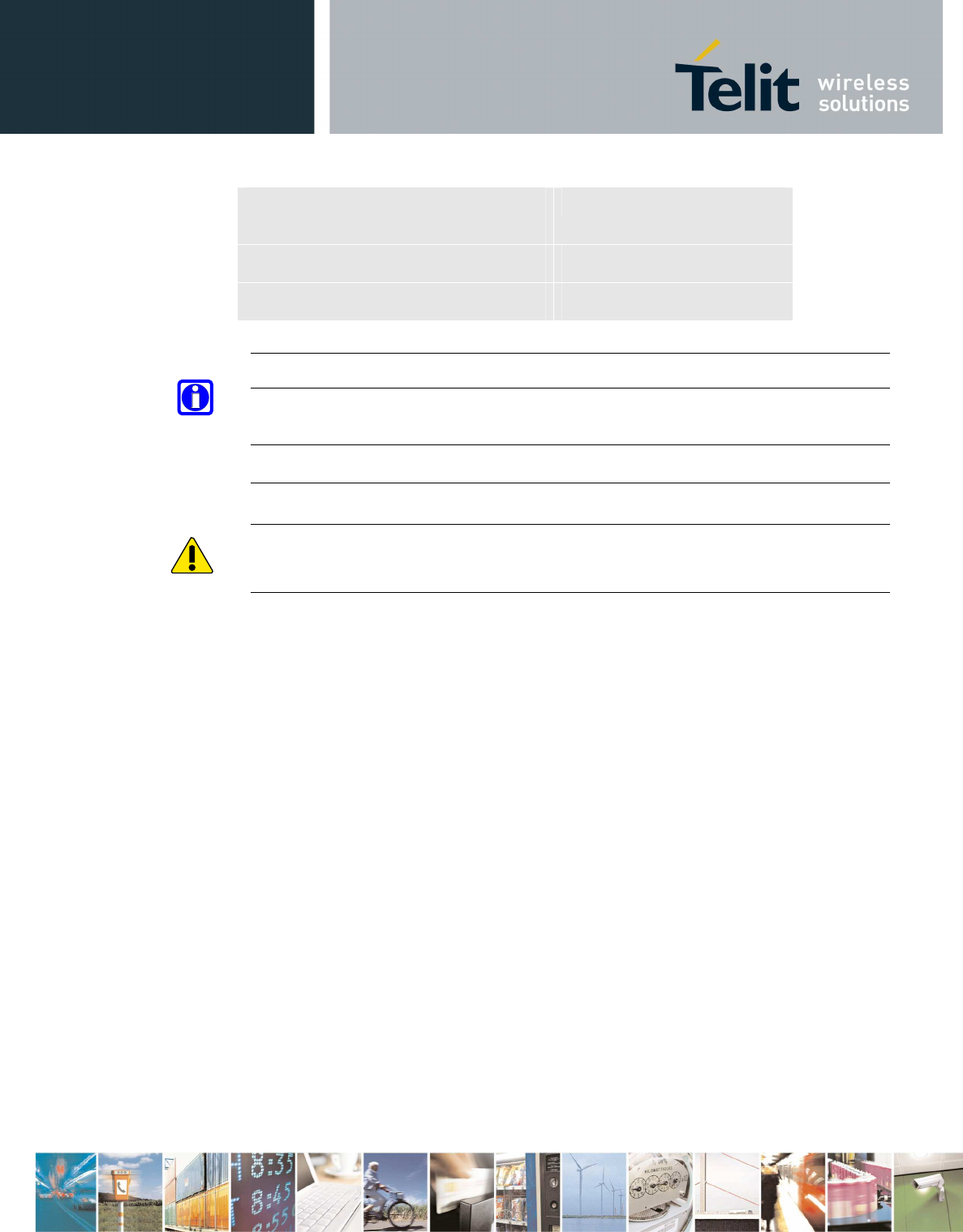
GE866-DUAL Hardware User Guide
1VV0301051 Rev. 2 – 2014-04-07
7
Reproduction forbidden without written authorization from Telit Communications S.p.A. - All Rights
Reserved. Page 71 of 82
Mod. 0805 2011-07 Rev.2
Peak
Temperature (tp)
Ramp-down Rate 6°C/second max.
Time 25°C to Peak Temperature 8 minutes max.
NOTE:
All temperatures refer to topside of the package, measured on
the package body surface
WARNING:
The GE866 module withstands one reflow process only
.

GE866-DUAL Hardware User Guide
1VV0301051 Rev. 2 – 2014-04-07
7
Reproduction forbidden without written authorization from Telit Communications S.p.A. - All Rights
Reserved. Page 72 of 82
Mod. 0805 2011-07 Rev.2
14. Packing system
14.1. Packing on reel
The GE866 modules are packaged on reels of 500 pieces each
(TBC).
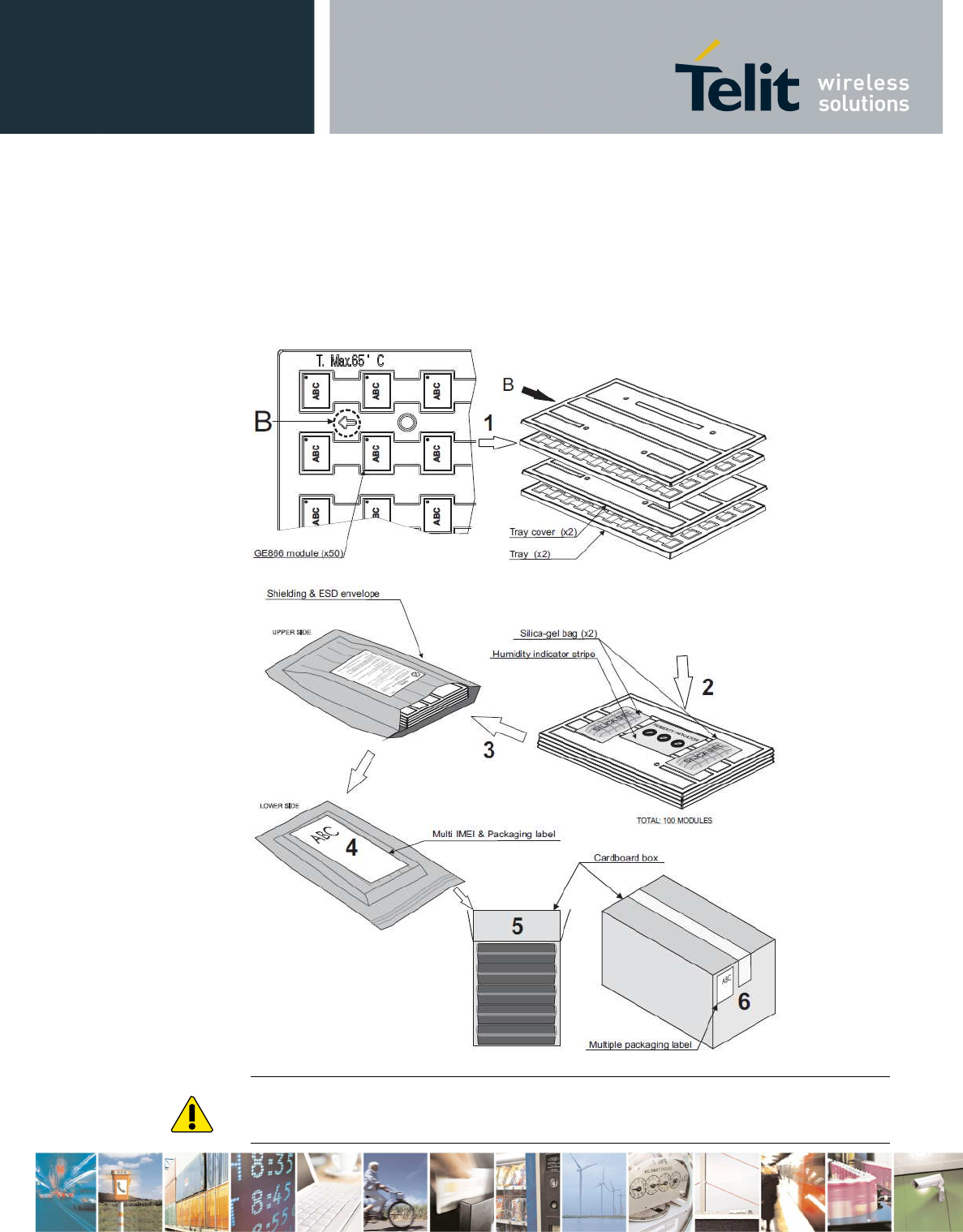
GE866-DUAL Hardware User Guide
1VV0301051 Rev. 2 – 2014-04-07
7
Reproduction forbidden without written authorization from Telit Communications S.p.A. - All Rights
Reserved. Page 73 of 82
Mod. 0805 2011-07 Rev.2
14.2. Packing on tray
The GE866 modules are packaged on trays of 50 pieces each when
small quantities are required (i.e. for test and evaluation
purposes). Trays are not designed to be used in SMT processes
for pick and place handling.
WARNING:
These trays can withstand at the maximum temperature of 65° C.

GE866-DUAL Hardware User Guide
1VV0301051 Rev. 2 – 2014-04-07
7
Reproduction forbidden without written authorization from Telit Communications S.p.A. - All Rights
Reserved. Page 74 of 82
Mod. 0805 2011-07 Rev.2
14.3. Moisture sensibility
The moisture sensitivity level of the Product is “3” according with
standard IPC/JEDEC J-STD-020, take care of all the relative requirements
for using this kind of components.
Moreover, the customer has to take care of the following conditions:
a) The shelf life of the Product inside of the dry bag is 12 months from
the bag seal date, when stored in a non-condensing atmospheric
environment of < 40°C and < 90% RH.
b) Environmental condition during the production: <= 30°C / 60% RH
according to IPC/JEDEC J-STD-033B.
c) The maximum time between the opening of the sealed bag and the reflow
process must be 168 hours if condition b) “IPC/JEDEC J-STD-033B paragraph
5.2” is respected.
d) Baking is required if conditions b) or c) are not respected
e) Baking is required if the humidity indicator inside the bag indicates
10% RH or more.

GE866-DUAL Hardware User Guide
1VV0301051 Rev. 2 – 2014-04-07
7
Reproduction forbidden without written authorization from Telit Communications S.p.A. - All Rights
Reserved. Page 75 of 82
Mod. 0805 2011-07 Rev.2
15. Conformity Assessment Issues
European Union - Directive 1999/5/EC
The GE866 QUAD complies with the essential requirements of the 1999/5/EC Directive.
Bulgarian С настоящето Telit Communications S.p.A. декларира, че Dual Band GSM/GPRS module
отговаря на съществените изисквания и другите приложими изисквания на Директива
1999/5/ЕС.
Czech Telit Communications S.p.A. tímto prohlašuje, že tento Dual Band GSM/GPRS module je ve
shodě se základními požadavky a dalšími příslušnými ustanoveními směrnice 1
999/5/ES.
Danish Undertegnede Telit Communications S.p.A. erklærer herved, at følgende udstyr Dual Band
GSM/GPRS module overholder de væsentlige krav og øvrige relevante krav i direktiv
1999/5/EF.
Dutch Hierbij verklaart Telit Communications S.p.A. dat het toestel Dual Band GSM/GPRS
module in overeenstemming is met de essentiële eisen en de andere relevante bepalingen van
richtlijn 1999/5/EG.
English Hereby, Telit Communications S.p.A., declares that this Dual Band GSM/GPRS module is in
compliance with the essential requirements and other relevant provisions of Directive
1999/5/EC.
Estonian Käesolevaga kinnitab Telit Communications S.p.A. seadme Dual Band GSM/GPRS module
vastavust direktiivi 1999/5/EÜ põhinõuetele ja nimetatud direktiivist tulenevatele teistele
asjakohastele sätetele.
German Hiermit erklärt Telit Communications S.p.A., dass sich das Gerät Dual Band GSM/GPRS
module in Übereinstimmung mit den grundlegenden Anforderungen und den übrigen
einschlägigen Bestimmungen der Richtlinie 1999/5/EG befindet.
Greek ΜΕ ΤΗΝ ΠΑΡΟΥΣΑ Telit Communications S.p.A. ∆ΗΛΩΝΕΙ ΟΤΙ Dual Band GSM/GPRS
module ΣΥΜΜΟΡΦΩΝΕΤΑΙ ΠΡΟΣ ΤΙΣ ΟΥΣΙΩ∆ΕΙΣ ΑΠΑΙΤΗΣΕΙΣ ΚΑΙ ΤΙΣ ΛΟΙΠΕΣ
ΣΧΕΤΙΚΕΣ ∆ΙΑΤΑΞΕΙΣ ΤΗΣ Ο∆ΗΓΙΑΣ 1999/5/ΕΚ.
Hungarian Alulírott, Telit Communications S.p.A. nyilatkozom, hogy a Dual Band GSM/GPRS module
megfelel a vonatkozó alapvetõ követelményeknek és az 1999/5/EC irányelv egyéb
elõírásainak.
Finnish Telit Communications S.p.A. vakuuttaa täten että Dual Band GSM/GPRS module tyyppinen
laite on direktiivin 1999/5/EY oleellisten vaatimusten ja sitä koskevien direktiivin muiden
ehtojen mukainen.
French Par la présente Telit Communications S.p.A. déclare que l'appareil Dual Band GSM/GPRS
module est conforme aux exigences essentielles et aux autres dispositions pertinentes de la
directive 1999/5/CE.
Icelandic Hér með lýsir Telit Communications S.p.A. yfir því að Dual Band GSM/GPRS module er í
samræmi við grunnkröfur og aðrar kröfur, sem gerðar eru í tilskipun 1999/5/EC
Italian Con la presente Telit Communications S.p.A. dichiara che questo modulo Dual Band
GSM/GPRS è conforme ai requisiti essenziali ed alle altre disposizioni pertinenti stabilite
dalla direttiva 1999/5/CE.
Latvian Ar šo Telit Communications S.p.A. deklarē, ka Dual Band GSM/GPRS module atbilst
Direktīvas 1999/5/EK būtiskajām prasībām un citiem ar to saistītajiem noteikumiem
.

GE866-DUAL Hardware User Guide
1VV0301051 Rev. 2 – 2014-04-07
7
Reproduction forbidden without written authorization from Telit Communications S.p.A. - All Rights
Reserved. Page 76 of 82
Mod. 0805 2011-07 Rev.2
Lithuanian Šiuo Telit Communications S.p.A. deklaruoja, kad šis Dual Band GSM/GPRS module
atitinka esminius reikalavimus ir kitas 1999/5/EB Direktyvos nuostatas.
Maltese Hawnhekk, Telit Communications S.p.A., jiddikjara li dan Dual Band GSM/GPRS module
jikkonforma mal-ħtiġijiet essenzjali u ma provvedimenti oħrajn relevanti li hemm fid-
Dirrettiva 1999/5/EC.
Norwegian Telit Communications S.p.A. erklærer herved at utstyret Dual Band GSM/GPRS module er i
samsvar med de grunnleggende krav og øvrige relevante krav i direktiv 1999/5/EF.
Polish Niniejszym Telit Communications S.p.A. oświadcza, że Dual Band GSM/GPRS module jest
zgodny z zasadniczymi wymogami oraz pozostałymi stosownymi postanowieniami
Dyrektywy 1999/5/EC
Portuguese Telit Communications S.p.A. declara que este Dual Band GSM/GPRS module está conforme
com os requisitos essenciais e outras disposições da Directiva 1999/5/CE.
Slovak Telit Communications S.p.A. týmto vyhlasuje, že Dual Band GSM/GPRS module spĺňa
základné požiadavky a všetky príslušné ustanovenia Smernice 1999/5/ES.
Slovenian Telit Communications S.p.A. izjavlja, da je ta Dual Band GSM/GPRS module v skladu z
bistvenimi zahtevami in ostalimi relevantnimi določili direktive 1999/5/ES.
Spanish Por medio de la presente Telit Communications S.p.A. declara que el Dual Band
GSM/GPRS module cumple con los requisitos esenciales y cualesquiera otras disposiciones
aplicables o exigibles de la Directiva 1999/5/CE.
Swedish Härmed intygar Telit Communications S.p.A. att denna Dual Band GSM/GPRS module står
I överensstämmelse med de väsentliga egenskapskrav och övriga relevanta bestämmelser
som framgår av direktiv 1999/5/EG.
In order to satisfy the essential requirements of 1999/5/EC Directive, GE866 QUAD module
is compliant with the following standards:
RF spectrum use (R&TTE art. 3.2) EN 301 511 V9.0.2
EMC (R&TTE art. 3.1b) EN 301 489-1 V1.9.2
EN 301 489-7 V1.3.1
Health & Safety (R&TTE art. 3.1a) EN 60950-1:2006 + A11:2009 + A1:2010 + A12:2011 +
AC:2011

GE866-DUAL Hardware User Guide
1VV0301051 Rev. 2 – 2014-04-07
7
Reproduction forbidden without written authorization from Telit Communications S.p.A. - All Rights
Reserved. Page 77 of 82
Mod. 0805 2011-07 Rev.2
15.1. GE866-QUAD
The conformity assessment procedure referred to in Article 10 and detailed in Annex IV of
Directive 1999/5/EC has been followed with the involvement of the following Notified Body:
AT4 wireless, S.A.
Parque Tecnologico de Andalucía
C/ Severo Ochoa 2
29590 Campanillas – Málaga
SPAIN
Notified Body No: 1909
Thus, the following marking is included in the product:
The full declaration of conformity can be found on the following address:
http://www.telit.com/
There is no restriction for the commercialisation of the GE866-QUAD module in all the
countries of the European Union.
Final product integrating this module must be assessed against essential requirements of the
1999/5/EC (R&TTE) Directive. It should be noted that assessment does not necessarily lead
to testing. Telit Communications S.p.A. recommends carrying out the following assessments:
RF spectrum use (R&TTE art. 3.2)
It will depend on the antenna used on the final product.
EMC (R&TTE art. 3.1b) Testing
Health & Safety (R&TTE art. 3.1a) Testing
1909
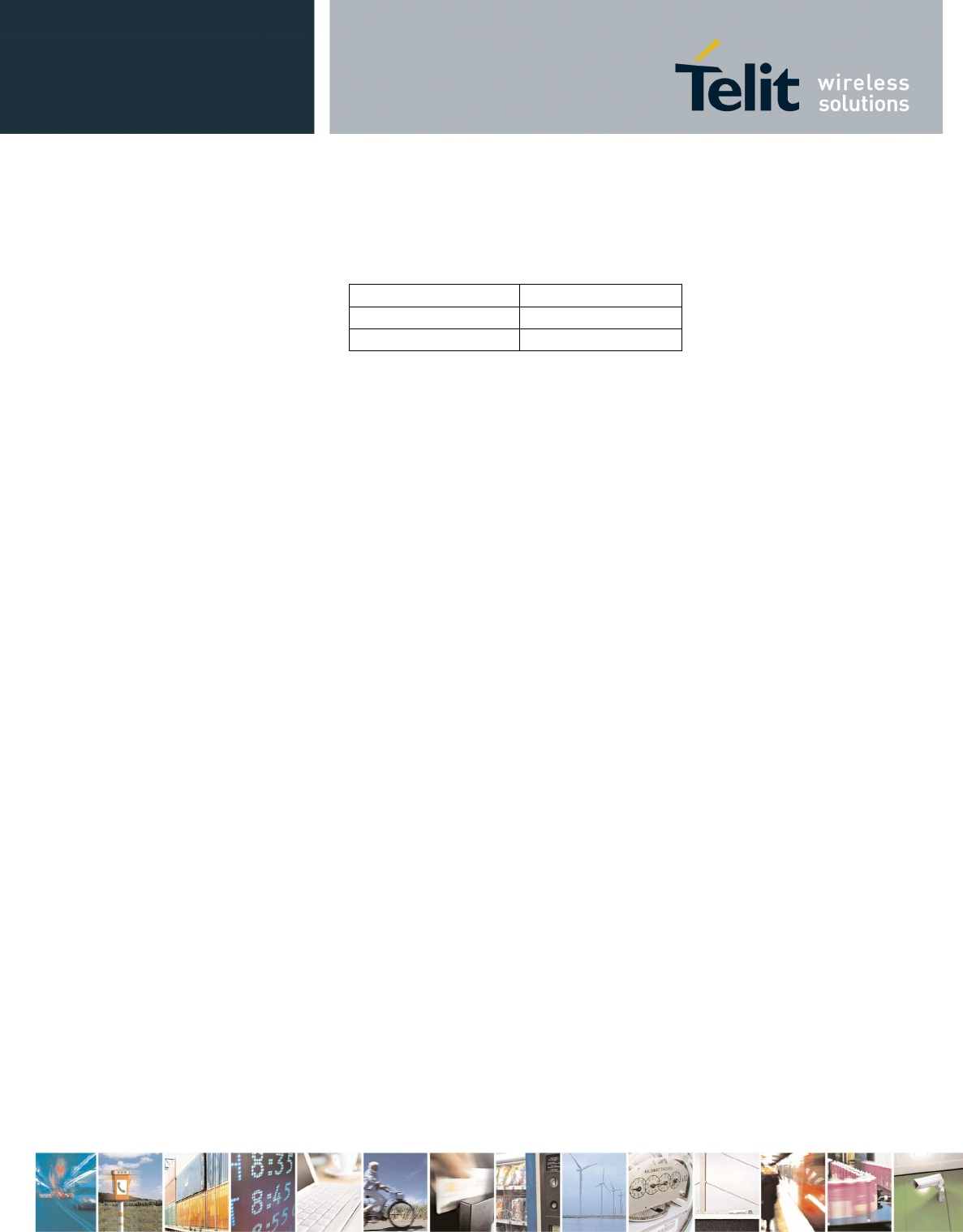
GE866-DUAL Hardware User Guide
1VV0301051 Rev. 2 – 2014-04-07
7
Reproduction forbidden without written authorization from Telit Communications S.p.A. - All Rights
Reserved. Page 78 of 82
Mod. 0805 2011-07 Rev.2
Using a maximum antenna gain less or equal to than the one shown in the table below, with a
minimum distance of 20 cm between the human body and antenna, the product complies with
the European Council Recommendation 1999/519/EC on the limitation of exposure of the
general public to electromagnetic fields (0 Hz to 300 GHz).
Frequency band Antenna gain
GSM 900 5.46 dBi
PCS 1800 11.34 dBi
This transmitter must not be co-located or operating in conjunction with any other antenna or
transmitter.
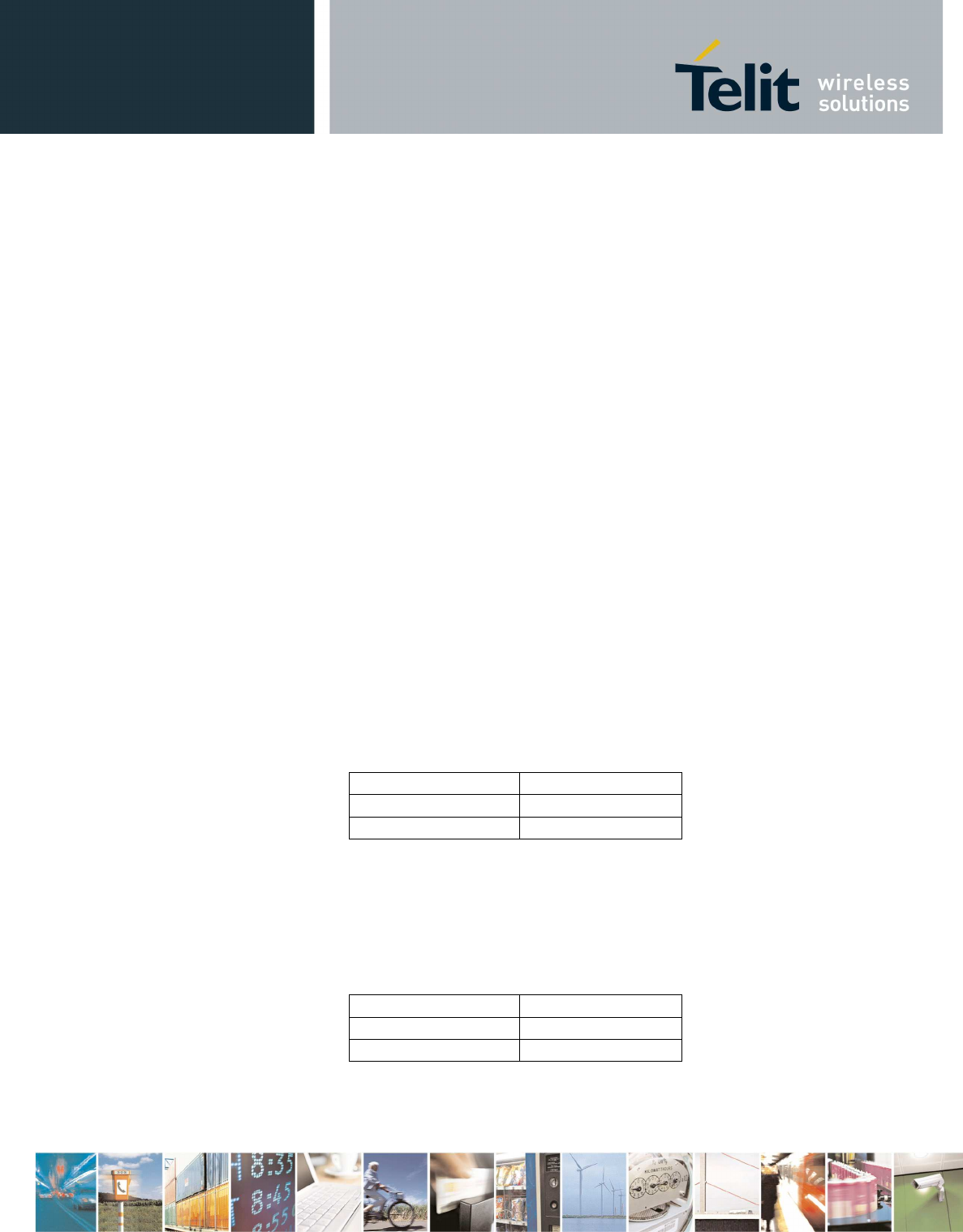
GE866-DUAL Hardware User Guide
1VV0301051 Rev. 2 – 2014-04-07
7
Reproduction forbidden without written authorization from Telit Communications S.p.A. - All Rights
Reserved. Page 79 of 82
Mod. 0805 2011-07 Rev.2
FCC/IC Regulatory notices
Modification statement
Telit has not approved any changes or modifications to this device by the user. Any changes
or modifications could void the user’s authority to operate the equipment.
Telit n’approuve aucune modification apportée à l’appareil par l’utilisateur, quelle qu’en soit
la nature. Tout changement ou modification peuvent annuler le droit d’utilisation de
l’appareil par l’utilisateur.
Interference statement
This device complies with Part 15 of the FCC Rules and Industry Canada licence-exempt
RSS standard(s). Operation is subject to the following two conditions: (1) this device may not
cause interference, and (2) this device must accept any interference, including interference
that may cause undesired operation of the device.
Le présent appareil est conforme aux CNR d'Industrie Canada applicables aux appareils
radio exempts de licence. L'exploitation est autorisée aux deux conditions suivantes : (1)
l'appareil ne doit pas produire de brouillage, et (2) l'utilisateur de l'appareil doit accepter
tout brouillage radioélectrique subi, même si le brouillage est susceptible d'en compromettre
le fonctionnement.
Wireless notice
This equipment complies with FCC and IC radiation exposure limits set forth for an
uncontrolled environment. The antenna should be installed and operated with minimum
distance of 20 cm between the radiator and your body. Antenna gain must be below:
Frequency band Antenna gain
GSM 850 6.42 dBi
PCS 1900 1.99 dBi
This transmitter must not be co-located or operating in conjunction with any other antenna or
transmitter.
Cet appareil est conforme aux limites d'exposition aux rayonnements de la IC pour un
environnement non contrôlé. L'antenne doit être installé de façon à garder une distance
minimale de 20 centimètres entre la source de rayonnements et votre corps. Gain de l'antenne
doit être ci-dessous:
Bande de fréquence Gain de l'antenne
GSM 850 6.42 dBi
PCS 1900 1.99 dBi
L'émetteur ne doit pas être colocalisé ni fonctionner conjointement avec à autre antenne ou
autre émetteur.

GE866-DUAL Hardware User Guide
1VV0301051 Rev. 2 – 2014-04-07
7
Reproduction forbidden without written authorization from Telit Communications S.p.A. - All Rights
Reserved. Page 80 of 82
Mod. 0805 2011-07 Rev.2
FCC Class B digital device notice
This equipment has been tested and found to comply with the limits for a Class B
digital device, pursuant to part 15 of the FCC Rules. These limits are designed to
provide reasonable protection against harmful interference in a residential installation.
This equipment generates, uses and can radiate radio frequency energy and, if not
installed and used in accordance with the instructions, may cause harmful interference
to radio communications. However, there is no guarantee that interference will not
occur in a particular installation. If this equipment does cause harmful interference to
radio or television reception, which can be determined by turning the equipment off
and on, the user is encouraged to try to correct the interference by one or more of the
following measures:
- Reorient or relocate the receiving antenna.
- Increase the separation between the equipment and receiver.
- Connect the equipment into an outlet on a circuit different from that to which the receiver
is connected.
- Consult the dealer or an experienced radio/TV technician for help.
Labelling Requirements for the Host device
The host device shall be properly labelled to identify the modules within the host device. The
certification label of the module shall be clearly visible at all times when installed in the host
device, otherwise the host device must be labelled to display the FCC ID and IC of the
module, preceded by the words "Contains transmitter module", or the word "Contains", or
similar wording expressing the same meaning, as follows:
Contains FCC ID: RI7GE866
Contains IC: 5131A-GE866
L'appareil hôte doit être étiqueté comme il faut pour permettre l'identification des modules qui
s'y trouvent. L'étiquette de certification du module donné doit être posée sur l'appareil hôte à
un endroit bien en vue en tout temps. En l'absence d'étiquette, l'appareil hôte doit porter une
étiquette donnant le FCC ID et le IC du module, précédé des mots « Contient un module
d'émission », du mot « Contient » ou d'une formulation similaire exprimant le même sens,
comme suit :
Contient FCC ID: RI7GE866
Contient IC: 5131A-GE866
CAN ICES-3 (B) / NMB-3 (B)
This Class B digital apparatus complies with Canadian ICES-003.
Cet appareil numérique de classe B est conforme à la norme canadienne ICES-003.

GE866-DUAL Hardware User Guide
1VV0301051 Rev. 2 – 2014-04-07
7
Reproduction forbidden without written authorization from Telit Communications S.p.A. - All Rights
Reserved. Page 81 of 82
Mod. 0805 2011-07 Rev.2
16. Safety Recommendations
READ CAREFULLY
Be sure the use of this product is allowed in the country and in the environment required. The
use of this product may be dangerous and has to be avoided in the following areas:
• Where it can interfere with other electronic devices in environments such as hospitals,
airports, aircrafts, etc.
• Where there is risk of explosion such as gasoline stations, oil refineries, etc. It is
responsibility of the user to enforce the country regulation and the specific
environment regulation.
Do not disassemble the product; any mark of tampering will compromise the warranty
validity. We recommend following the instructions of the hardware user guides for a correct
wiring of the product. The product has to be supplied with a stabilized voltage source and the
wiring has to be conforming to the security and fire prevention regulations. The product has to
be handled with care, avoiding any contact with the pins because electrostatic discharges may
damage the product itself. Same cautions have to be taken for the SIM, checking carefully the
instruction for its use. Do not insert or remove the SIM when the product is in power saving
mode.
The system integrator is responsible of the functioning of the final product; therefore, care has
to be taken to the external components of the module, as well as of any project or installation
issue, because the risk of disturbing the GSM network or external devices or having impact
on the security. Should there be any doubt, please refer to the technical documentation and the
regulations in force. Every module has to be equipped with a proper antenna with specific
characteristics. The antenna has
to be installed with care in order to avoid any interference with other electronic devices and
has to guarantee a minimum distance from the body (20 cm). In case of this requirement
cannot be satisfied, the system integrator has to assess the final product against the SAR
regulation.
The European Community provides some Directives for the electronic equipments
introduced on the market. All the relevant information’s are available on the European
Community website:
http://ec.europa.eu/enterprise/sectors/rtte/documents/
The text of the Directive 99/05 regarding telecommunication equipments is available,
while the applicable Directives (Low Voltage and EMC) are available at:
http://ec.europa.eu/enterprise/sectors/electrical/
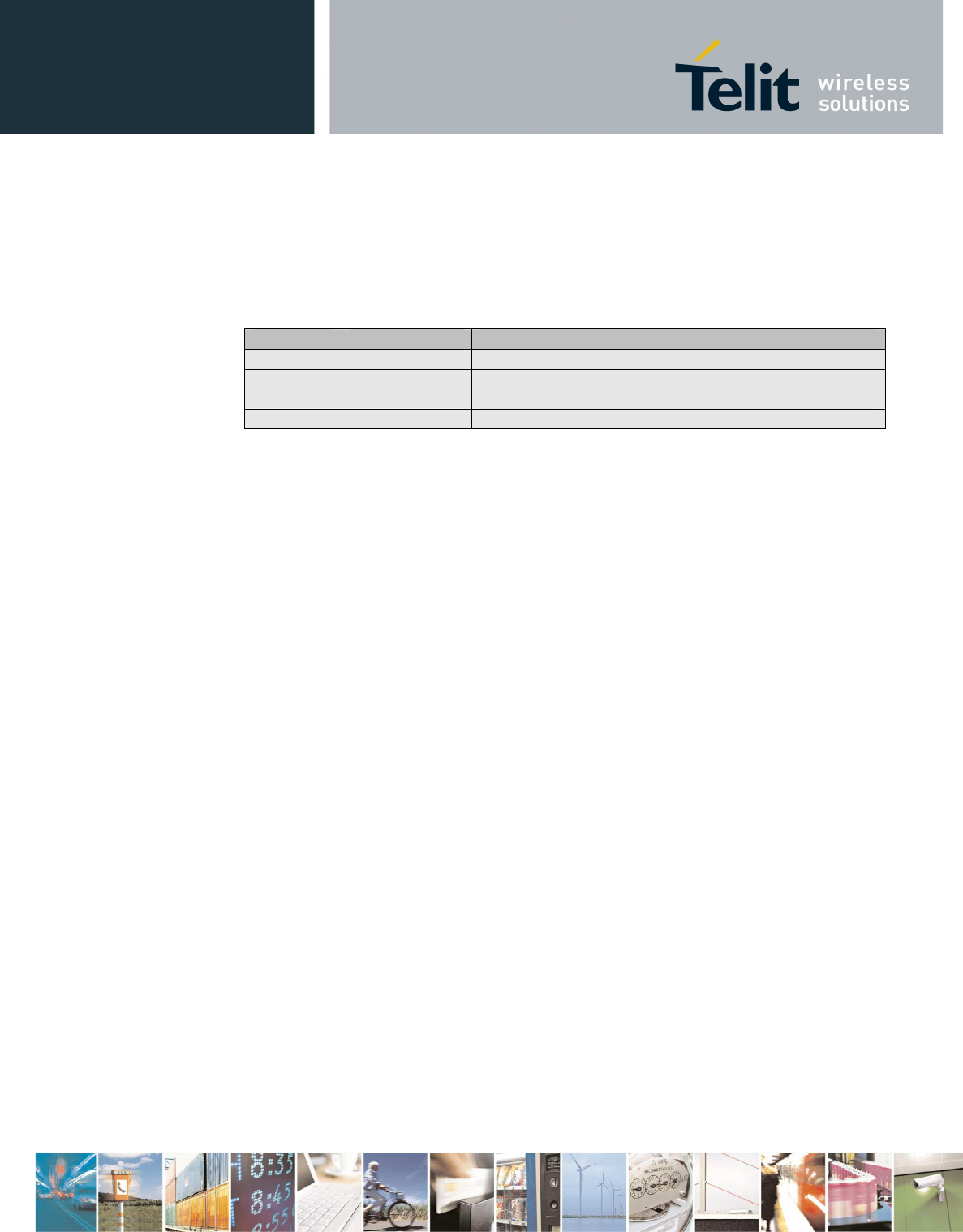
GE866-DUAL Hardware User Guide
1VV0301051 Rev. 2 – 2014-04-07
7
Reproduction forbidden without written authorization from Telit Communications S.p.A. - All Rights
Reserved. Page 82 of 82
Mod. 0805 2011-07 Rev.2
17. Document History
Revision Date Changes
Rev. 0 2013-10-02 First issue
Rev. 1 2014-02-07 Updated VRTC voltage, power consumption and packing
system
Rev.2 2014-03-03 Added par.15